- Mugs & Spoons
- Eclipse Collection
- Pre-Built Meal Kits
- Build Your Own Meal Kit
- Gluten Free
- Peanut Free
- Tree Nut Free
- High Calorie
- Blog: Inside The Pantry
- In the Press
- Our History
- Partners & Community
- Sustainability
- instagram Instagram
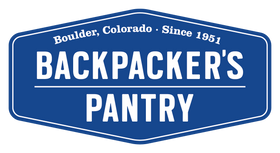

The Best Foods to Pack for Your Next Hunting Trip - Meal Ideas & More

A hunting trip is not just about the pursuit of game; it's a communion with nature, an escape from the daily grind, and an experience that calls for endurance, patience, and strategy. And just as you wouldn't venture out without your essential gear, you shouldn't overlook the vital role of nutrition on the hunt.
A successful hunting expedition requires both physical stamina and sharp mental focus—both of which are fueled by what you eat. Whether you're perched in a tree stand for hours or trekking through challenging terrain, the right sustenance can make all the difference. In this blog, we'll dive into the best food options to pack for your hunting trip, ensuring you remain energized, satisfied, and ready for whatever the wilderness throws your way. Prepare for a culinary adventure as thrilling as the hunt itself!
The Best Hunting Breakfasts
Often referred to as the most important meal of the day, it’s easy to overlook breakfast, especially if you’re striking out in the wee hours of the morning. With this in mind, we’ve suggested both warm and comforting breakfasts and quick and easy snacks for when you’re up-and-at-’em.
- Instant Oatmeal with Nuts & Dried Fruits : A quick, warm, and energy-rich option. Add some nuts like almonds or walnuts for extra protein and healthy fats. Dried fruits like cranberries or raisins can sweeten the mix and provide quick energy. Or, sub for an “overnight oats” preparation to make ahead.
- Whole Grain Wraps with Peanut or Almond Butter : Spread your favorite nut butter on a whole grain wrap and roll it up for a portable, protein-filled breakfast. These are great for ont eh go and can be prepped ahead of time.
- Pre-made Breakfast Burritos: For a more full and filling hunting breakfast, make these before you head out. Fill tortillas with scrambled eggs, black beans, cheese, and maybe some precooked sausage or bacon. Wrap them tightly in foil and store them in a cooler. Reheat them over a campfire or portable stove.
- Greek Yogurt with Granola: If you have a cooler, pack some Greek yogurt. It's high in protein and can be topped with granola, peanut butter, and fruits for added energy, texture, and flavor.
- Freeze-Dried Meals: Go gourmet while only building some water. From scrambles to oatmeal , these meals are incredibly easy to prepare: just add boiling water, wait a few minutes, and your meal is ready to eat. They are packed with the necessary nutrients to kickstart your day and sustain energy levels. Additionally, their compact packaging ensures they won't take up much space in your backpack. Pick an option that appeals to your taste buds and meets your energy requirements - there are plenty!

The Best Hunting Lunches
It may be easy to rely on protein bars and small snacks, but packing a proper lunch will help you stay fueled and focused throughout your day. Looking for more options? Check out our post on the best backpacking lunches .
- Sandwiches or Wraps: Use whole grain or high-protein tortillas and fill with lean meats (like turkey or chicken), cheese, lettuce, and other veggies. Remember to pack condiments separately to avoid sogginess.
- Tuna or Chicken Pouches: These are lightweight and packed with protein. You can eat them straight from the pouch or mix them with some mayo packets and relish for a quick salad. Pair with whole-grain crackers.
- Jerky and Cheese: Pairing beef or turkey jerky with hard cheeses (like cheddar or gouda) can be a protein-rich and satisfying lunch.
- Freeze-Dried Meals : Similar to breakfast, there's a plethora of freeze-dried lunch options available, from chicken and rice dishes to hearty soups and chili. Simply add hot water, wait, and eat.
The Best Hunting Dinners
When planning dinner, think about ease of preparation, especially if you've had a taxing day. Having a mix of quick-to-prepare and more elaborate options can help you choose based on how you feel each day. And, of course, always remember to carry enough water for both drinking and cooking, ensuring you're well-hydrated and properly nourished for the next day's adventures.
- Freeze-Dried Meals : An extensive range of flavors and meals are available, from beef stroganoff to pad thai . Just add boiling water, and within minutes, you have a hot, substantial meal.
- Pasta: Lightweight and quick to cook, pasta is a great option. Pair it with pre-made sauce pouches, veggies, and perhaps some canned meat for a complete meal.
- Instant Rice Dishes: Rice is a good carbohydrate source. Combine it with freeze-dried vegetables and a protein source, such as canned beans, chicken, or fish, for a balanced dinner.
- Grilled Meat or Fish: If you're successful in your hunt or bring along portable grills, grilling fresh game can be both a reward and a delicious dinner option. Just ensure you pack the necessary spices or marinades.
- DIY Burrito Bowl: Combine instant rice , canned beans, veggies, spices, your meat of choice and some cheese for a delicious and filling burrito bowl.

Sample 3-day Hunting Trip Meal Plan
Breakfast: Oatmeal with nuts and dried fruits Hard-boiled eggs (prepared beforehand) Black coffee or tea
Lunch: Whole grain wrap filled with turkey, cheese, and veggies Apple Trail mix with nuts, seeds, dried fruits, and dark chocolate
Dinner: Freeze-dried beef stroganoff meal Instant mashed potatoes on the side Hot cocoa or herbal tea
Snacks: Jerky Protein bars
Breakfast: Protein-packed overnight oats (oats, protein powder, freeze-dried berries, chia seeds, with water or milk of choice) Breakfast bar Black coffee or tea
Lunch: Tuna pouch mixed with mayo and relish, served with whole grain crackers Banana Peanut butter and crackers
Dinner: DIY burrito bowl
Snacks: Chips and salsa Energy bar
Breakfast: Freeze-dried scramble Black coffee or tea
Lunch: Whole grain wrap with almond butter Orange Trail mix
Dinner: Ramen enhanced with veggies and meat Hot cocoa
Snacks: Jerky Protein bar
10 Foods to Bring on Your Next Hunting Trip
Oatmeal is the perfect quick-and-easy breakfast for when you just want to get out of camp quickly. All you need is water, a stove, and perhaps some toppings. Dried fruit, nuts, and nut butters are all great additions that will add healthy calories to the first meal of your day.
Some hunters prefer apples as their portable fruit of choice, but chomping down on an apple is anything but quiet. Opt for bananas instead — the peel means they’re portable, and you can eat them quietly.
Just don’t toss your peels into the woods, that’s a Leave No Trace no-no .
3. Snickers Bars
You could also pack protein bars or another type of energy bar, but Snickers taste way better. Consider removing them from the wrapper before heading out to avoid noisy crinkling, and store them in a reusable baggie instead.
With any luck, you’ll have enough meat to make your own jerky after the hunt is over. Until then, bring some jerky to snack on. It’s a great source of protein, and some varieties also have plenty of fat.
5. Summer Sausage
Like jerky, summer sausage is a high-protein and high-fat food that keeps well without refrigeration.
6. Snack Crackers
Carbs are equally important for staying satiated on a hunting trip. Pair your summer sausage with some snack crackers, like Wheat Thins. If you’re feeling extra fancy, pack some cheese and make your own campsite charcuterie board.
7. Freeze-dried Meals
Freeze-dried meals, like the kind we create here at Backpacker’s Pantry, are perfect for hunters who need major calories. When you’re trying to bag prize-winning game, you don’t always have the time to prepare an elaborate camp meal.
With these meals, all you need is boiling water and a few minutes. There’s something for every palate, so find your next hunt-ready meal here .
8. Boxed Mac & Cheese
Pack some comfort food for your next hunting trip in the form of cheesy, gooey, macaroni and cheese. Grab a few boxes from the grocery store, or bring along something a bit more gourmet with our Three Cheese Mac & Cheese .
9. Campfire Chili
Chili is an excellent pick-me-up when bellies are growling and spirits are low. There are infinite ways to make delicious chili, like this easy 5-can recipe from Fresh Off the Grid .
10. Instant Coffee
Is there anything more essential than coffee? Instant coffee has come a long way in recent years, and you can buy everything from simple brews to specialty caffeine concoctions .
You may also like View all

- Free NFA Gun Trust On All Silencer Purchases
- Let Our Experts Guide You. Call 888.781.8778
- View ATF Wait Times
- 888.781.8778
The Complete Guide To Meal Planning For Hunting Trips

There’s a lot that goes into packing for a hunting trip. You have to bring all of your clothes, your accessories, your weapon, your tags — but have you thought about food to take hunting? Many people underestimate how hungry they get out in the field, and if you’re doing something as physically demanding as hunting, you’ll need to give your body the fuel to take on the task.
Packing food for a hunting trip may not seem like an easy thing to do, but if you know what types of food to bring and some easy meal ideas, you’ll be in great shape. Read on to learn more about how to plan your hunting food choices and get some meal ideas.
How to Plan Your Hunting Food Choices and Quantities
As you’re putting together your hunting food list, there are a couple of different things you need to keep in mind.
Assess Your Calorie Needs and Plan Accordingly
Calories are a unit of energy — and any hunter will tell you that hunting requires quite a bit of energy. Packing hunting food requires you to do a new type of calorie counting, and instead of trying to limit the calories you intake, you want to make sure that you’re getting enough calories to keep your body going throughout the day.
The recommended caloric intake for a person depends on their height, weight, age, sex, lifestyle, and overall general health, but in general, an active man should try to consume 2,500 calories a day and an active woman should try to consume 2,000 calories a day. However, if you’re out walking through a field carrying firearms and other hunting equipment, you’ll want to aim to consume more than 2,500 calories since you’ll be burning through them rather quickly.
Choose Nutrient-Dense Foods
With that being said, you shouldn’t take this as an opportunity to load up on calories in a non-nutritious way. Consuming calories is one thing, but you’ll also want to make sure that you’re getting the right nutrients that your body needs.
Small, packable foods that are nutrient-dense (think blueberries, nuts, seeds, or vegetables) will give your body so much more energy and awareness than typical snack foods like chips, crackers, or candy. When you’re out in the field, you’ll want as much energy and awareness as possible, so load up on nutrients in any way you can.
Bring Enough Hunting Food But Don’t Overpack
Despite how well you pack, any hunting trip is going to require you to bring plenty of things with you. Because of this, you’ll need to be smart with the amount of hunting food that you bring with you. Obviously, you’ll want to bring enough food that will last you throughout the trip, but it’s also important that you don’t overpack.

Think about any opportunities you have to eat at a restaurant. Will you be staying in a tent the entire time, or are you taking breaks at night to stay at a lodge or hotel? Whenever you have the chance to get food somewhere else and not pack it is a win for your backpack, so take any opportunity you can get.
Eliminate the Unessential
As mentioned earlier, your bag is going to be plenty full, and it will be tough to find space for all of your hunting food. Food is obviously an essential item, but can you say the same about the rest of the items in your bag?
If there’s anything in your bag that you would consider unessential, it’s best to take it out. You can be caught with plenty of things out in the field, but being caught without food is not an option. You’ll be much happier that you have food in a bag than a random unimportant accessory, so pack with care.
Backcountry Breakfast Ideas
They say that breakfast is the most important meal of the day, and if you’re a hunter who is waking up before the sun rises to get out in the field, you probably tend to believe it. However, cooking a full breakfast isn’t exactly an option when you’re hunting. Thankfully, there are plenty of different options to choose from that take up little space and contain some good nutrients.
- Breakfast/protein bar
- Oatmeal packets
The Lunch List
Once the sun is at the peak of the sky and you’ve spent the morning hunting and scouting, you’ll likely be ready for lunch. Here are some great backcountry hunting meals that make for a great lunch:
- Dried fruit
- Peanut butter and jelly sandwiches
- Tuna pouches

Easy Hunting Dinners
Dinner is likely the time when you’ll be the hungriest and want to eat the most. These easy hunting dinners will help you load up on calories and keep you feeling full for a long night’s rest.
- Cup Noodles/Ramen
- Peanut butter crackers
- Summer sausage
- Macaroni and cheese
- Freeze-dried meals
Don’t Forget Snacks
These meals alone may not cut it. You may want to bring some snacks with you for an extra boost. Some of the best hunting snacks include:
- Snickers bar
- Macadamia nut butter
- Meat sticks
- Cheese crisps
- Sports drinks
Keep Yourself Fueled in the Field
When you’re hunting, you’re only as good as your body allows you to be. Hunting is a physically demanding activity, and if you don’t give your body the fuel it needs, it can end up costing you. If you follow the tips listed here, you can be confident that your body will be prepared for whatever your hunt throws at you.
Once you’ve eliminated the possibility of a growling stomach scaring a deer away, it’s time to address the noise that your hunting rifle makes . This is where Silencer Central can help you out — learn more about how hunting with a suppressor can help you out and then browse our selection today!

Please enter your date of birth. You must be 21 or over to enter this site.
By entering this site, you are agreeing to our Terms & Conditions and Privacy Policy .
- ${string} ${ input } ${string}
With our rewards program, you can receive rewards points, exclusive offers, early access to new products, and more.
You'll Earn:
+ 25 points for joining the Inner Circle
0" class="Form-Field-Entry"> + ${pointsearned} points with this purchase
Earn 1 point for every $1 you spend on eligible merchandise, 1000 points = $50 KUIU reward
Enter your birthday to receive special birthday offers (Optional)
By joining the Inner Circle, you are agreeing to the program terms and conditions and financial incentives including agreeing to receive marketing communications via email. View Privacy Policy
Welcome to the Inner Circle
Forgot your password?
You'll get ${computedPointsEarned} points with this purchase
Inner Circle members earn points with every purchase to unlock rewards.
Recently Viewed
Get notified when ${ productTitle } is back in stock
Verify Your Color
Verify your ${ selectedvariant.selectedoptions[0].name }, you may also like, trending in hunting apparel.

Food for the Hunt
May 28, 2020
IT TAKES SOME SERIOUS PLANNING AND FORETHOUGHT
to prepare for an unsupported hunt, especially when it comes to food. For the hunts when everything you need to survive is on your back, we asked a group of experts what their favorite meals are and why.
Every hunter or guide we asked has their own unique approach to food. Through their years of experience, they’ve figured out what works the best for them. Read on to get some meal prep ideas for your next hunt.
JUSTIN SHAFFER'S MEAL PREP IDEAS
Other than being cold and wet, nothing sucks more on the mountain than being hungry. I’ve tried every backpacking food fad out there. From the ultralight minimalist approach, to the latest health kick, to counting every calorie and ounce—I’ve gone away from all that. I don’t worry about whether it has 150 calories per ounce or not, but I still pack as many calories into every meal as I can. I mainly take food that tastes good to me.
The most impactful thing I’ve done over the years is streamlined my gear to the lightest and best products on the market. I only take what I need, all the extra stuff to account for every “just in case scenario” is left out. This weight and space savings has allowed me to bring more food with me, yet still maintain optimal pack weight to sustain the length of my hunt.
I break my food down into separate bag allotments for each day. If I get bored on a hillside glassing or stuck in my tent waiting out a storm to pass, I snack. When I say snack, I’m a true fat kid at heart and if I didn’t do this, I’d seriously eat a week’s worth of food in two days. Here is my typical day on the mountain meal break down:
- 1 Mountain House or Peak Refuel breakfast meal with 2 tortillas.
- 1 blueberry or cinnamon raisin bagel with Justin’s Chocolate Hazel nut butter, and strawberry jelly.
- 1 sandwich baggie of a mix we call Mountain Crack (1/3 part coastal berry trail mix, 1/3 chocolate covered almonds, and 1/3 Peanut Butter M&M’s)
- 2-3 Bars (Snickers, KIND, homemade or Mountain Berry CLIF Shot Blocks.)
- 1 Mountain House or Peak Refuel Dinner meal supplemented with a pack of ramen or pack of instant mash potatoes mix.
- To help with water intake, especially when it’s been pumped out of a dirty seep on the side of the mountain, is to add drink mix. My favorite is Wilderness Athlete’s Hydrate and Recover, Berry Blast Flavor.
Brendan Burn's Meal Prep Ideas
My philosophy on backpacking food has changed over the years through trial and error. The food combinations that work well with my body during exertion levels have replaced the obsession for the highest caloric foods. I like meals that taste good and give a little variety. Each year I do multiple extended unsupported hunts, sometimes back-to-back. Being able to enjoy my food intake has become more important.
My meal plans are based around what I can comfortably carry for the duration. For me, anything more than 2 pounds per day on a full backpack hunt is negligible. Basically any more than that and my normal gear requires too much exertions to pack it (based on 10 days carrying everything). I never want to have more than 20 pounds of food in my pack. If we are expecting a food drop half way, I try to add some light high-calorie items to each five day food kit.
Each day is packed into its own bag and so I know what is available. I also ration my food on a hunt. If a day is spent glassing and moving very little I try to only eat what I need, which leaves a little more for high exertion days.
The one thing to remember is you will be working off a caloric deficit. There is simply no way to carry enough food to make up for what you are burning. Mentally preparing for being hungry is important. I always recommend trying everything you are taking on a hunt before you get there. The middle of nowhere is not the place to realize a certain candy bar or meal does not sit well with your digestive system. You’ll already be under stress, don’t add to it by experimenting with food you have never tried.
I plan for two pounds of food per day- 3,565 calorie average.
- 1 Mountain house Breakfast or 2 oatmeal (500 calories)
- Coffee (130 calories)
- 2 bagels (220 calories)
- 4 slices cheese (300 calories)
- 12 slices Italian salami (220 calories
- 2 packs mustard
- 3 various candy bars: Skor, Butterfinger, Snickers (620 calories)
- Pro Bar (380 calories)
- 4 oz trail mix: macadamia, almond, corn nuts, jerky (620 calories)
- Mountain House entree (575 calories)
- 3 packs drink flavoring: Crystal Light, etc.
Johnny Nikirk's Meal Prep Ideas
Over the years my food has changed a ton. I no longer like protein bars or trail mix, I try to pack food that is more comfort then anything. I switch my meals up throughout a ten day hunt so I still look forward to what I have to eat the next day, instead of dreading it.
This list is roughly what an average day would be. I like to use the Mountain House meals, often I’ll roll them up in a tortilla with cheese; it fills me up a little more and tastes better.
- 2 packs of oatmeal
- 3 Nescafe French Vanilla, cream, and sugar
- Beef jerky or dried salami
- Salted stone wheat crackers
- Individual small can hummus or tuna
- Small pack sour Skittles
- Dark chocolate
- Smoked almonds
- Mountain House Entree
- 2 sharp cheddar individual packets
- 2 flour tortillas
Allen Bolen's Meal Prep Ideas
If you’re on a low-carb high-fat diet, here's how I've done my meals for the last six years. Throughout the day I eat nuts, cheese, and pepperoni sticks. I also take one 70% dark chocolate bar per day. This setup is very light and compact, since fat is nine calories per gram and protein and carbs are four calories per gram. So, a high-fat meal plan weighs less than half of a carb-based plan. But be sure to be fat-adapted before you try this on a hunt. Research keto if you don't know what I mean. And for the record I started keto six years ago, before it became a fad diet.
This meal plan is a total of 3,158 calories:
- Home-mix freeze dried in a Ziploc freezer bag. I put 1 cup of freeze dried eggs and bacon with 2 tbsp butter. 1 tsp salty spice. (479 calories)
- 3 Tilla-mook cheese (270 calories)
- 1 cup nuts (879 calories)
- 3 meat sticks (330 calories)
- Home-mix freeze dried in Ziploc freezer bag. 1 ¼ cup meat, ½ cup broccoli. 3 tbsp olive oil. 2 tsp salty spice. (800 calories)
- Dark Chocolate (400 calories)
Brady Lough's Meal Prep Ideas
I don’t eat a lot on the mountain. Most people probably won’t be able to eat as little as I do. I don’t really have a specific calorie count or number I go for each day. I make sure to drink lots of water during the day. I’m a big believer in electrolyte tabs, I use them daily in my water. I think it’s very important to keep some extra bars, jerky or trail mix in your pack—just in case the day turns into a real long one—sometimes you don’t always get back to the tent the same day.
- Mountain House Granola & Blueberries
- 1 can of tuna
- 1 Cliff bar
- Chocolate bars
- Protein bars
- Trail mix
- Peak Refuel chicken alfredo
Stephanie Lough's Meal Prep Ideas
I’m not a big calorie counter. I just know what I need to take to keep me going. I usually have an extra pack of instant oatmeal and a protein bar tucked away for emergencies. I’m super spoiled with the horse back hunts, so as for a daily meal plan when we get dropped off to backpack it goes like this:
- Mountain House Granola & Blueberries or 1 pkg oatmeal
- Tuna/crackers
- Protein bar or granola bar over chocolate
- Granola bar or fruit bar
- Cliff Bars
- Peak Refuel single serve freeze dried meal
Paul Bride's Meal Prep Ideas
Being hungry is no fun, being hungry in the middle of nowhere while documenting a mountain hunt is a horrible experience. For me it’s not an exact science based on calorie intake, it’s more about how much fats, carbs, and sugars can I get in my body while remaining healthy and lightening my pack each day.With over 20-years of packing for trips and expeditions to over 50 countries, I know what I like and try to keep it very simple.
Consists of one freeze dried meal daily. Mountain House is my brand of choice. I’ve tried a lot of other brands over the years but I always come back to Mountain House. Variety is always nice so I pack a few different options ranging from granola & blueberries, scrambled eggs & bacon, breakfast skillet, and oatmeal. For the oatmeal I pack two individual packets of flavored Quaker Oats. These meals vary in calories and I base which one I will eat on how big of a day we have ahead of us and how hungry I am at the time.
In my experience lunch on the mountain consists of enough snacks to last until the day is finished. Everything in the lunch bag requires no effort to make and I always have something in an easy to grab location so I can eat on the go.
- One packet of either beef or bacon jerky
- 4 baby bell individual cheeses
- Chocolate cover coconut bar, one bar has 500 calories
- 2 Gel shots
- 1 Bloks energy chews
- Almonds or mixed nuts
- 1 Crackers & cheese packet
- Dried fruit mix
- 1 Whey Protein cliff protein bar
- 1 Snickers Protein Bar
Consists of one freeze dried Mountain House. Once again, I like to mix up the variety. Lasagna is my favorite so I always have a few of those in the dinner bags followed by other random dinners.

How To Decoy Pressured Birds
Whether it’s the first of the season or the last, no haphazard effort or loose attention to detail is going to put birds in your spread. Here are some strategies to pull more ducks into your spread.

Late Season Whitetails
Learn about proven tactics during the late season that are based around evening

Top-Five DIY Bow Tuning Tools & Tactics
Nearly every common tuning issue with compound bows, like an unleveled sight and poor arrow flight can be diagnosed and remedied with these tools and tactics.

Stay on Target
Sign-up now to get news, updates, special offers and insights delivered to your inbox
YOU'RE SUBSCRIBED
Now let's find some gear.
Customer Name:
Customer email:

Food for Hunting Camp: Essential Meals and Snacks for Hungry Hunters
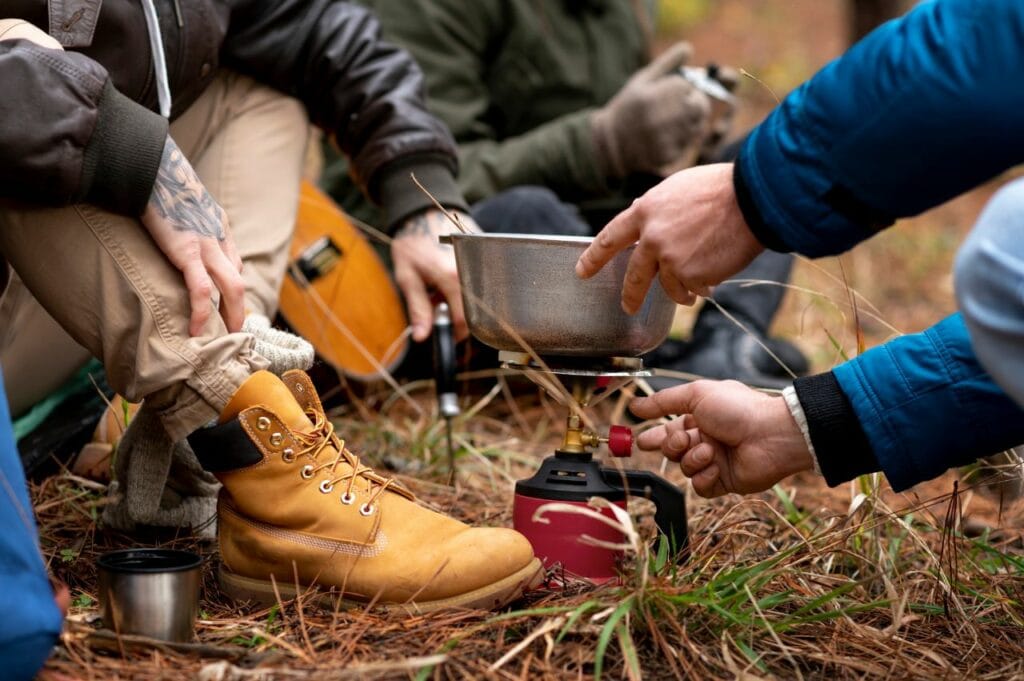
We're an affiliate. We hope you love the products we recommend! Just so you know, we may collect a share of sales or other compensation from the links on this page. Thank you if you use our links, we really appreciate it!
Heading out to hunting camp? One of the most important things to consider, besides your gear, is the food you’ll need to keep you fueled and satisfied. The ideal hunting camp meals should be easy to prepare, nutritious, and packed with energy to keep you going all day long as you track your prey.
We’ve got some fantastic meal ideas for your hunting adventure, from hearty breakfasts to energizing snacks and delicious dinners. With these meals, you’ll be ready to face whatever challenges the great outdoors throws your way.
Essential Foods for Hunting Camp
When preparing for a hunting camp, it’s crucial to plan your meals in advance to ensure you have enough energy and sustenance throughout the trip. Here’s a quick outline of foods to bring for breakfast, lunch, dinner, and snacks to keep you fueled and satisfied during your hunting adventures.
Breakfast sets the tone for your day, so it’s essential to have a hearty meal. A classic hunting camp breakfast includes eggs, home fries, and venison sausage. Feel free to substitute with bacon if you prefer. Don’t forget to pack some butter or cooking oil for frying. Pairing your breakfast with fresh fruits like apples adds essential vitamins and freshness to the meal.
For lunch , sandwiches are your best friend. Bread, cheese, and various deli meats allow for easy mix-and-match meal options. Add in some vegetables like bell peppers, cucumbers, or onions for extra nutrients. Peanut butter is a great alternative protein source for sandwiches if you want some variety.
Dinner at hunting camp is the perfect time for a warm and filling meal. Bring along some pre-cooked frozen or canned meals like venison chili or stew that can be easily reheated. Incorporating vegetables such as potatoes and carrots helps create a balanced meal. Consider bringing instant mashed potatoes or ramen as simple side dishes.
Don’t forget the snacks. It’s essential to have quick energy boosters throughout the day, particularly while hunting. Some options to pack include:
- Granola bars
- Apple slices
- Peanut butter and crackers
Remember, your dietary needs during hunting camp will likely be higher than usual due to increased physical activity. Be sure to pack enough food, and focus on a good balance of protein, carbohydrates, and healthy fats to keep your energy up and your body performing at its best.
Cooking Techniques at Hunting Camp
Mastering different techniques and using the right equipment will make your meals more satisfying and easier to prepare.
Fire is your primary heat source. Whether it’s a campfire or a portable stove, understanding how to control temperature and heat distribution is essential. For a campfire experience, carefully select your cooking spot, keeping wind direction in mind, and choose a location that can adequately support your cookware. Consider using fire-resistant gloves and long-handled utensils to make cooking safer and more comfortable.
Outdoor cooking, especially over an open flame, requires paying attention to fuel, heat, and cooking time. Hardwoods like oak or hickory are excellent as they create hot coals that maintain a steady temperature, perfect for campfire cooking.
A cast iron skillet is a versatile choice to bring along for your hunting camp, working well in various scenarios, from searing meats to frying eggs. Cast iron pans evenly distribute heat and maintain stable temperatures, but be mindful they take longer to heat up and cool down. And, don’t forget to bring essential utensils like a spatula, tongs, and a meat thermometer.
Here are some popular cooking techniques for hunting camp:
- Grilling: Ideal for meat, vegetables, and fish. Just place your food directly on the campfire grate or use a portable grill.
- Frying: Pan-fry your catch of the day in your iron skillet with a bit of oil or butter.
- Roasting: Skewer meat and vegetables, then slowly roast them over the campfire embers.
- Boiling/Simmering: Soups, stews, and pasta can easily be prepared using a pot or a dutch oven.
Recipes for Hunting Camp
Here are some impressive yet easy-to-make recipes to satisfy your hunger and make the most of your time outdoors.
Breakfast Burrito: Start your day with this classic camp favorite. Cook scrambled eggs, bacon or sausage, and sautéed peppers and onions. Add some shredded cheese and salsa, then wrap it all up in a warm flour tortilla. It’s the perfect grab-and-go meal for an early morning hunt.
Venison Chili: If you’re lucky enough to bag a deer, venison chili is a mouth-watering meal. Brown some ground venison in a pot along with onions, garlic, and bell peppers. Add in canned tomatoes, beans, chili powder, cumin, and other spices to taste. Let it simmer for a few hours to let all those flavors meld together. Serve it over pre-made cornbread or with some warm tortilla chips.
Beef Stew: For a warm and comforting meal after a long day, try making a beef stew. Brown chunks of beef (or deer meat) in a heavy pot, then add in vegetables like potatoes, carrots, celery, and onions. Pour in beef broth, a splash of red wine, and some Worcestershire sauce. Throw in some herbs like rosemary and thyme, then let it all simmer away until the meat is tender and the flavors have melded.
Here are a few more scrumptious ideas to keep your hunting camp well-fed:
- Casserole: Combine ingredients like sausage, eggs, cheese, and bread in a slow cooker overnight for a tasty breakfast casserole.
- Sloppy Joes: Brown ground beef or venison and mix in a tangy tomato sauce for some classic American comfort food. Serve it on a hamburger bun with some pickles and onions.
- Enchiladas: Fill tortillas with seasoned meat, beans, and cheese, roll them up, and top with a spicy enchilada sauce. Bake until bubbly and golden.
- Kebabs: Thread chunks of marinated meat, veggies, and pineapple onto skewers. Grill until cooked to perfection. This is a great option for a group meal.
Meat-Related Foods and Handling
When it comes to hunting camp food, meat is often the star of the show. From venison and bacon to steak and pork, there are plenty of options to satisfy your cravings. It’s important to handle and cook these meats properly to ensure a safe and delicious meal.
Venison is a common choice for hunting camp, as it’s often the result of a successful deer camp. You can prepare ground venison as a base for hearty dishes like chili, or go big with bacon-wrapped venison tenderloins. To avoid gamey flavors, be sure to trim any excess fat and silverskin. Marinades and slow-cooking methods can also help tenderize tougher cuts.
When cooking bacon outdoors, you can either bring precooked bacon to save on time and mess or cook it fresh over the fire or on a portable stove. In either case, be mindful of grease splatters, and keep a safe distance from the flames.
Craving a classic campfire experience? Steak and other cuts of beef can be cooked directly over the flames or on a grill. Just remember to let the meat rest after cooking to allow the juices to redistribute, resulting in a juicier, more flavorful bite.
Pulled pork is also a wonderful camp meal with a more hands-off approach. Simply slow-cook the pork in a Dutch oven or campfire-safe slow cooker, and your hunting camp will have flavorful, tender meat to enjoy after a long day outdoors.
Here is a quick guide to recommended cooking times and temperatures for different meats:
Handling raw meat can be a bit tricky when you’re outdoors in a hunting camp environment. Remember to bring appropriate storage solutions, such as sealed containers and cooler bags with ice packs, to keep your meat fresh. And always practice good hygiene by washing your hands and cleaning cutting surfaces and utensils after handling raw meat.
Comforting Desserts and Snacks
Even if you don’t have a sweet tooth, you’ll probably want a little treat after meals.
Biscuits and Pastries
Treat yourself to some delicious biscuits and pastries after a long day of hunting. They’re an excellent source of carbs and can fuel your campfire conversations. A popular option during hunting camps is the Dutch Oven Peach Cobbler . Made with peaches, cinnamon, and sugar, it creates a warm and comforting dessert to satisfy your sweet tooth. You’ll need to bake it in a Dutch oven over hot coals, but trust us, the effort is worth it!
Another great choice is Banana Cinnamon French Toast: a tasty spin on a traditional dish. What you need are:
- Sliced bananas
Simply dip bread slices in a mixture of eggs, milk, and cinnamon, then cook them on a griddle or skillet until golden brown. Top off with honey-drizzled bananas for a scrumptious dessert that can also double as breakfast.
Energy-Boosting Trail Mix
A long hunting day can leave you drained and in need of a quick energy boost. Customizable and easy to make, trail mix is the perfect snack for when you’re on the move or waiting in your hunting blind. When creating your trail mix, aim for a good balance between sweet and savory elements. Here’s a simple recipe with essential ingredients:
For an extra kick, you could add banana chips and a drizzle of honey to the mix. It’s not only delicious but provides the energy and nutrients you’ll need during your hunting camp. You can always personalize your trail mix by experimenting with different nuts, fruits, and flavors.
Meal Preparation Strategy
Before setting off on your hunting trip, especially to public land, it’s crucial to plan your meals strategically to make the experience enjoyable and hassle-free. Here are some tips to help you prepare meals efficiently for your hunting camp:
- Create a meal plan: Take into account the duration of your trip and the number of people in your group. Plan each meal – breakfast, lunch, and dinner, as well as any snacks. This way, you can determine what ingredients and cooking equipment you need to pack.
- Keep it simple: Opt for dishes that require minimal ingredients and have short cooking times. Foil-wrapped meals are a practical option, as they can be cooked on a campfire or gas stove. Some examples include:
- Grilled waterfowl poppers
- Sliced deer heart and inside loins
- Breakfast skillets with eggs, home fries, and venison sausage
- Pack wisely: Organize your ingredients in separate containers or bags for each meal. Label them to make it easier to find what you need when it’s time to cook. Don’t forget essentials like matches, a campfire or gas stove, and a zip lock bag to keep the matches dry.
- Cook in advance: If possible, pre-cook some meals at home and bring them in a cooler. This can save you time and effort at the campsite, and ensure you have nutritious food ready to eat. Crockpot meals, like breakfast casseroles and stews, can be prepared ahead and reheated at the camp.
- Embrace teamwork: Split cooking responsibilities among your group members, allowing everyone to participate and share the workload. This approach also adds variety to the meals, as each person brings their own culinary expertise to the table.
By planning and preparing your meals ahead of time, you’ll be able to fuel up efficiently and focus on what matters most: enjoying your hunting trip.

We’re passionate about getting the most from your car when it comes to going on adventures and road trips. When you take one of these trips you often need more room in your car than you usually would. This is when we come in, to help you find the best roof tent for your car and needs.
Leave a Comment Cancel Reply
Your email address will not be published. Required fields are marked *
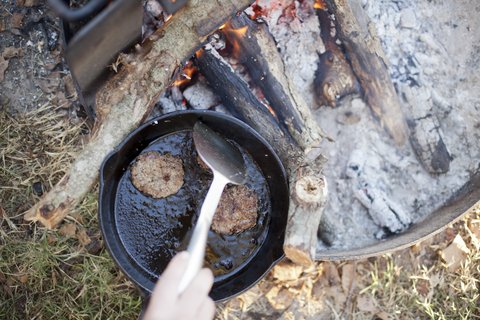
Great Camp Foods For Your Next Hunt
By Rich Wright
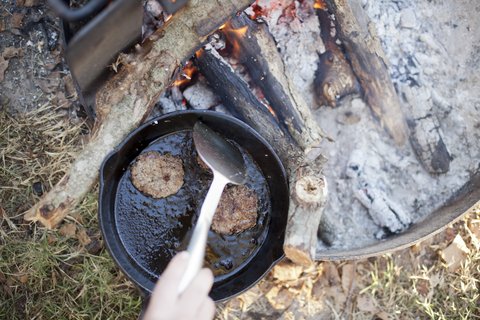
My second love (behind hunting of course) is food. Combine the two and I’m in a state of bliss. Every year I get so darn excited about opening day that I hurry through this essential part of ensuring a healthy, energy sustaining trip.
I have friends that really do it up on their hunting trips. They set up these elaborate kitchens, bring tons of food and usually have a designated cook. That’s fantastic if you have the resources. But what about the minimalist hunter who wants to pack lightly and camp in one or two spots that are away from the mainstream?
I hunt with one guy, and aside from having the same hunting philosophy as me, he is also an expert in good hunting food. We want essential proteins and vitamins, ease in preparation, and food that keeps.
When you’re planning your meals for a few days, make sure they are well-balanced. That means you need to consider high vitamin content veggies, good grains, good fats, energy fruits and high protein meats. Without being a nutritionist, this is easy to accomplish. Here are some great ideas that will fill you up properly:
Some, if not most, guys skip it before they set out. Then when they stagger back to camp at 11 am, they gorge themselves on bacon and biscuits and gravy. After that, a nap is almost unavoidable. And that’s great if that’s what you do. But if you’re like me, you realize how precious your hunt time is and want to get the most out of it — I have shot deer at 11 am.
This is when a little pre-planning pays off. I make a mean breakfast burrito that can be made ahead of time (at home or during down time) and will power you through the morning. Fry up some bacon, scrambled eggs and cheese, and potatoes with onions and bell peppers. Wrap it in a tortilla and then in foil. When you wake up, you should have some coals in the fire. Throw your pre-made breakfast burrito on the coals and you’ll have breakfast before you know it. Throw a few Cliff bars and a banana in your pack and you’ll be good for the whole morning. Try it with sausage patties on a biscuit for something different.
If you’re planning on coming back to camp (most guys do) before your evening hunt, lunch is the easy one. Get a good hearty bread and make a sandwich. Cold cuts and cheese keep for awhile and pack easily. Sardines, smoked oysters, cashews, and other high-protein/healthy fat foods will give you energy. Sandwiches are the best camp food there is. Don’t forget to throw on some avocado (great source of healthy fat), bell peppers or cucumber slices. Always try to eat veggies with every meal. Don’t forget to bring a jar of peanut butter and some honey!
Here’s the meal we crave most and the one that always seems to be a pain. Made ahead of time, you’re not fumbling around in the dark after the evening hunt. Here’s some of my favorites made at home.
- Throw some pork chops, sauerkraut, and applesauce in the crock pot—sprinkle with cinnamon. Great, hearty camp meal.
- Pre-made pasta with meat sauce—always a filler-upper.
- Fry up a big bunch of kale, chard and collards in olive oil and fresh garlic. Put it in a ziplock for an easy to heat, very healthy source of vitamins.
- Crock pot beef stew with sweet potatoes, onion, carrots, celery and the works.
- Make a big batch of garlic mashed potatoes.
- If you want a steak, there is no better way to cook it than to place it right on top of hot coals. Brush off the ash, throw a generous slice of butter on top and you’re in heaven.
- Sausages like kielbasa are good fried up with a bunch of onions and red and yellow bell peppers.
These are just a few examples of good, hearty and healthy camp meals that you can prepare ahead of time. They keep easily in an ice chest and can be heated up quickly, even in the dark. Don’t forget to throw a lot of butter in with everything. You need the calories and nothing tastes quite like butter in the outdoors.
Last, but not least, don’t forget your favorite, well aged cast iron pan to heat up all of this wonderful stuff. Just wipe it out after each meal and you’ll be surprised at how all those flavors add to each other. Man, I’m hungry!
© Justinkendra | Dreamstime.com – Cooking Sausage Over A Campfire Photo
Share article
Latest News

Best Places to Hunt, Fish, and Hike in Montana

The Ten Best Fishing Locations in New Hampshire: An Anglers’ Paradise

Cold-Weather Gear Designed Specifically For Your Lower Body

Ohio Hunters Are Ready For Fall

6 Things to Consider When Camping with Kids
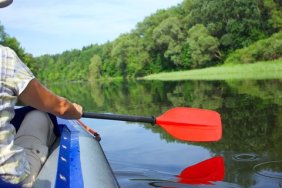
4 Inflatable Camping Kayaks for Your Next Trip
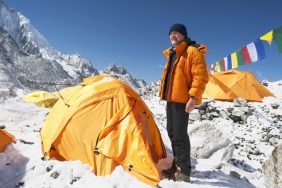
Best All-Weather Gadgets for Hunting, Fishing, or Camping Trips

- Hunting Tips
- Hunting Gear
- Hunting Accessories
- Hunting Clothing
- Kitchen Essentials
The Best Hunting Foods: What to Eat When You're Out in the Woods

When you’re out hunting, it’s important to make sure you have the right food to sustain you. Many different foods work well for hunters, but not all of them are equal. This blog post will discuss the best hunting snacks and what to eat when you’re out in the woods!
Quick Picks: Best Hunting Foods
How many calories do hunters burn.
The range for sheep hunters is between 8,000 and 11,000.
The amount of water you require depends on how active you are.
What Can Happen If You Don’t Add More Calories?
To maintain your weight, you need to eat as many calories as you burn.
When you’re out walking, climbing, dressing, and carrying an animal, you use a lot of physical energy, burning more calories.
If you do not replace them, you will not have enough fuel to generate more energy. You can become fatigued more easily.
The odds are in your favor of losing weight while hunting.
It’s tough to increase your calorie intake high enough to stay away from this problem.
This is why it is important to have healthy foods high in calories and nutrients.
Why Is Calorie Dense Food Recommended?
Many hunters carry a backpack with them when they go hunting. This backpack can hold essential items such as food for the day.
To keep your backpack light, try to choose items that have 100 calories for every ounce they weigh.
This will help you make up for the calories you’ll be burning.
It’s important to avoid eating foods with a lot of sugar or starch because they don’t have any nutritional value.
When you eat sugar, it gives you a rush of energy. But this energy doesn’t last long, and you will soon feel tired again.
You need to eat food that gives you energy.
When you are physically active, the best type of food to eat is one that has a lot of protein and fats, and carbohydrates.
Other Considerations When Choosing Your Menu
a) Put the items in containers.
Choose foods that arrive in containers whenever possible. This will make packing them inside your backpack much easier.
b) Choose calorie-dense lighter choices.
c) You like to eat them.
An apple, for example, is a large fruit with a modest calorie count. It’s best if you leave it at home.
d) Easy to open
Ensure that the foods you take in your backpack are easy to open and ready to eat. This will make it easier for you to snack when you’re on the go.
e) Ready to eat
You can put off preparing the things that need it until you go back to camp in the evening if you save those items for later. Before they set out on their hunt, certain hunters enjoy a hearty meal. Some hunters skip breakfast altogether and subsist solely on snacks until it's time for dinner. It is recommended that you begin with a meal that is high in nutrients. This should last you over till the meal in the evening. You may also bring along some snacks if you like.
The Best Food To Take Hunting For Your Backpack:

Jerky is an excellent source of protein and fat-based energy.
Each ounce of deer jerky contains roughly 90 calories. It is lightweight and easy to transport in a backpack.

2. Trail Mix:

Trail mix is a good source of healthy calories.
One ounce of this product packs 160 calories and contains nuts and fruit, which offer extra nutrients. The inclusion of nuts offers omega-3 fatty acids.
3. Summer Sausage:

Summer sausage is a good choice because it has protein and a high fat count.
This food item has about 90 calories per ounce.
4. Wheat Thins:

These healthy snack crackers have 120 calories per ounce.
These items are light and offer carbohydrates and fiber to your hunting menu.
5. Snickers Bar:

Although Snickers bars contain a lot of sugar, they also have peanuts and nougat.
This candy bar can give you a sweet treat with 132 calories per ounce.
You don’t need to avoid sugar completely when hunting, but you should watch how much sugar you eat.
6. Granola:

One ounce of granola contains 100 calories. This makes it a good snack while you are out in the field.
This food gives you energy by providing fat and complex carbohydrates.

If you want a quick and easy way to boost your calorie intake, try packing a bag of nuts. Nuts like almonds, peanuts, and pistachios can give you a good amount of calories in just 5 to 6 ounces.
Choose the type of snack you like. Here is the calorie breakdown:
- Peanuts: 170 calories per ounce
- Cashews: – 160 calories per ounce
- Brazil nuts: 184 calories per ounce
- Pistachios: – 160 calories per ounce
- Sunflower seeds: 173 calories per ounce
- Walnuts: 183 calories per ounce
Nuts are a source of Omega 3 fatty acids. This is the good kind of fat that benefits your health and gives you more energy.
They also provide protein, which is important for converting calories into energy.
8. Peanut Butter:

Peanut butter is available in different-sized containers.
One ounce of Nutella gives you 165 calories. It comes in plastic jars, so it is easy to carry around.
You could eat it on a sandwich or crackers if you like the taste.
This food contains a lot of protein, as well as some fat. This makes it a good choice for energy food.
9. Tortillas:

Spreading peanut butter, jam, or Nutella, each of which has 150 calories per ounce, on a flour tortilla, which has 87 calories per ounce, is another option. Tortillas are quite portable and don't take up much space in your bag. Some people find that eating oatmeal helps them feel less of a need for other carbohydrates, namely bread. Oatmeal is an excellent source of carbs, which, as you may well know, can make you feel fuller for a longer period of time. When packed in a backpack, bread has a high propensity to become shattered or crumble.
Additional menu for Tortillas:
You may also make filled tortillas in advance by using re-fried beans. They’ll add:
- Protein content: 1.5 grams
- 25.5 calories per ounce, a modest quantity of fat
- Put cheese in the burrito, and you add:
- 114 calories
- 9.4 grams of fat
- .36 grams of carbohydrate
- 7.06 grams of protein per ounce
This is a good solution for hunters who want to hunt during their lunch break instead of going back to camp for a meal.
10. Peanut M&Ms:

Peanuts, a source of many beneficial nutrients, are included in this product. Peanuts also include a trace amount of fat, which slows down the pace at which your body burns calories. Peanuts are a good choice for those looking to lose weight. It is simple to transport a package due to its low weight and the fact that it can be stored in either a backpack or a pocket. They will provide you with sufficient energy to make that incredible shot, follow it up with dressing the deer, and then bring it back to camp with you.
Morning Lunch and Evening Meals:

Some hunters spend a lot of time perfecting their camp cooking skills. They might consume a few nutritious hunting snacks throughout the day and then have one substantial meal in the evening. Some other hunters might not be as well prepared and end up going without food. When you are trying to sell your property, it is essential that you do not skip meals. This will help you maintain your focus while also giving you more energy. You need to increase the amount that you consume rather than decrease it. The following are some examples of meals that contain a lot of calories. This will provide you with the necessary energy to have a successful hunting expedition. These foods are perfect for hunters who have already established a camp and have the necessary supplies for preparing and storing food.
11. Scrambled eggs:

A single serving of scrambled eggs has approximately 3.9 grams of protein, 4.5 grams of fat, and a total of 60 calories. A serving size of this dish, which is 4 ounces, will provide you with 240 calories.

One ounce of bacon has 151 calories. This means that it has some protein and fat.
They burn slowly throughout the day.
13. Dehydrated Whole Milk:

The dehydrated form of whole milk has many benefits, including:
- In a backpack, it’s simple to transport.
- It comes in handy when making meals.
- Hydration by drinking
- Per ounce, it adds 150 calories.
- It’s a quick and easy meal that adds more than 100 calories per ounce when combined with granola cereal.
14. Maple and Brown Sugar Instant Oatmeal:

Oatmeal is a grain that contains a lot of carbohydrates and some sugar.
Each ounce of Nutella has 107 calories.
If you want to add more calories to your drink, you can do so by adding a few ounces of powdered milk that has been dehydrated.
15. Boxed Macaroni and Cheese:

This is a simple side dish that can be prepared quickly while camping.
Macaroni and cheese is a food that has a lot of calories. It also has a lot of carbohydrates.
This popular comfort food can help you sleep better when eaten during the evening meal. It has a relaxing effect because it is high in carbs.
16. Olive Oil

When you’re preparing your meals, bring a tiny bottle of olive oil with you.
Per ounce, it contains 238 calories.
It’s great for making fried foods or pasta recipes.

These days, tuna can be purchased in convenient pouches that can be opened without the use of a can opener. The protein found in tuna can be utilized by you. The number of calories is rather minimal, coming in at only 25 per ounce. You can also prepare them in combinations with other foods, such as macaroni and cheese. If you add them to a sandwich or spread them on crackers, they make an excellent addition to a meal that you plan to consume while hunting. This tool may be used to plan either your lunch or dinner for the day.
18. Powdered Cocoa Beverage

Cocoa powder is easy to carry with you. All you need is a cup of hot water for a great taste with 112 calories per ounce.
This drink is perfect to have after a long day of hunting. It’s great for relaxing after dinner.
19. Mountain House Breakfast Skillet

This dehydrated meal is a good alternative for breakfast or dinner.
This food gives 145 calories per ounce and is perfect for tortillas.
20. Canned Chicken

The white meat from canned chicken is an excellent source of protein. Only 45 calories are contained in each ounce of it. Because of the can's compact size, it is simple to transport and incorporate into various pasta meals. Fresh chicken is an option to consider in place of canned chicken. You can bring along some fresh chicken to grill if you have a cooler at base camp or in your pickup. It is possible to add additional calories to chicken breasts by cooking them in olive oil. They go well with a variety of accompaniments.
Stay Hydrated and Add a Few More Calories
Adding Gatorade to water in powdered form makes the drink 100 calories per ounce.
This is an excellent method to stay hydrated and add more calories to your diet.
Adding flavors to water can make it more enjoyable to drink, which can help you stay hydrated.
Read more: Healthy Tips for Hunting
Final Thoughts:
These are some good foods to take with you when you go hunting. They will help you stay energized, and they won’t make you too full, so you can continue hunting.
Dehydrated meals are usually a good choice because they are lightweight and easy to prepare.
When you’re making meal plans for hunting, take extra care to:
- Calories dense foods
- Pack high nutritional value
- Provide protein, fats, and carbohydrates
- Favorite food
Frequently Asked Questions about Hunting Foods
What should i prepare for hunting.
Before going hunting:
- Learn about the game you will be hunting and its environment.
- Know the state regulations.
- Get the right clothing and gear for the environment you will be in. If you are using a dog or horse, get the right permits.
Are Snacks Food?
A snack is typically described as any food consumed between meals. For various reasons, many people snack at least once during the day.
How Do You Scout for Hunting?
Find a big buck or big buck sign. This will help you find where the buck sleeps, eats, and travels. Try to find a spot where the deer will walk by on their daily routine. Ensure this spot is easy to get to and that the wind is blowing in the right direction during hunting season.
When Should a Hunter Get Ready for a Hunt?
You should be physically prepared to carry a pack weighing 1/4 of your body weight for several miles through rough terrain. This might include going on long hikes or walks and lifting weights. If you want to be an even better hunter, start preparing at least 4 to 6 months before your hunt.
What Does Breakfast Stand For?
The first meal of the day is called breakfast. This word is made up of two parts: break and fast. To fast means to go without food. So “breakfast” means to break the fast you have been observing since you went to sleep the night before.
What Is the Most Popular Snack in the World?
Chocolate is the most popular snack in the world. A lot of people eat it. 64% of respondents said they ate chocolate as a snack in the past month.
Are Proteins Bars Good for You?
Most protein bars contain 5-10 grams of fat, 25-35 grams of carbs, and 5-10 grams of fiber. Protein bars are also a good source of micronutrients like calcium, B vitamins, potassium, and iron.
Are Dried Fruit Snacks Healthy?
People who eat a lot of plant phenols have a lower chance of getting heart disease, diabetes, and several types of cancer. This is because dried fruits are full of healthy nutrients. However, you should avoid added sugars and track how many calories you are eating.
How Effective Are Energy Bars?
Some energy bars are a good choice for a snack or mini-meal because they have a lot of protein and fiber. They also have low sugar and saturated fat content. However, some energy bars have chocolate coatings or sugary syrups, which means they are more like candy bars with added protein.
F &S Music Fest & Outdoor Expo Tickets Are On Sale Now! J oin Eric Church, Lainey Wilson & more for a party in the woods. Get tickets
The Best Recipes and Drinks for Hunting Camp
How to set a killer happy hour spread, cook a mean biscuit, to fix a feast fit for a king
By The Editors | Published Oct 10, 2020 12:00 PM EDT

One thing about hunting camp: Even if the hunting is terrible, at least you can rely on some good eating. Whether it’s a pot of venison chili , the greatest, perfectly-cooked backstrap recipe , or a warm meal that’s been bubbling in the slow-cooker all day, hunting camp is a place for great meals. Here, our editors share their favorite tips and recipes for all four meals of the day—breakfast, lunch, happy hour, and dinner.
Kick Back at Happy Hour

More than once, I’ve spoiled my appetite for dinner during happy hour. Put out a plate of cured meat with cheese and crackers, and I’m helpless. If I were forced to pick my favorite food group, it’d be snacks. I’ve been a guest at camps that served some wildly extravagant spreads—mountain lion meatballs, walleye wontons, goose-pastrami sliders—and I was in hog heaven. Happy hour at our deer camp in New York, on the other hand, is typically minimal: summer sausage, a brick of cheese, and a sleeve of crackers.
Both could not be more different.
Both could not be more delicious.
Because a camp happy hour isn’t about the food (or drinks). It’s about the ritual of coming together after a day in the field and taking turns swapping stories of our hunts—the things we saw, the shots we took, the tags we punched. This nightly story session is one aspect I enjoy most about camp; the fact that it comes with snacks (and drinks) is only a bonus.
Far be it from me to tell you what to serve at a camp happy hour, but I’d be remiss if I didn’t share a few suggestions:
- Always double up on summer sausage. Same goes for jerky.
- Sharp cheddar is the only cheese you need, but if there’s fridge or cooler space for more, go with a soft option, like a pimento-cheese spread. Smoked cheeses are disgusting and don’t belong in camp.
- Ritz. Crackers. Only.
- A bit of acid goes a long way. Think pickled eggs, pickled pike, or a jar of giardiniera.
Other than that, don’t forget to toast your fellow hunters—and don’t eat too much. Remember, dinner’ll be ready soon. — Colin Kearns
Craft a Homemade Chuck Box
The highlight of last year’s deer camp was Nate’s 8-point buck. But Greg’s homemade chuck box was definitely a close second.
Aside from the fact that it was simply a thing of beauty—thoughtfully designed, sturdy, and true, meticulously hand-painted, even—the box made a world of difference in keeping our small wall-tent kitchen organized. Dishes, mugs, cutting boards, paper towels, utensils, you name it—they all had their place, which meant we had more space to kick back in the tent and relax after our hunts.
You could purchase a chuck box, but it’s tough to think of a better preseason camp project than making your own; building plans for DIY chuck boxes are easy to find online. While it might sound silly to wax poetic about a chuck box, it really did become a source of pride at camp last year. And it’s fun to imagine how well the chuck box will age and take on even more character, year after year, at deer camp. — C.K.
Get the Good Stuff
There is a name for any alcohol-free bivouac of sportsmen. It’s called “Camp This Has Been Great. I’m Leaving.” Alcohol doesn’t make camp, but it makes camp more comfortable. Booze selection is one area where you don’t want to economize. It’s not that anyone will resent a shot of Ol’ Buffalo Lump; it is just that if you get the good stuff and share it liberally, everyone will take note. As of this writing, the virus is preventing me from blowing money on all sorts of frivolous crap and, well, doing much of anything else either. When I finally get that opportunity, I want sharing a drink to be memorable. Also, if you are a younger member at camp, do not bring any whiskey flavored with peach, cinnamon, maple, toffee, or peanut butter. Older guys see this as a provocation and will run you off. And I will be one of them. — B.H.
A Feast Fit for a King
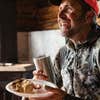
In December 1950, a Mississippian named John Cullen mailed a letter to King Gustaf VI Adolf of Sweden, inviting His Majesty to dinner the following autumn at the deer camp where Cullen was a member. The king had recently bestowed an honor, the Nobel Prize in Literature, upon another of the camp’s members—William Faulkner. Cullen wanted to reciprocate. A camp favorite, “coon and collards,” would be part of the menu, he wrote.
The dinner never happened, however, because the king graciously declined. But ever since reading about Cullen’s invitation many years ago, I’ve wished that it had. Not for the sake of the members, who would’ve doubtless seen their hunting curtailed by all the pomp and preparation, but for the sake of the Swedish monarch. Even in its simplest manifestations, a hunting-camp dinner, then as now, is a unique and sublime occasion—the closest descendant to the original communal dinners where prehistoric hunters charred their kills over a fire, and where, I might add, the act of storytelling almost certainly began.
Cullen and Faulkner’s deer camp, despite its Nobel affiliation, was nothing fancy: a galvanized tin structure in the silty bottomlands of the Mississippi Delta housing 16 bunks and a makeshift kitchen. Heat came from burning logs in a repurposed oil drum, and the wine was home-brewed from muscadine grapes. The dinner fare would’ve been designed to appeal as much to the gut as to the palate: coon and collards, as Cullen advertised; broiled backstrap; biscuits or cornbread. The king would’ve had to serve himself, in the way we now call “family style.” From the table, he might have had to clear poker chips or a can of gun oil to make room for his plate.
But let’s not mistake rustic with simple—and let’s hope the king would not have either. Because underlying the rough-hewn pleasures of a camp dinner is an intricate and ancient web of relationships: between the hunter and the game, most importantly, but also between the hunters themselves, steeped in camaraderie as well as inevitable competition; between the young hunters and the old-timers; and between change and tradition.
Oh, there’s a lot of nonsense that gets passed around at the table. Cullen liked to debate whether it’d be possible to kill a deer with a Hula-Hoop. But the nonsense is to counterbalance the seriousness of the shared endeavor, the gravity of wildlife becoming wild death, the primordial calculus, in Faulkner’s words, of “when to shoot and not to shoot, when to kill and when not to kill, and, better, what to do with it afterward.” The camp table is where all that comes together, where the harvest is shared, where the stories are told (and the exaggerations refuted), where all the elaborate efforts that hunting requires—and by this I mean the procurement of land or lease, establishing a camp, carving time from work and family, traveling, the great rigmarole that precedes the hunter even lacing up his boots—come to their ordained conclusion. Where the circle is closed, in other words. Where “the best of all breathing and forever the best of all listening,” as Faulkner described the act of hunting, becomes the best of all eating. And where some unlucky soul, royalty or not, must always get saddled with dish-washing duty. — Jonathan Miles
Get Up and Bake a Mean Biscuit

Before the alarms go off; before the locals drive in with their truck tires crunching gravel; before the groans of middle-aged men unfolding themselves from bunk bed mattresses; before all this, I lie in my own deer camp bunk and listen to Tommy Krisulewicz in the kitchen.
Usually, by the time I’m awake, he’s already prepped the flour: four cups, self-rising, hand-cranked through the sifter. Tommy chills every tool he uses to make biscuits. He opens the freezer door and grabs the grater, which he uses to grate two sticks of butter into the flour, stirring the chunks with a butter knife to coat them well. Then he cuts the butter into the flour with the pastry blender. Thump-thump-thump.
The buttermilk, he says, is a feel thing. Maybe a cup or so to wet the mixture so he can form it into a ball. Out comes the rolling pin, and I can hear the old wooden cylinder rattling in its spindle. He rolls the dough ¾ inch thick, give or take, then folds it right to left and top to bottom. Rolls it out again and folds a second time: left to right, bottom to top. Rolls it out a final time, then cuts the round biscuit disks with the chilled cutter. Straight down and straight up, Tommy insists. Twist the cutter, and the biscuit edges will harden.
He loads the cast-iron skillet with biscuits touching “so they’ll smoosh up together as they rise,” he says. “Makes ’em rise taller. Trust me.” And we all do.
The biscuits bake at 450 degrees for 20 minutes, and by the time they come out of the oven, just about everyone is out of their beds, elbows on the tall counter, some ready to roll out in camo, others still in their underwear, all of us waiting on homemade Tommy K. biscuits.
Pass me that jelly.
Where’s that sausage?
A good day dawning. I can hear it now. — T. Edward Nickens
Want More of the Great Outdoors?
Stay adventure-ready with outdoor news that keeps you informed, not spammed.
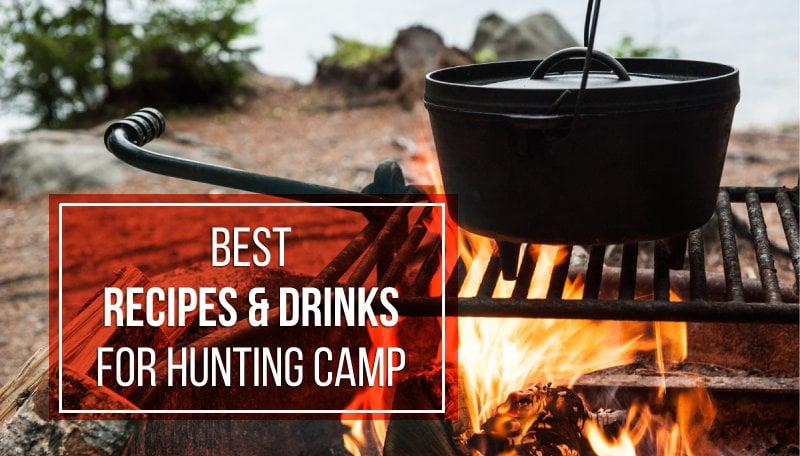
- How to Guides
The Best Recipes and Drinks for Hunting Camp – 2023
- May 23, 2023
Last Updated on October 5, 2023
We’re about to embark on a mouthwatering journey through the best recipes for hunting camp meals and cocktails! As avid hunters, there’s nothing quite like the satisfaction of preparing and enjoying a delicious meal made from the fruits of your labor. The crackling campfire, the aroma of woodsmoke, and the camaraderie shared with fellow hunters create a unique and unforgettable dining experience. In this article, we’ve carefully curated a collection of hearty hunting camp meals and thirst-quenching beverages that are perfect for celebrating a successful day in the great outdoors. If you want more cool hunting recipes, check out our wild turkey recipes as well as duck and geese recipes . Enjoy reading!
Table of Contents
Best Hunting Camp Meals – Venison Chili – Venison Sloppy Joe – Bacon Wrapped Venison Tenderloin – Gobbler Hot Wings – Chopped Duck Sandwiches with Cherry Barbecue Sauce Hunter Cocktails – Buck Hunter – Duck’s Fart – Deer Camp Old Fashioned – Hunter’s Cocktail
Best Hunting Camp Meals
Venison chili.
Deer hunting is a time-honored tradition, and as the most popular big game animal, it’s no surprise that venison is a highly sought-after delicacy. With its rich, earthy flavor and lean texture, venison is not only delicious but also a healthy alternative to other meats. So let’s begin with one of the best deer camp meal recipes.
Here’s our recipe for a scrumptious Venison Chili – one of the best hunting camp meals:
Ingredients:
- 2 lbs ground venison
- 2 tbsp vegetable or canola
- 1 large onion, chopped
- 3 large poblanos, stemmed and diced
- 3 cloves garlic, thinly sliced
- 2 cans (15 oz) red or kidney beans, drained and rinsed
- 3 cans (15 oz) tomatoes
- 3 cups beef or venison stock
- 2 tbsp ancho chile powder
- 1 ½ tbsp ground cumin
- 1 tsp paprika
- 1 tsp dried oregano
- Salt and pepper, to taste
- Optional toppings: shredded cheese, sour cream, chopped green onions, or sliced jalapeños
Instructions:
- Heat the vegetable or canola oil in a large pot or Dutch oven over medium heat. Add the ground venison, sprinkle it with salt and pepper, and cook until browned, breaking it up with a spoon as it cooks. Remove the venison from the pot and set aside.
- In the same pot, add the chopped onion and poblanos, cooking until softened, about 8 minutes. Add the minced garlic and cook for an additional 1 minute.
- Stir in the chile powder, ground cumin, paprika, and dried oregano. Cook for 1 minute to toast the spices.
- Return the browned venison to the pot, along with the beans, tomatoes, and stock.
- Bring the mixture to a boil, then reduce the heat to low and let the chili simmer for at least 1 hour, stirring occasionally. The longer it simmers, the more the flavors will develop.
Venison Sloppy Joes
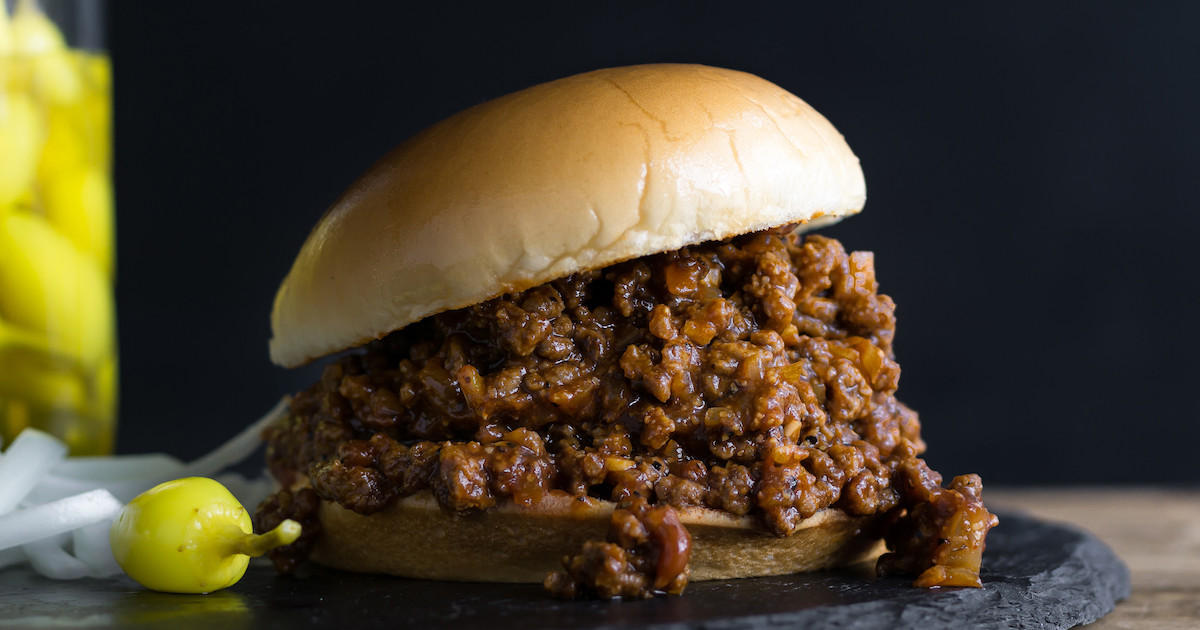
There’s something undeniably nostalgic and satisfying about a good old-fashioned Sloppy Joe. Putting a wild game spin on this classic comfort food is a fantastic way to elevate the experience. Our Venison Sloppy Joe is delicious and simple to prepare hunting food, making it perfect for a fuss-free campfire meal.
Here’s our recipe for delectable Easy Venison Sloppy Joes that will quickly become a hunting camp favorite:
- 1 lb ground venison
- 1 tbsp canola oil
- 1 large onion, finely chopped
- 2 cloves garlic, minced
- 1 can (8 oz) tomato sauce
- 1/4 cup ketchup
- 1/4 cup barbecue sauce
- 1 tbsp Worcestershire sauce
- 1 tbsp brown sugar
- 1 tbsp ground mustard
- 1/2 tbsp smoked paprika
- 8 hamburger buns, toasted
- In a large skillet, heat the oil over medium heat. Add the chopped onion and minced garlic to the skillet, cooking until the onion is softened, about 5 minutes.
- Add the ground venison and cook until browned, breaking it up with a spoon as it cooks.
- Stir in the tomato sauce, ketchup, Worcestershire sauce, brown sugar, ground mustard, and smoked paprika. Season with salt and pepper to taste.
- Bring the mixture to a simmer, then reduce the heat to low. Let the Sloppy Joe filling cook for 20-25 minutes or until it reaches your desired consistency.
- Spoon the Venison Sloppy Joe filling onto the toasted hamburger buns.
Bacon Wrapped Venison Tenderloin

With the tender, flavorful venison wrapped in smoky, crispy bacon, it’s hard to resist this delectable combination. It’s worth noting that venison backstrap and tenderloin are often confused; while both are incredibly tender cuts of meat, the backstrap is a longer muscle along the spine, while the tenderloin is a smaller muscle found beneath the ribs. However, both cuts can be used interchangeably in this recipe.
Here’s our hunting camp recipe for an irresistible Bacon Wrapped Venison Tenderloin:
- 2 lbs venison tenderloin or backstrap, trimmed
- 1/2 lb thick-cut bacon
- 3 cups brown sugar
- 2 cups soy sauce (Feel free to use low sodium)
- 2 tsp black pepper
- 1 tsp ground mustard (Or 1 tbs prepared mustard)
- Begin by mixing the brown sugar, soy sauce, garlic, pepper, and mustard to create a flavorful marinade. Coat the venison thoroughly in the marinade, then wrap tightly or place it into a sealable plastic bag. Allow the venison to marinate in the refrigerator for at least 1 hour, but marinating overnight will yield the best results.
- Preheat your oven to 350°F and prepare a baking pan, preferably one with a slotted design that allows the drippings to collect below, making it easier to baste the venison as it cooks.
- Take the venison out of the marinade (but don’t discard the marinade) and wrap it with bacon slices. Pour the remaining marinade over the bacon-wrapped tenderloin.
- Position the venison in the center of the oven and bake for approximately 30-40 minutes or until it reaches your desired level of doneness, aiming for a medium roast.
- For an extra touch of deliciousness, remove the tenderloin from the oven and turn on the broiler. Once heated, place the venison back into the oven for a short period, just long enough to crisp up the bacon and achieve a delectable crust.
Gobbler Hot Wings
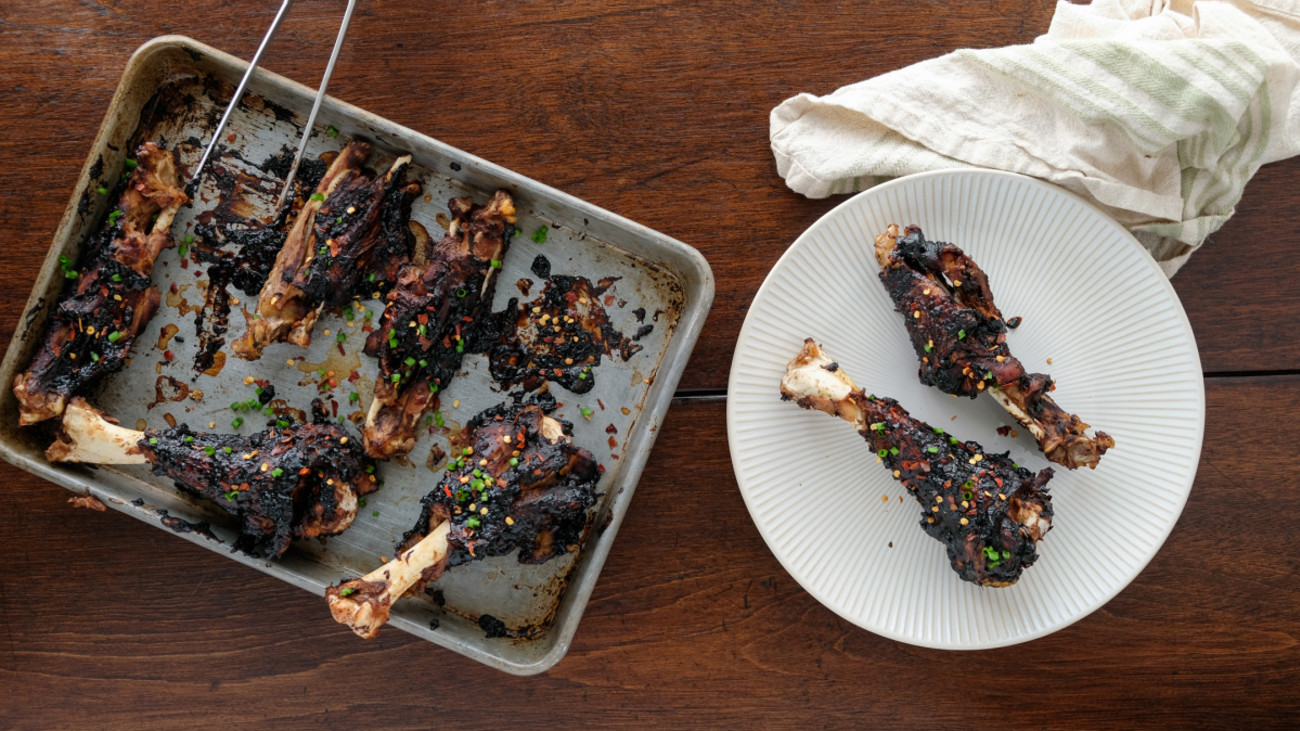
Inspired by classic chicken wings, this dish is made with tender gobbler breast meat, adding a unique twist. Perfect for sharing around the campfire, Gobbler Hot Wings are bound to become a cherished turkey hunting camp meal.
- Gobbler wings
- Oil for frying
- Wing sauce to your taste
To prepare Gobbler Hot Wings, start by cutting chunks of gobbler breast meat and rolling them in breading. Fry the breaded pieces until the breading adheres well to the meat. Once nicely coated, arrange the breaded gobbler chunks on a cookie sheet and drizzle them with your favorite wing sauce. Bake the wings at 350°F until they are fully cooked through. For that finger-licking finishing touch, give the cooked pieces another generous coating of wing sauce before serving. Gather your fellow hunters and savor these scrumptious Gobbler Hot Wings, which are sure to become a highly anticipated turkey camp tradition.
Chopped Duck Sandwiches with Cherry Barbecue Sauce
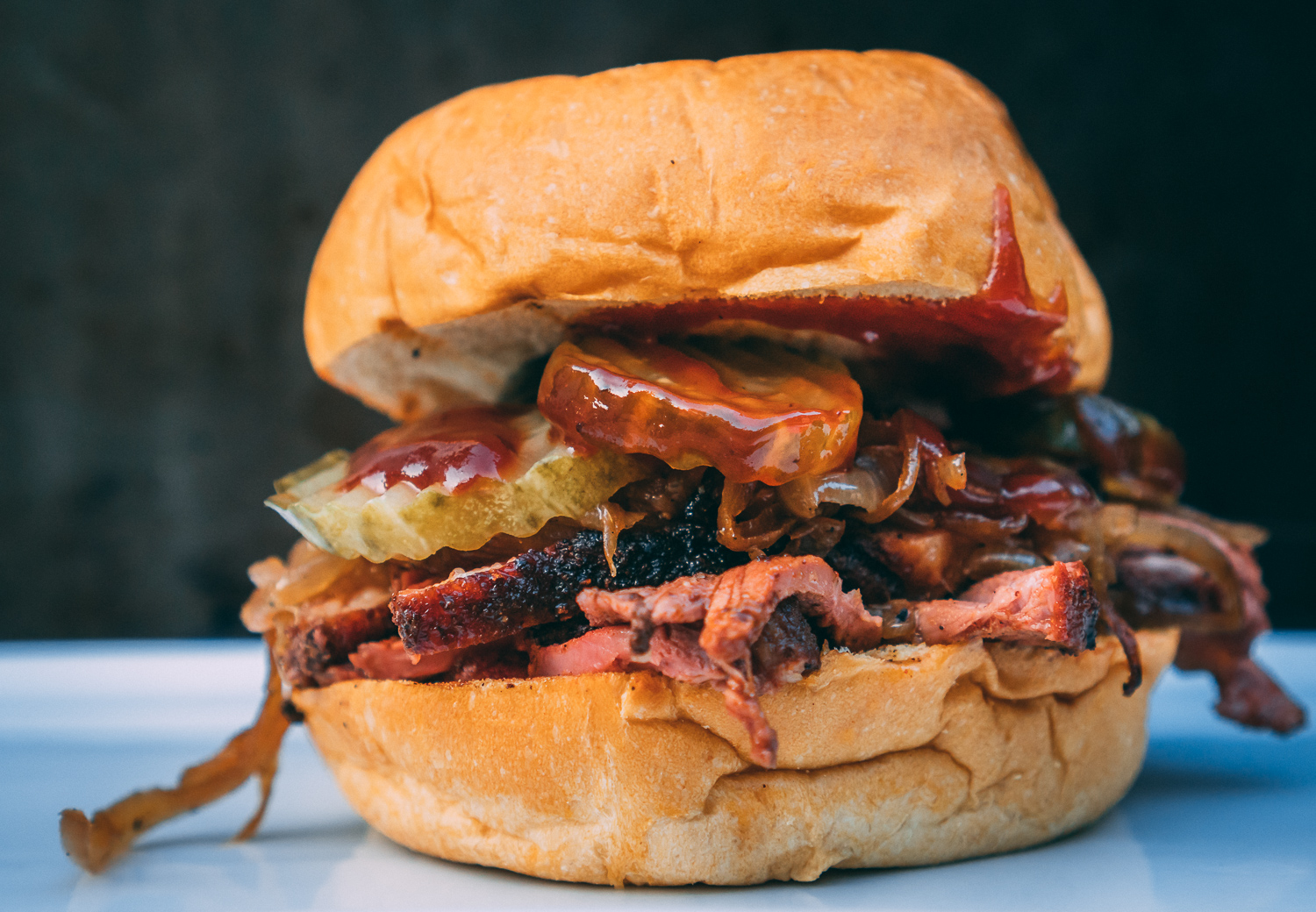
Indulge in these mouthwatering Chopped Duck Sandwiches with Cherry Barbecue Sauce, a dish that’s so delicious it might even distract you from your outdoor adventures. This versatile sauce is also perfect for chicken, so consider making a double batch to freeze and enjoy later.
- 2 lbs duck meat, cooked and chopped
- 1 cup apple cider vinegar
- 1/3 cup ketchup
- 1/3 cup chopped onion
- 1/3 cup dried tart cherries
- 1/8 cup water
- 1 ½ tbsp molasses
- 1 large dried ancho chili pepper, seeds and stem removed
- 1 garlic clove
- ½ tsp ground coriander
- Pinch of ground cloves
- 4 large Kaiser rolls
- Grill or sauté duck breasts or whole ducks, then chop the cooked meat.
- In a medium saucepan, combine the apple cider vinegar, ketchup, chopped onion, dried tart cherries, water, molasses, ancho chili pepper, garlic, ground coriander, and ground cloves (exclude the duck).
- Bring the mixture to a boil, then reduce heat to medium-low, cover, and simmer until the cherries are tender about 20 minutes.
- Allow the sauce to cool, then puree with an immersion blender.
- If needed, return the sauce to the pan and simmer uncovered until it thickens to the consistency of tomato-based barbecue sauce.
- Spoon the duck and cherry barbecue sauce mixture onto the Kaiser rolls.
Hunter Cocktails
Buck hunter.
The Buck Hunter is a refreshing and invigorating cocktail, perfect for celebrating a successful day of hunting. This drink combines the bold flavors of bourbon with the bright, zesty notes of ginger and lime, creating a well-balanced and revitalizing beverage.
- 6 oz. Bourbon
- 2 1/4 oz. fresh lemon juice
- 2 1/4 oz. ginger syrup
- 1 1/2 oz. water
- 4 oz. sparkling water
- 3 Dashes of Angostura bitters
Duck’s Fart
Don’t let its quirky name fool you – the Duck’s Fart is a smooth and indulgent shooter that’s sure to be a hit around the campfire. With layers of rich coffee liqueur, Irish cream, and Crown Royal whiskey, this delightful shot offers a surprising mix of flavors that will have everyone coming back for more.
- 1 oz coffee liqueur (such as Kahlúa)
- 1 oz Irish cream (such as Baileys)
- 1 oz blended whiskey
Deer Camp Old Fashioned
A classic with a wild twist, the Deer Camp Old Fashioned elevates the traditional cocktail by incorporating a touch of maple syrup. The result is a sophisticated and warming drink, perfect for sipping by the fire after a long day in the woods.
- 2 oz bourbon or rye whiskey
- 1/2 oz pure maple syrup or honey
Hunter’s Cocktail
The Hunter’s Cocktail is a simple yet elegant drink that blends the warmth of whiskey with the sweet and seducing notes of cherry brandy. This timeless libation is perfect for unwinding and sharing stories of the day’s adventures.
- 1 1/2 oz whiskey (bourbon or rye)
- 1/2 oz cherry brandy
- Maraschino cherry, for garnish
Check out other articles on cooking:
- Bear Meat Recipes
- Wild Turkey Cooking Guide: Delicious Recipes & Cooking Tips
- How to Cook Wild Goose and Duck – Good Tips and Simple Recipes
- A Hunter’s Guide to Cooking Wild Boar
- Cooking Wild Game
What are some of the best deer camp meal ideas?
To make your deer camp experience memorable and delicious, consider preparing meals like Venison Sloppy Joes, Venison Chili, or Bacon Wrapped Venison Tenderloin. These dishes not only showcase the rich flavors of venison but also provide comforting and satisfying meals after a long day of hunting.
What drinks should I serve at my hunting camp?
Hunting camp drinks should be warming, flavorful, and easy to prepare. Some popular options include Buck Hunter, Duck’s Fart, Deer Camp Maple Old Fashioned, Hunter’s Cocktail, and Campfire Mulled Wine. These beverages are perfect for sipping around the fire and toasting a successful day in the field.
What are some creative hunting camp food ideas that go beyond traditional recipes?
In this article:.
Post written by: Timothy Chandler
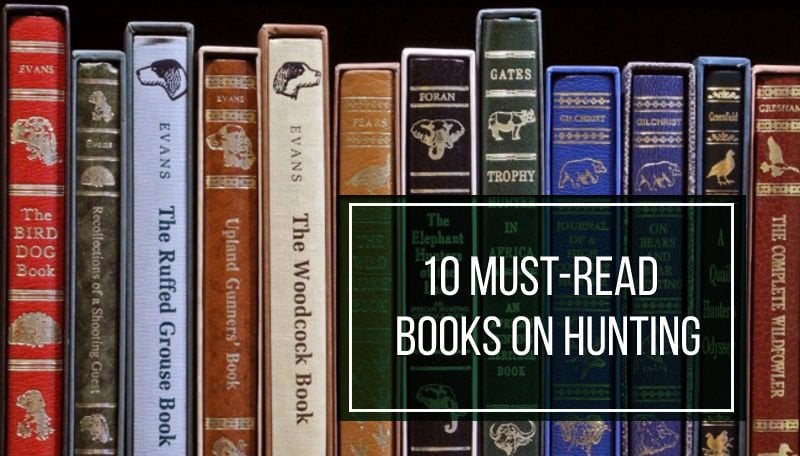
Conversations 10 Best Hunting Books – Every Hunter Should Read in 2023

- June 2, 2023
How to Guides A Beginner’s Guide to Saltwater Rods
You may also like.

A Guide To Choosing the Perfect Waterproof Boots

Understanding Different Types Of Fishing Line

Choosing the Right Hunting Dog for Your Needs & Hunting Style

Top 5 Brands for Western Clothing


Wild Turkey Cooking Guide: Delicious Recipes & Cooking Tips

How to Choose the Right Monocular for You

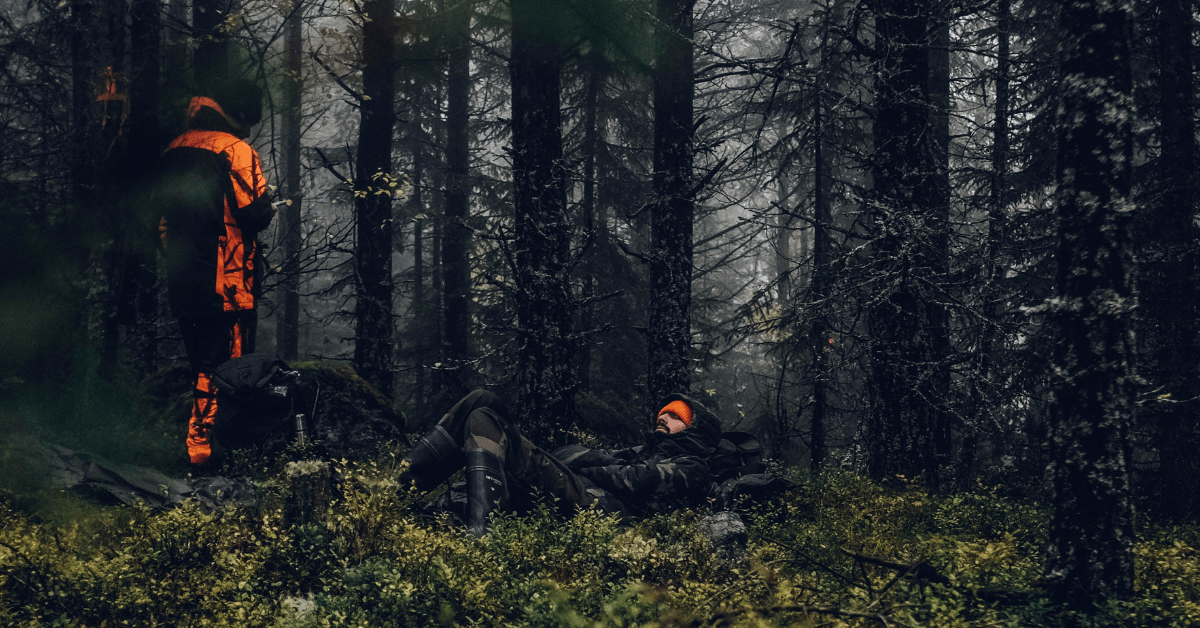
50+ Enticing Hunting Camp Breakfast, Lunch, And Dinner Ideas
Are you an outdoor enthusiast who loves hunting? Do you enjoy spending time in the wilderness, hunting for game, and spending the night in a cozy hunting camp? If so, then you know that food is a critical component of your hunting adventure. You need nutritious meals to fuel your body and keep you energized throughout the day.
In this beginner’s guide, we’ll share with you 60 hunting camp breakfast , lunch, and dinner ideas to help you plan your next hunting trip. From hearty breakfasts to filling dinners, we’ve got you covered.
Hunting Camp Breakfast Ideas
Starting your day with a nutritious breakfast is essential for a successful hunting trip. Here are some breakfast ideas to keep you energized throughout the day.
- Breakfast Burritos: Fill tortillas with scrambled eggs, sausage, cheese, and veggies for a hearty and portable breakfast. Wrap them in foil and reheat on a skillet or over a fire for a quick and easy breakfast.
- Biscuits and Gravy: Make homemade biscuits and top them with sausage gravy for a filling and delicious breakfast. You can prepare the biscuits ahead of time and reheat them on a skillet or over a fire.
- Eggs and Bacon: Cook eggs and bacon on a skillet or over a fire for a classic breakfast. You can also add veggies like onions, peppers, or mushrooms for extra flavor.
- Pancakes and Sausage: Make pancake batter ahead of time and cook them on a skillet or over a fire. Serve them with sausage for a hearty and delicious breakfast.
- Oatmeal and Fruit: Cook oatmeal on a stove or over a fire and add fresh or dried fruit for extra flavor and nutrition.
- French Toast and Ham: Dip bread in a mixture of eggs and milk, and cook on a skillet or over a fire. Serve with ham for a delicious and filling breakfast.
Hunting Camp Lunch Ideas
Lunch is a great opportunity to take a break and refuel for the afternoon. Here are some delicious and easy-to-prepare lunch ideas for your hunting camp .
- Sandwiches (Turkey, Ham, Tuna, or Chicken Salad): Pack sandwich ingredients and bread separately and assemble them at the hunting camp for a quick and easy lunch.
- Wraps (Chicken Caesar, Veggie, or Turkey and Cheese): Use tortillas instead of bread for a portable and delicious lunch option.
- Chili and Crackers: Make chili ahead of time and reheat it on a stove or over a fire. Serve with crackers for a filling and satisfying lunch.
- Hot Dogs and Chips: Cook hot dogs on a grill or over a fire and serve them with chips for a classic and easy lunch.
- Soup and Bread: Make soup ahead of time and reheat it on a stove or over a fire. Serve with bread for a comforting and filling lunch.
- Salad with Grilled Chicken: Prepare salad ingredients ahead of time and grill chicken on a skillet or over a fire for a delicious and nutritious lunch.
Hunting Camp Dinner Ideas
After a long day of hunting, a hearty dinner is just what you need. Here are some dinner ideas to satisfy your appetite and fuel your body for the next day.
- Grilled Steak and Potatoes: Grill steak and potatoes on a grill or over a fire for a delicious and filling dinner.
- Spaghetti and Meatballs: Cook spaghetti and meatballs on a stove or over a fire for a classic and satisfying dinner.
- BBQ Ribs and Corn on the Cob: Grill or smoke ribs and serve with grilled corn on the cob for a finger-licking dinner.
- Chicken Fajitas: Grill or sauté chicken with peppers and onions and serve with tortillas, cheese, and salsa for a flavorful and satisfying dinner.
- Campfire Stew: Combine beef, vegetables, and spices in a Dutch oven and cook over a fire for a hearty and comforting dinner.
- Fish and Chips: Fry or grill fresh-caught fish and serve with homemade chips for a delicious and satisfying dinner.
Hunting Camp Snack Ideas
Between meals, you’ll need some snacks to keep you going. Here are some easy-to-pack and nutritious snack ideas for your hunting camp.
- Trail Mix: Combine nuts, seeds, dried fruits, and chocolate for a filling and energy-boosting snack.
- Beef Jerky: Pack store-bought or homemade beef jerky for a protein-packed and portable snack.
- Fresh Fruit: Pack apples, bananas, oranges, or other fresh fruits for a healthy and refreshing snack.
- Cheese and Crackers: Pack cheese and crackers for a satisfying and delicious snack.
- Energy Bars: Pack store-bought or homemade energy bars for a quick and nutritious snack.
- Roasted Nuts: Roast nuts on a skillet or over a fire for a crunchy and satisfying snack.
Hunting Camp Dessert Ideas
No hunting trip is complete without some sweet treats. Here are some dessert ideas to satisfy your sweet tooth.
- S’mores: Roast marshmallows and sandwich them with graham crackers and chocolate for a classic and delicious dessert.
- Grilled Fruit: Grill peaches, pineapples, or bananas and serve with honey and whipped cream for a healthy and sweet dessert.
- Campfire Brownies: Make brownies ahead of time and warm them up on a skillet or over a fire. Serve with ice cream for a decadent dessert.
- Apple Crisp: Make apple crisp ahead of time and warm it up on a stove or over a fire. Serve with whipped cream or ice cream for a comforting and delicious dessert.
- Chocolate Fondue: Melt chocolate on a skillet or over a fire and dip fruits or cookies for a fun and indulgent dessert.
- Fruit Salad: Combine fresh fruits and serve with whipped cream or yogurt for a healthy and refreshing dessert.
Genius Make-Ahead Camping Meals Drinks
Staying hydrated is crucial during your hunting trip. Here are some drink ideas to keep you hydrated and energized.
- Water: Pack plenty of water bottles or a hydration bladder to stay hydrated throughout the day.
- Coffee or Tea: Brew coffee or tea on a stove or over a fire for a warm and comforting drink in the morning or afternoon.
- Hot Chocolate: Mix hot chocolate powder with hot water or milk for a sweet and warming drink.
- Sports Drinks: Pack sports drinks for a quick and easy way to replenish electrolytes and energy.
- Soda or Juice: Pack your favorite soda or juice for a refreshing and sweet drink.
- Beer or Wine: Enjoy a cold beer or a glass of wine after a long day of hunting (remember to drink responsibly).
Kitchen Tools and Equipment Required For Make-Ahead Camping Meals
Having the right kitchen tools and equipment can make your hunting camp cooking easier and more enjoyable. Here are some essential kitchen tools and equipment to pack for your hunting trip.
- Camp Stove or Grill: A portable camp stove or grill can help you cook meals easily and quickly.
- Dutch Oven: A Dutch oven is a versatile tool that can be used for cooking stews, roasts, and bread.
- Skillet or Griddle: A skillet or griddle can be used to cook pancakes, eggs, bacon, and other breakfast foods.
- Utensils: Pack spatulas, tongs, knives, cutting boards, and other utensils to help you cook and serve meals.
- Cookware: Pack pots, pans, and baking sheets to help you cook a variety of meals.
- Cooler: A good quality cooler can keep your food and drinks cold for several days.
- Propane or Charcoal: If you plan on using a grill or stove, don’t forget to pack propane or charcoal.
Frequently Asked Questions (FAQ)
1. what’s the best way to store food in a hunting camp.
A: Store your food in airtight containers or coolers to keep them fresh and prevent animals from getting to them.
2. Can I bring frozen food to a hunting camp?
A: Yes, you can bring frozen food as long as you have a way to keep it frozen until you’re ready to cook it.
3. How do I clean my kitchen tools and equipment in a hunting camp?
A: Use biodegradable soap and warm water to clean your kitchen tools and equipment. Rinse thoroughly and dry them before storing.
4. Can I cook over an open fire in a hunting camp?
A: Yes, you can cook over an open fire in a hunting camp as long as it’s allowed and safe.
5. What’s the best way to dispose of food waste in a hunting camp?
A: Pack out your food waste and dispose of it properly in designated areas or at home.
6. Do I need to bring my own firewood to a hunting camp?
A: It depends on the hunting camp rules and regulations. Some camps provide firewood, while others require you to bring your own.
Final Thoughts
In conclusion, preparing meals in a hunting camp doesn’t have to be a daunting task. With these 60 breakfast, lunch, and dinner ideas, snack and dessert ideas, drink ideas, and essential kitchen tools and equipment, you’ll be well-prepared to cook delicious and satisfying meals during your hunting trip.
Remember to follow food safety guidelines, store your food properly, and pack out your waste to keep the campsite clean and safe. Happy hunting and happy cooking!
Share this:
Leave a comment cancel reply.
Save my name, email, and website in this browser for the next time I comment.
Table of contents
Best Backpacking Meals & Food of 2024

Some of the links on this page are affiliate links
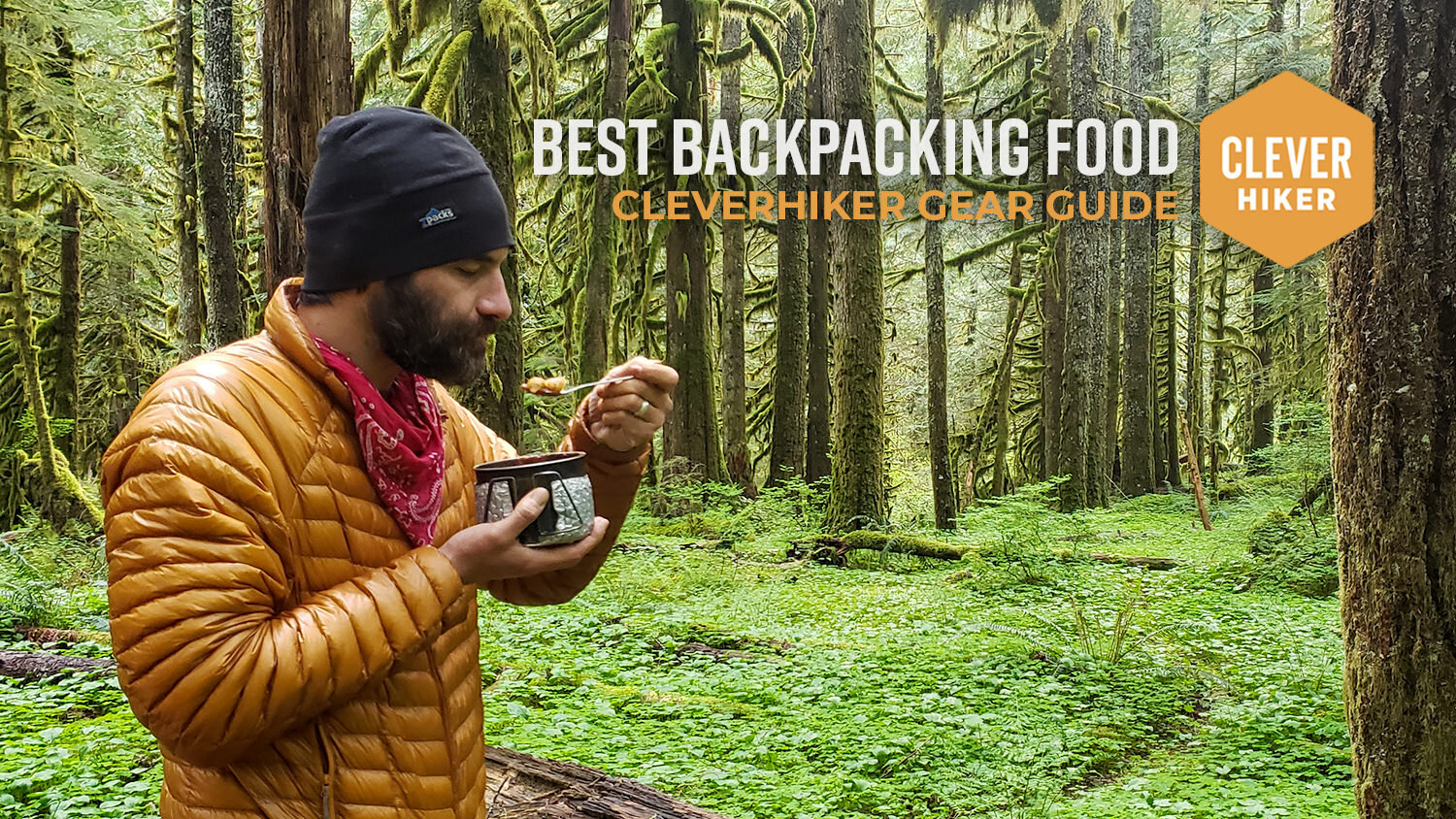
Backpacking Food
Meal planning is one of the most important considerations for any backpacking trip. The food you choose will depend on taste preference, nutritional value, caloric density of each meal, and how easy it is to cook.
Some hikers bring dehydrated meals because they’re quick and easy. Others prepare DIY dinner recipes and use a food dehydrator (check out our favorite DIY meals and dehydrator tips ) to make trail snacks.
Our approach is usually a mix of both methods, and in this post we’ll outline our general backpacking food strategy and suggest some of our favorite meals.
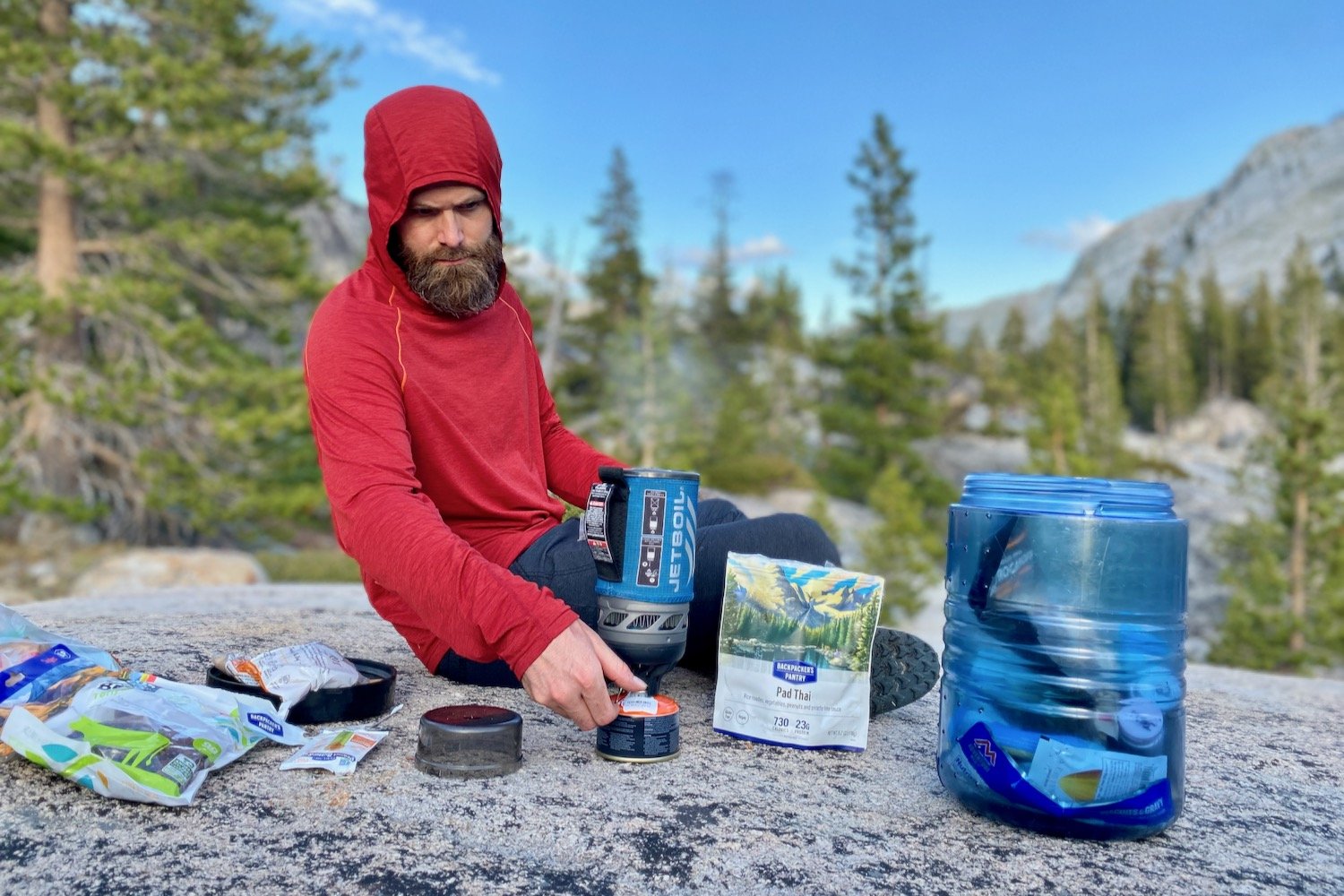
For backpacking, it’s important to keep food as lightweight and compact as possible
Ultralight Backpacking Food Video
As part of our Lightweight Backpacking Gear Basics video series , we put together the video below on ultralight backpacking food choices. Our specific food preferences have changed over the years, but the basic remain the same.
Backpacking Meal Tips
REPACKAGING FOOD – It’s always a good idea to repackage food in Ziploc bags to reduce bulk and have the ability to reseal containers. If you can’t close a food package securely, chances are it will explode in your pack and make a big mess.
SPICES & CONDIMENTS – Eating too much of the same thing over the course of a 5-day backpacking trip gets old quickly. Small packets of salt, pepper, olive oil, hot sauce, and fast food condiment packets (mayo, mustard, etc) can really elevate your backcountry grub. If you want to get real fancy, you can even get a GSI Spice Missile to carry up to six spices for less than 2 oz.
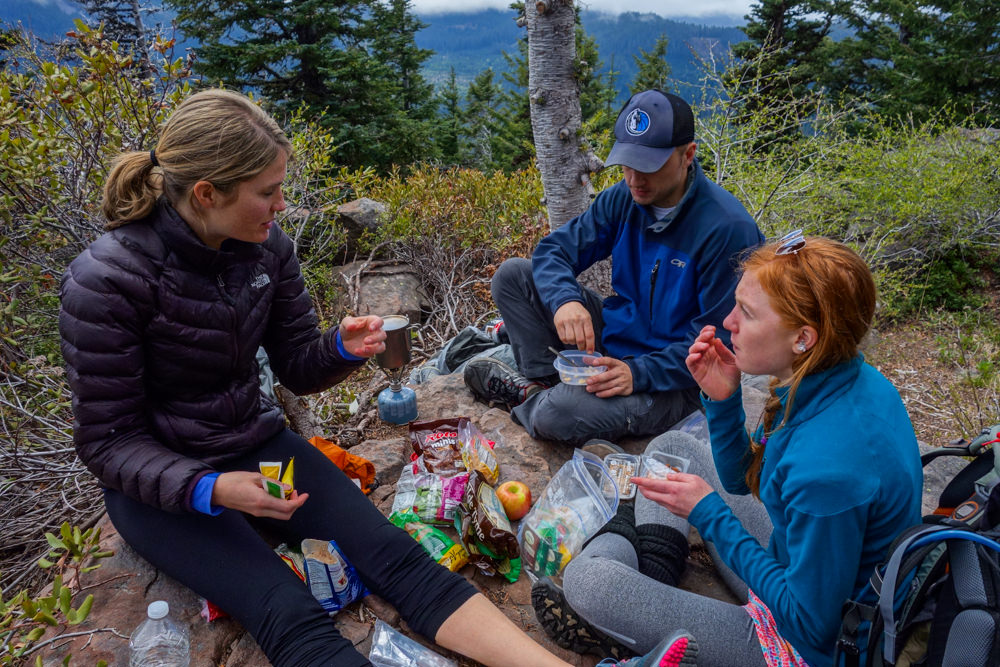
It’s good to bring along a variety of snacks, so you don’t get stuck eating the same thing every day.
FRESH FOODS – We love bringing a couple pieces of fresh fruit, like apples and oranges, on the trail. Fresh fruits have poor calorie per ounce ratios, but they’re a great treat in the backcountry and we like the added nutritional value. Carrots and snap peas are a nice healthy treat that will last a couple days if temperatures aren’t too hot.
AVOID CANNED FOODS – We always avoid canned foods because they’re way too heavy, don’t have enough calories, and create bulky trash to pack out.
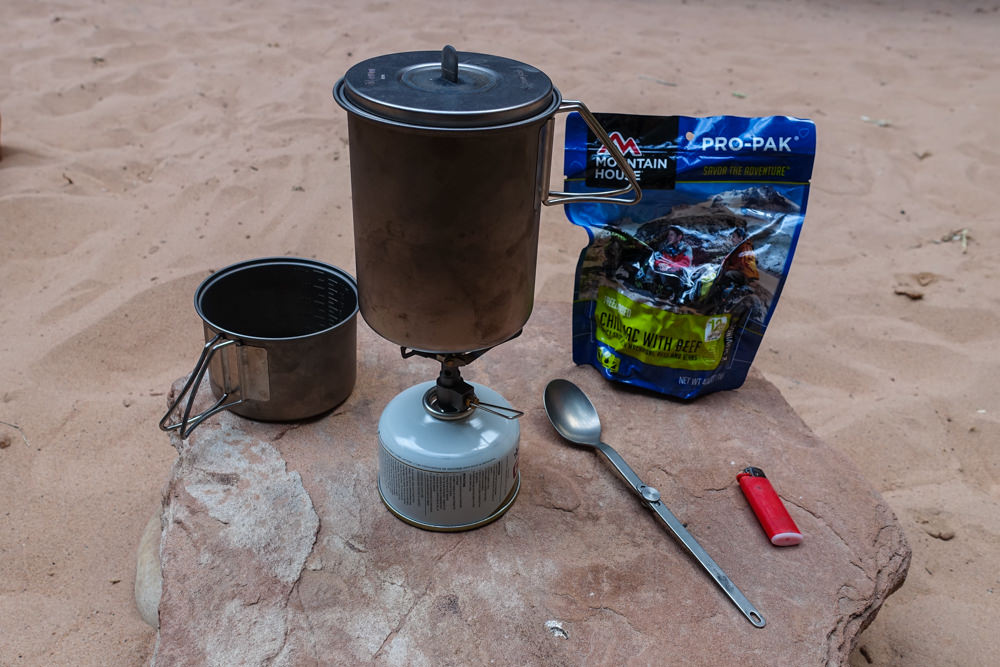
Dehydrated meals are quick and convenient, but they cost more than DIY meals .
DIY DEHYDRATED MEALS – If you have the time and energy, it can be nice to make your own trail meals and dehydrate your own snacks. A quality food dehydrator will quickly zap the water out of fruits, veggies, and meats for some awesome DIY trail grub.
HOT DRINKS – Warm beverages and soups are a really nice treat in the backcountry, especially on chilly trips where it’s harder to stay hydrated. We like to sip on tea , cider , and hot cocoa around camp when the temperature dips.
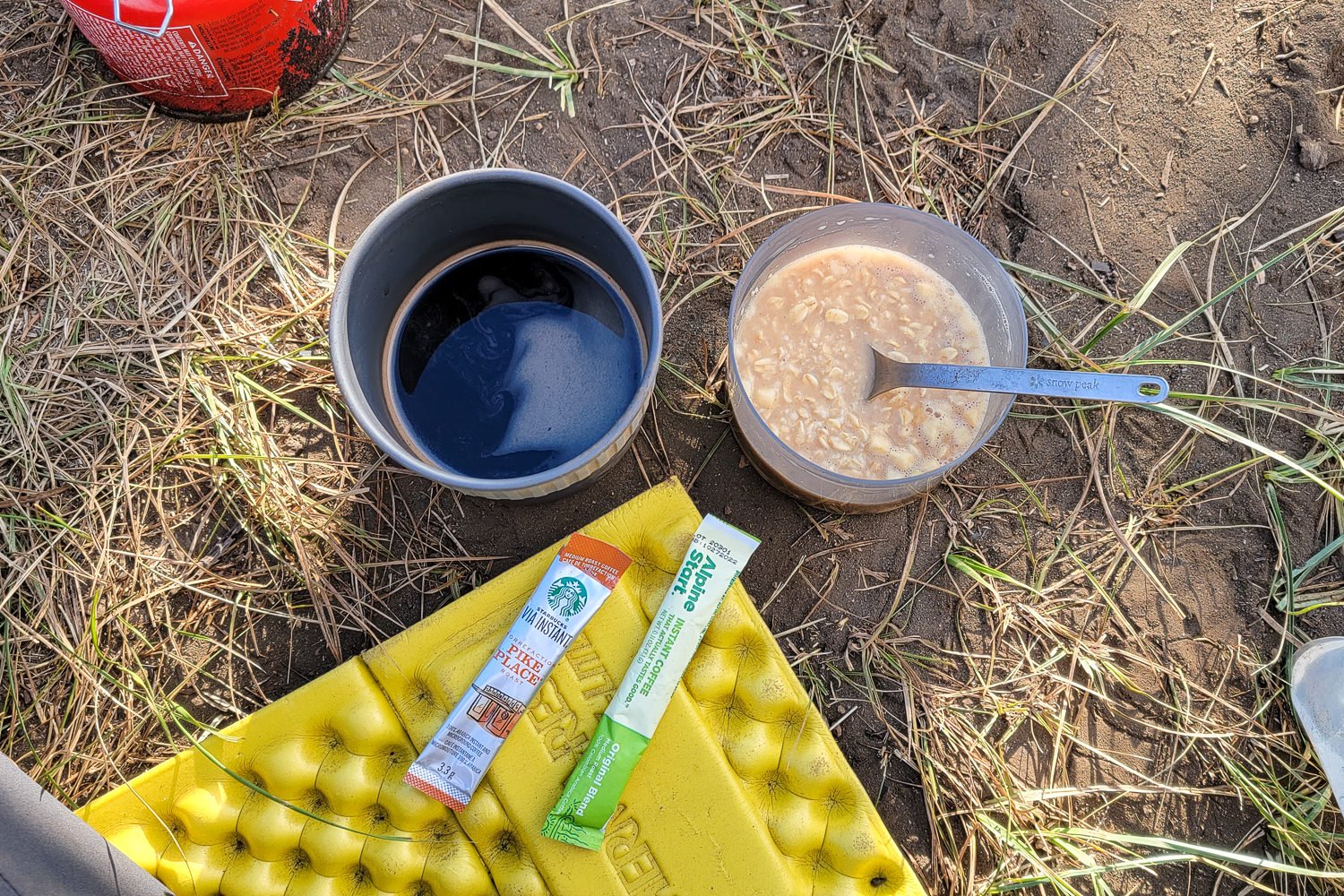
If you’re a coffee drinker, make sure to check out our list of the Best Coffee Makers for Backpacking
ALCOHOL – Generally speaking, it’s not good to drink alcohol right before going to bed. Not only can it disrupt your sleep cycle, but you may also have to use the bathroom more during the night. That said, whiskey and wine tend to make our pack lists on most trips, especially on casual treks with friends. We carry them in trusty, lightweight containers like the Platypus Wine Bag and Flask2Go .
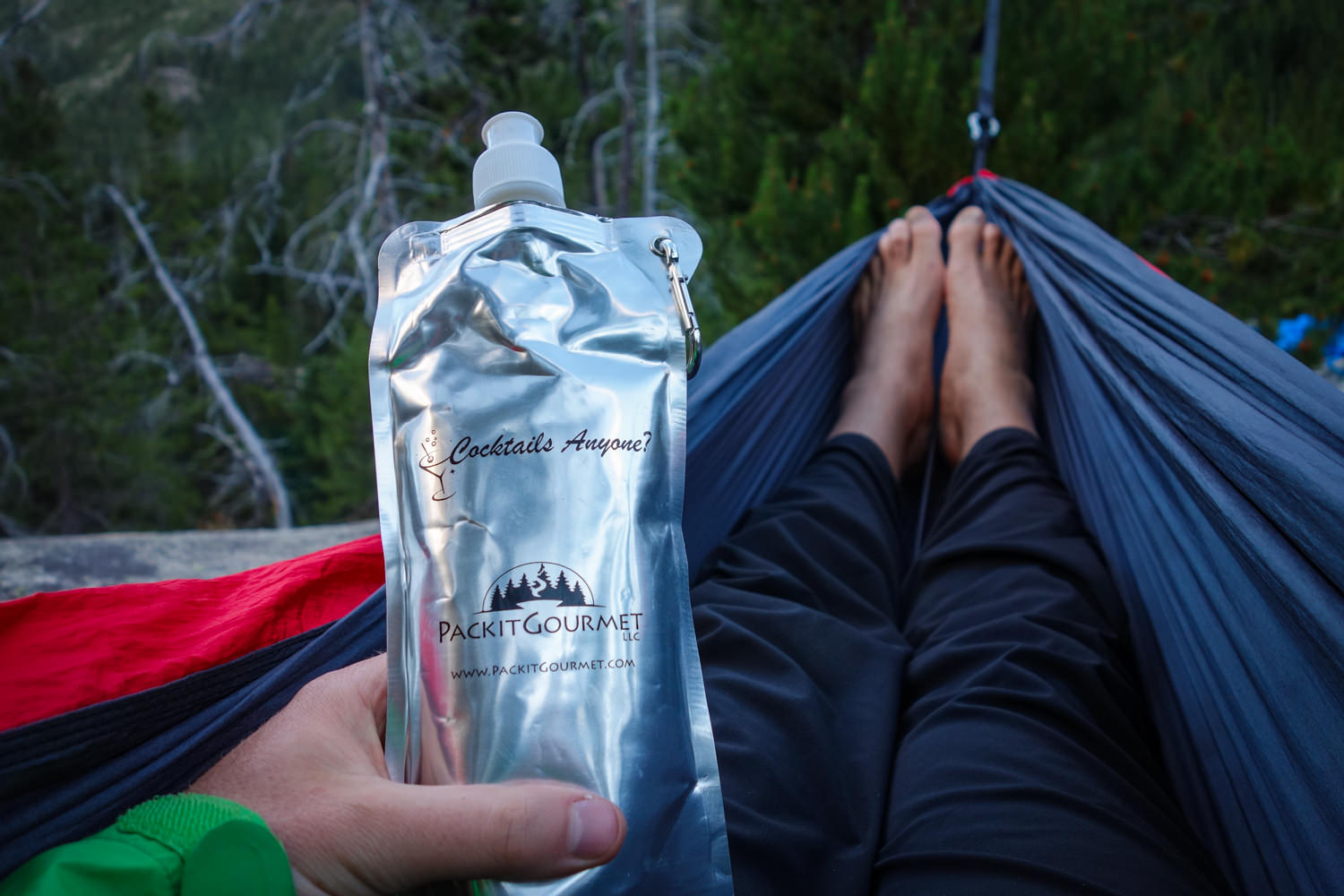
Cocktails Anyone?
Backpacking Meal Suggestions
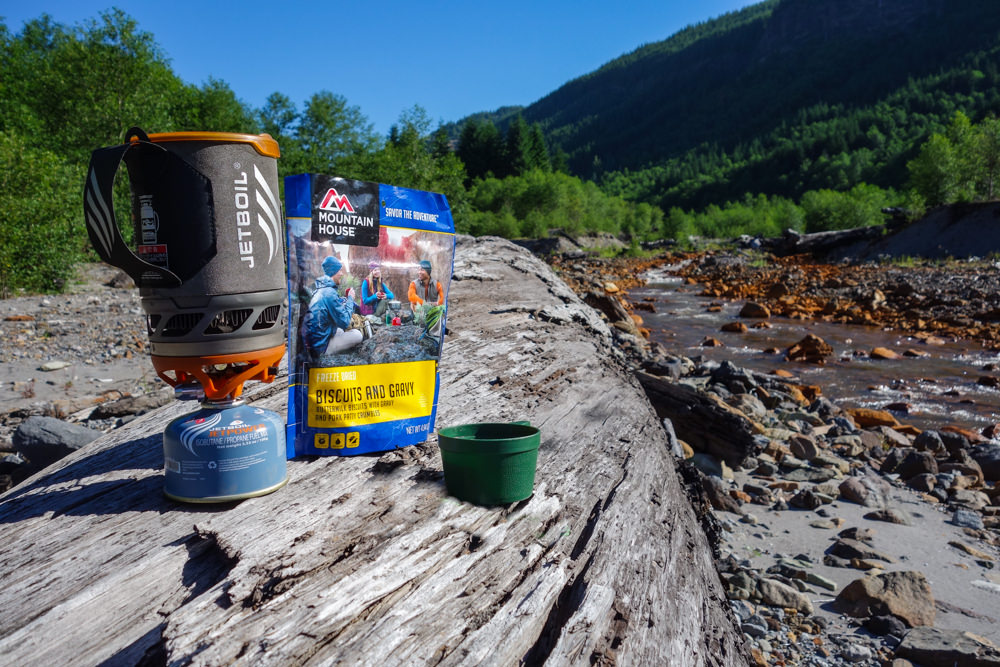
We almost always start our trail mornings off with a warm cup of coffee . After testing many coffee powders, cubes, bags, and brew styles, our favorite option for taste and convenience is Starbucks Via . We usually have a quick, cold breakfast with our coffee and break camp to hit the trail early – mornings in the wilderness are so peaceful.
Pairing coffee with a calorically dense bar or two is a good way to get some quick energy in the morning. For additional calories, we may munch on some trail mix or mow a packet of almond butter. On casual, low-mileage trips, we like to enjoy warm breakfasts with friends. We’ll usually pair instant oatmeal with some dried fruits and trail mix. Here’s a list of our go-to breakfast choices with links to our favorites:
- Coffee ( Starbucks Via )
- Tea ( Celestial Seasonings – Bengal Spice )
- Bars ( Larabar , Clif Bar , ProBar , Ivan Bar , Luna , Kind , Bobo’s )
- Granola & Cereal ( Bear Naked )
- Powdered Milk ( Nido or Grace Coconut Milk Powder )
- Breakfast Drink Mix Packets ( Carnation )
- Nuts and Seeds ( Almonds , peanuts , etc.)
- Almond Butter Packets ( Justin’s )
- Peanut Butter Packets ( Justin’s )
- Instant Oatmeal ( Quaker )
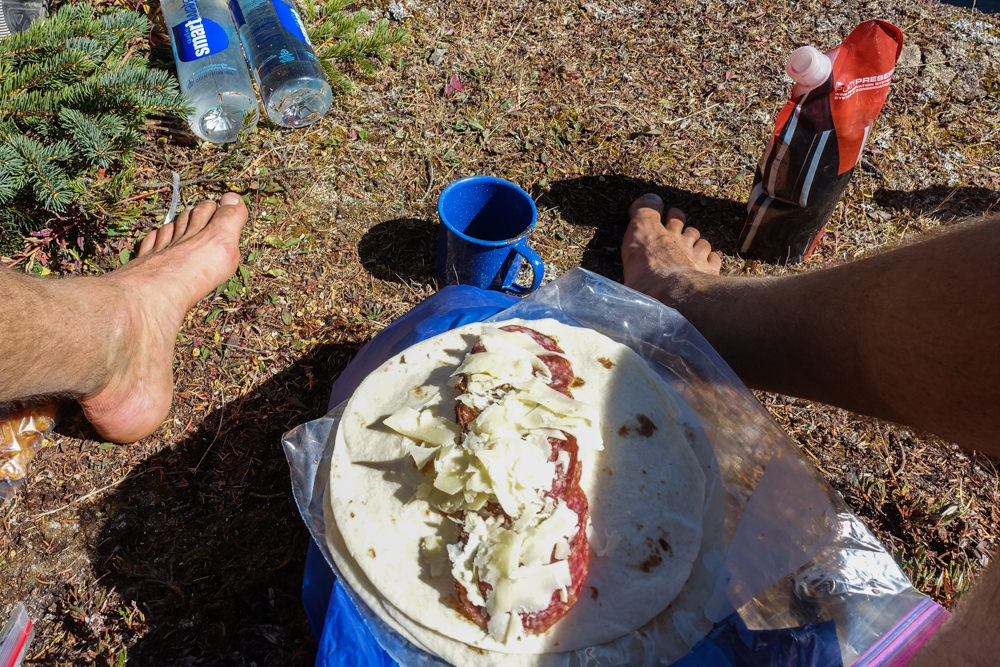
We almost always have a cold lunch on the trail to avoid the time, effort, and fuel required for cooking. We commonly make tortilla or bagel sandwiches with hard meats and cheeses. Bagels and tortillas tend to hold up well on the trail and provide relatively dense calories. Hard meats and cheeses will easily last a few days, though they’re not great choices for hot weather trips.
Peanut butter, jelly, honey, and foil packets of tuna or chicken are also good sandwich fillers. With foil packets, we’ll mix up tuna or chicken with fast food condiment packs (mayo, mustard, etc.) and make tuna/chicken salad sandwiches.
If we’re still hungry after a sandwich, we munch on some snacks to round out lunch. Here’s a list of our go-to lunch choices with links to our favorites:
- Bagels or Tortillas ( Thomas Bagels , Mission Tortillas )
- Hard Meats – Salami, Summer Sausage, etc. ( Applegate )
- Hard Cheese – Parmesan, Romano, etc.
- Jelly or Honey ( Nature Nate’s )
- Tuna or Chicken in foil packets ( StarKist )
- Dried Pork Packets ( Meat Shredz )
- Small Condiment Packets – Mayo, Mustard, Relish, Hot Sauce, etc.
- Supplement with other snacks (more snack info below)
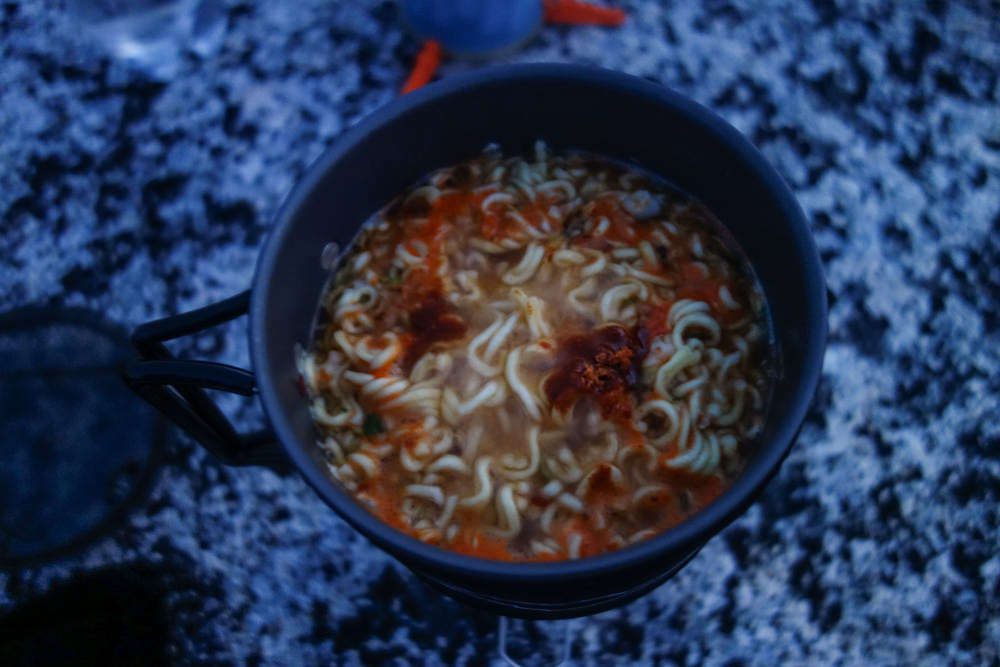
Freeze dried meal pouches ( Mountain House , MaryJanesFarm , Good To-Go , PackIt Gourmet , PEAK Refuel, etc.) are a convenient, lightweight, and tasty option for backpacking dinners. For some of our favorites, check out our Best Freeze Dried Backpacking Meals list. When we’re on casual trips with friends, we like to pick a few of our favorites for dinner. Most freeze dried meals cost around $7-12 and feed two hikers, though your mileage may vary.
The main downside with freeze dried meals is they tend to be much more expensive than DIY options. If you’re on the trail a lot (thru-hiking, etc.), the cost of freeze dried meals will add up quickly. Any supermarket will have other “just add water” options (instant potatoes, ramen, etc.) that cook quickly and cost a fraction of the price . Here’s a list of our go-to dinner choices with links to our favorites:
- Freeze Dried Dinners (Some of our faves: Chicken and Dumplings , Biscuits and Gravy , Beef Stroganoff , Chili Mac , Thai Chicken Coconut Curry )
- Instant Mashed Potatoes ( Idahoan )
- Ramen ( Maruchan )
- Instant Soups
- Instant Mac & Cheese ( Annie’s )
- Pasta and Rice Sides ( Knorr )
- Chicken Packets ( StarKist )
- Tuna Packets ( StarKist )
- Dehydrated Vegetables ( Augason Farms )
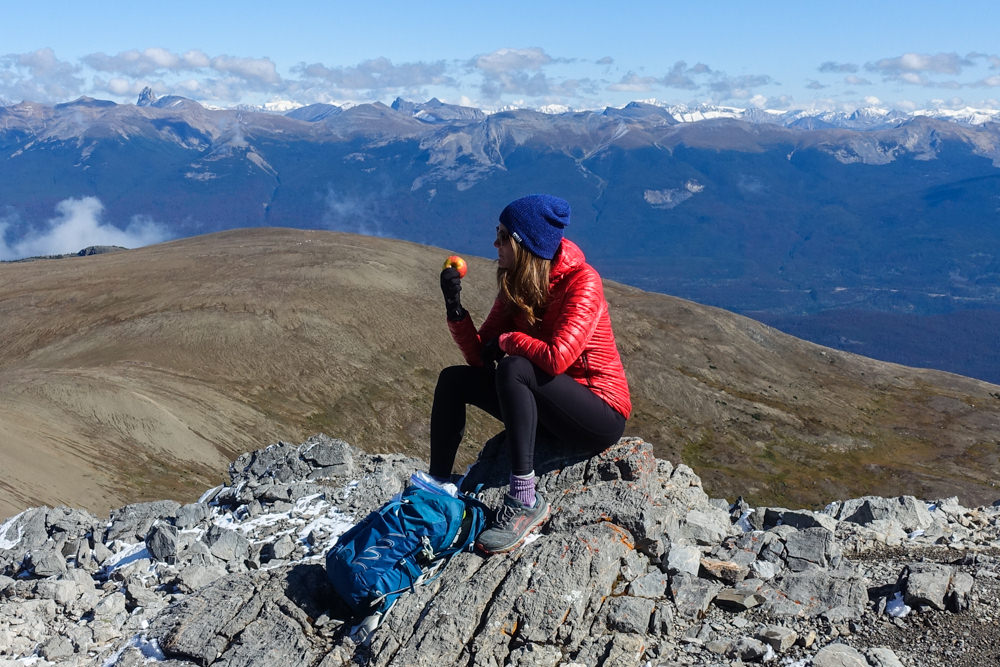
Snacks are a critical part of any good trail diet. You’ll be burning a ton of calories on long hiking days, so eating a small snack every hour or two is a good way to keep your engine running. We always keep a few snacks in our hip belt pockets while we hike for easy access.
In hot weather, we try to avoid things that melt, like granola bars with an outer layer of chocolate. Trader Joe’s has some delicious and relatively affordable options for backpacking snacks. Here’s a list of our go-to trail snacks with links to our favorites:
- Dried Fruit ( Mango , Apple , etc.)
- Fruit Leather Strips ( Solely )
- Jerky ( Jack Link’s )
- Crackers ( Triscuits , Goldfish , Ritz , etc.)
- Candy ( Snickers , Peanut Butter M&Ms , Chocolate Almonds , etc.)
- Hydration mixes
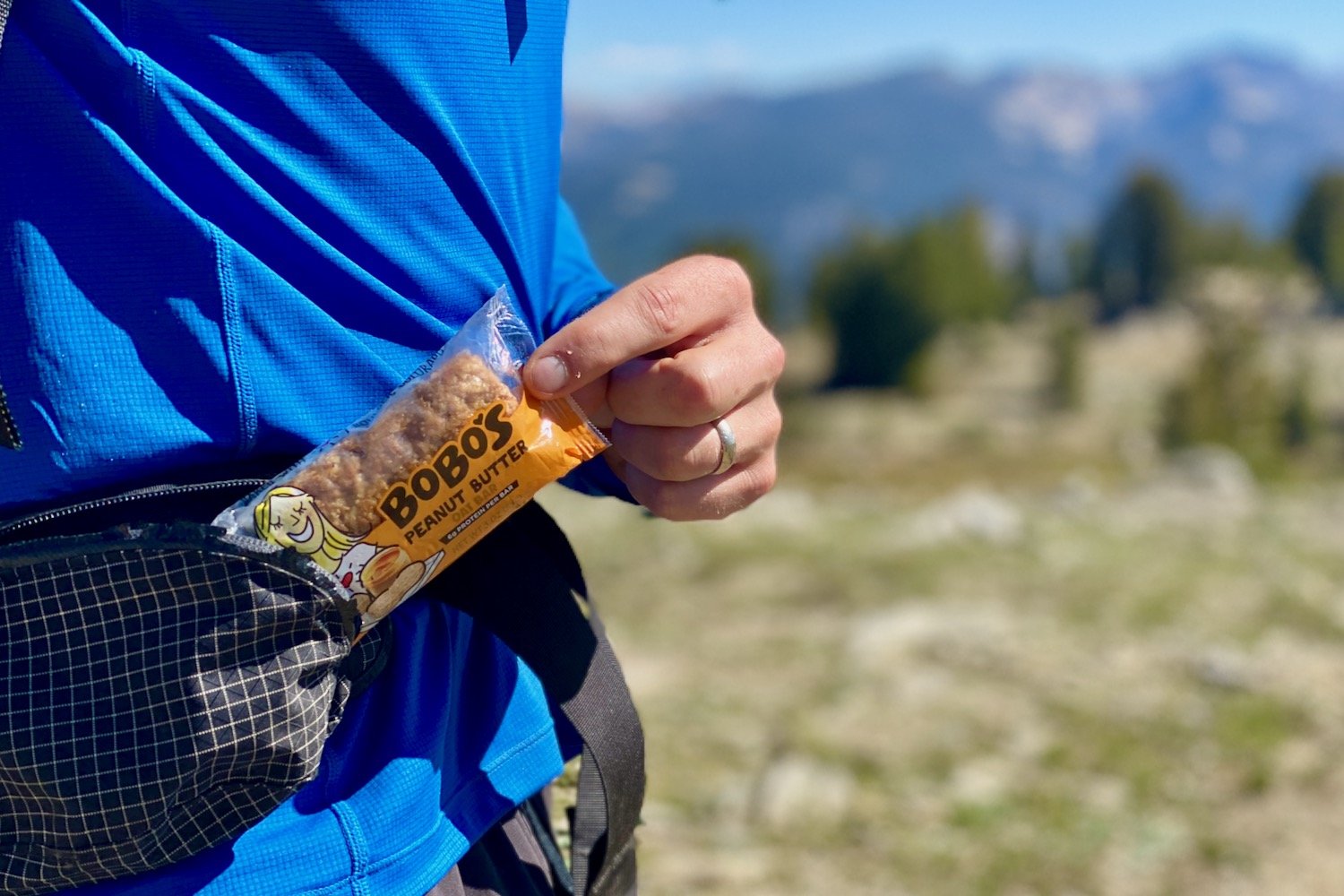
Check out our list of the Best Energy Bars to take the guess work out of snack shopping for your next adventure
What’s in Our Camp Kitchen?
When we head out on backcountry trips, these are the items usually found in our packs. For more information on our favorite gear, check out the CleverHiker Backpacking Gear Guide and our Best Backpacking Stoves list.
- Stove System: JetBoil MiniMo
- Ultralight Stove: MSR Pocket Rocket 2 & BRS Stove
- 1-2 Person Cookpot: Snow Peak Mini Solo Cookset
- Group Cookpot: MSR Titan Kettle
- Spoon: Sea to Summit Alpha Light Long Spoon
- Cup: Snow Peak Titanium Single 450
- Food Storage: Ursack & BearVault BV500
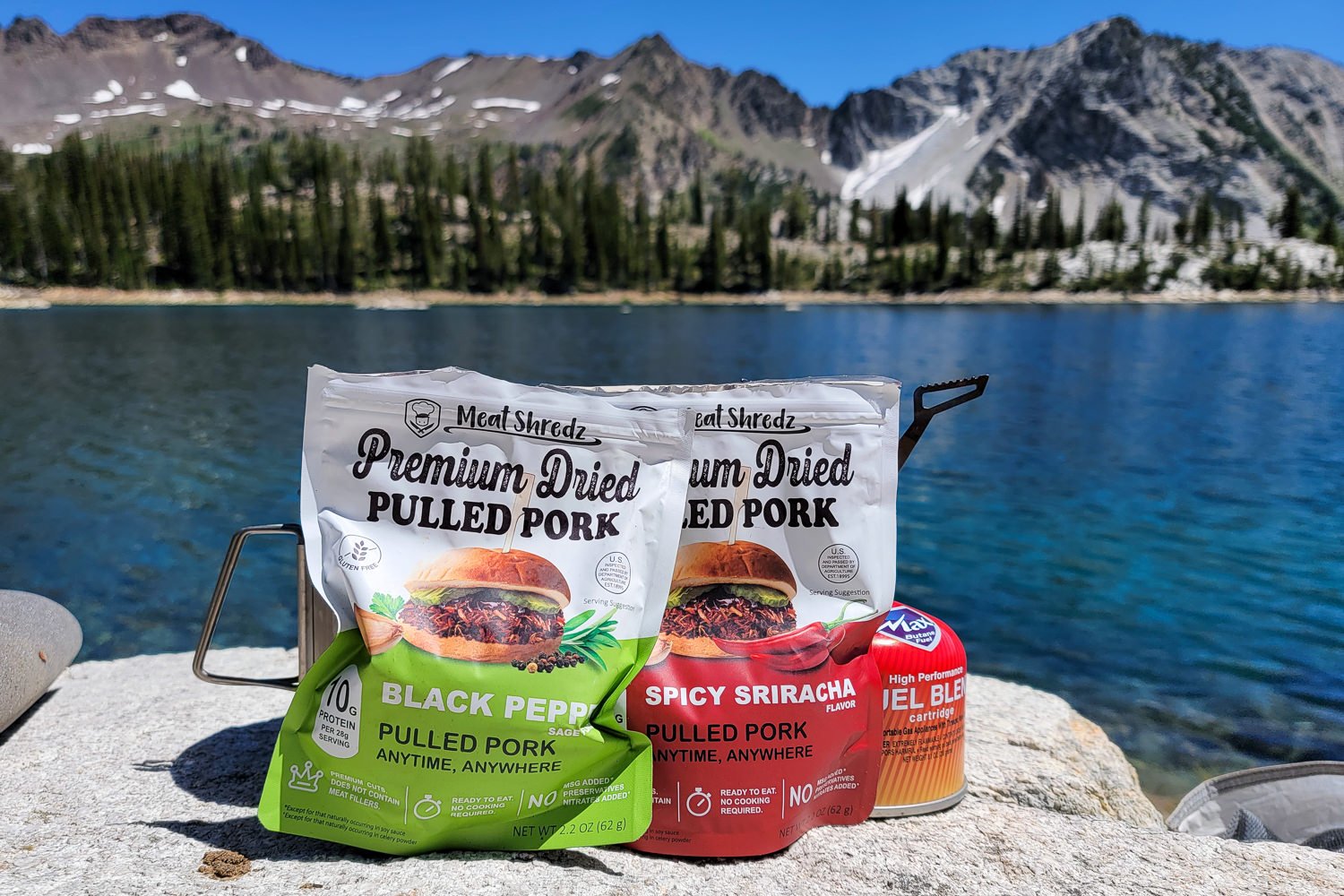
These Dried Pulled Pork Packets ( Meat Shredz ) make excellent backcountry tacos, ramen, and more!
Critical Food Considerations
LEAVE NO TRACE – You love nature. That’s why you’re out there and that’s why you’re reading this post. So please, always pack out your trash and any food you don’t eat. Yes, truly following LNT rules includes packing out things like spent coffee grounds, orange rinds, and apple cores. Always scan your campsites and lunch spots before hiking on, and if you’re a true LNT rockstar, help pack out trash left behind by other backcountry travelers. Check out our LNT tutorial video for a quick refresher.
FOOD STORAGE – Proper food storage is incredibly important for protecting wildlife . For example, bears that learn to associate humans with food often need to be trapped and killed. So please, always store your food properly in the backcountry. We hesitate to even teach proper bear bagging techniques anymore, because most hikers don’t take the time to do it properly. And even if they do, really smart bears can still bring down a good bear hang. The safest bet for backcountry food storage is an Ursack or Bear Canister .
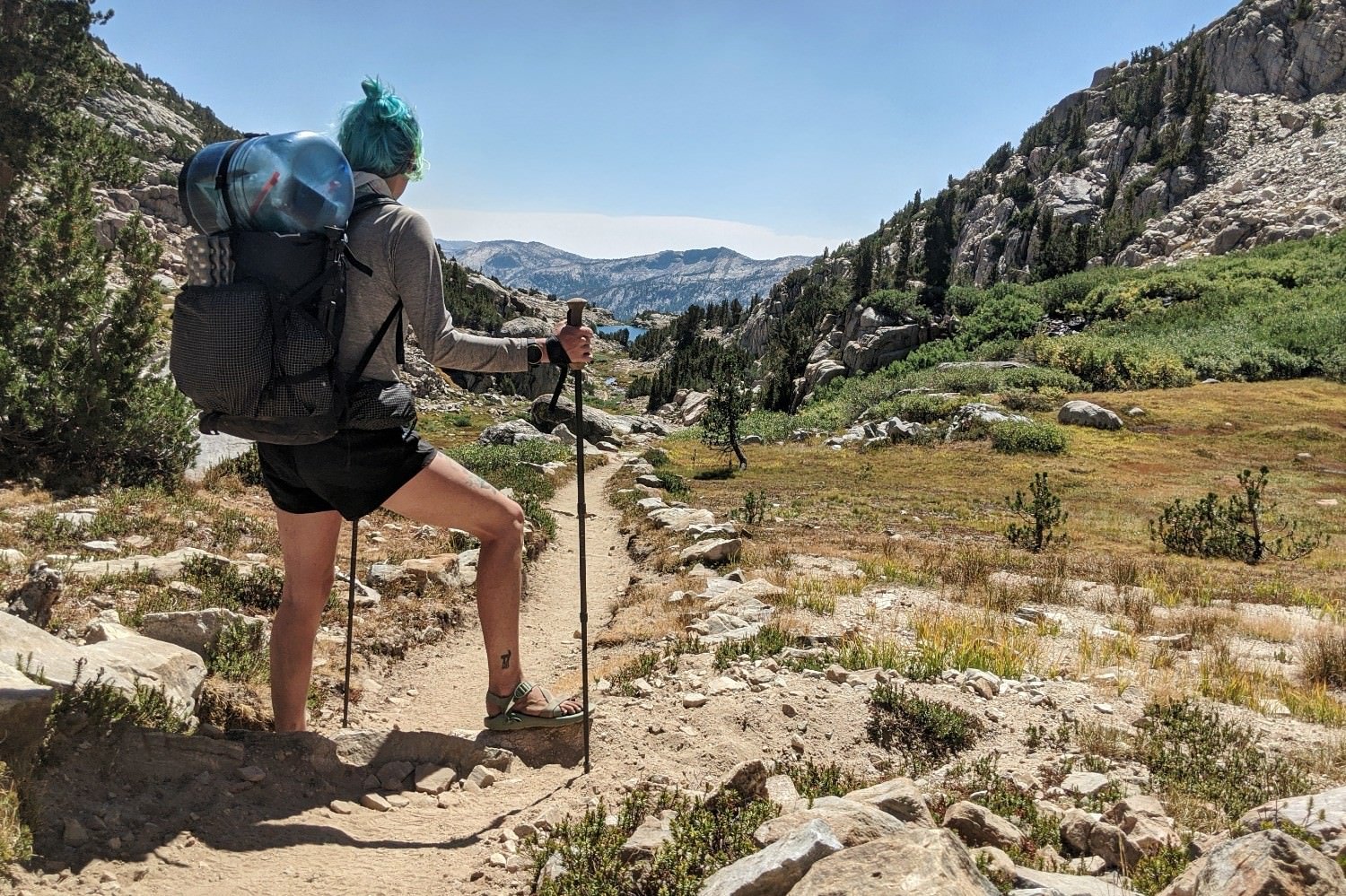
Bear Canisters are required in some areas, so make sure to check regulations well in advance of your trip
CALORIE INTAKE – Backpackers burn a lot of calories on the trail. On average, hikers usually burn between 3000-4000 calories per day, but thru-hikers hiking 20-30 mile days can easily burn 5000-6000 calories. It’s crucial to pack enough nutrients to give your body the energy it needs. This important calculation will also depend on your size, weight, age, and activity level.
WEIGHT – Bringing too much food is one of the most common beginner backpacking mistakes . And that’s understandable, who wants to risk going hungry in the woods? But carrying a bunch of unnecessary weight can quickly dampen spirits on backpacking trips, so a little experience and pre-trip calorie calculation will go a long way.
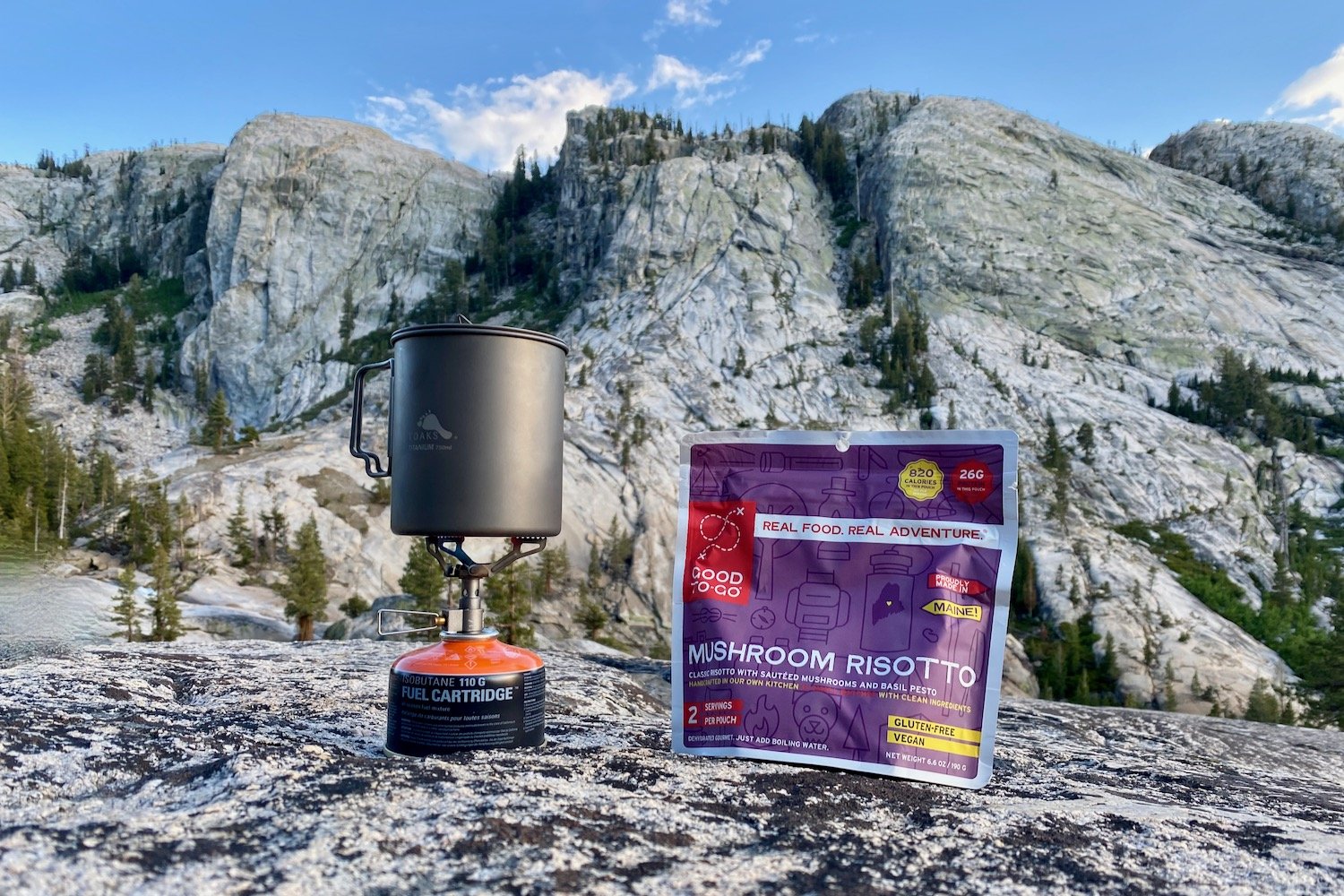
Freeze Dried Meals can be a great option when weight savings and convenience are your top priorities
CALORIC DENSITY – It’s important to consider how calorically dense your backpacking food choices are to keep your pack weight down. High-fat foods like olive oil, nuts , peanut butter , and chocolate tend to have high calorie-per-ounce ratios. On the other hand, fresh fruits and vegetables tend to have low calorie-per-ounce ratios. The ideal range is around 120-130 calories-per-ounce total.
FOOD VOLUME – Certain foods will take up a lot more space in your pack than other foods containing the same amount of calories (think bagels vs almonds ). This isn’t a big deal on short trips, but on long journeys, and especially when bear canisters are required, you’ll want to pay close attention to how much space your food choices will take up.
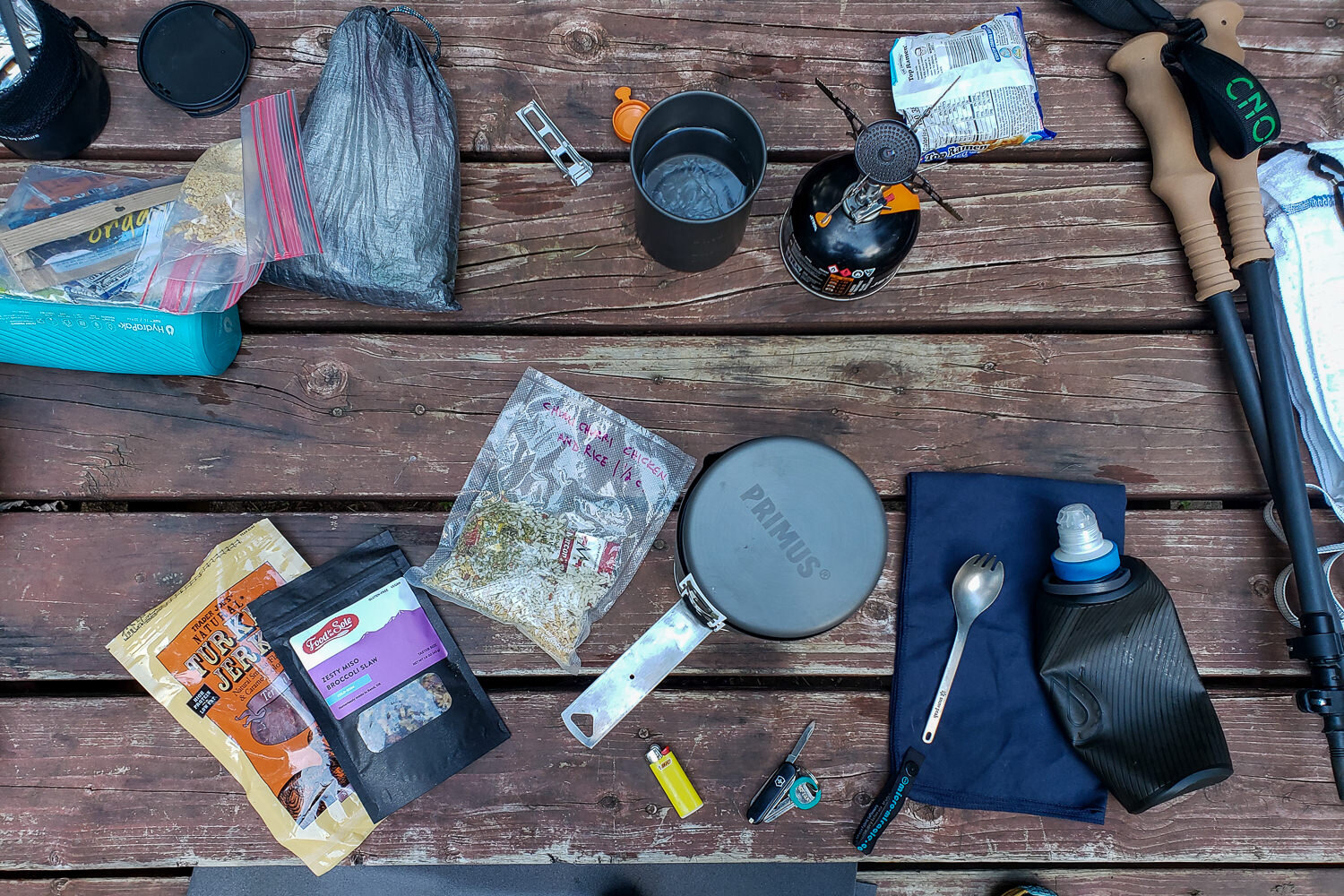
NUTRITION – Good nutrition on the trail is just like eating right at home. You’ll want a balance of fats, proteins, and carbohydrates while getting as much fiber, fruits , and vegetables into your diet as possible. It’s hard to eat really healthy on the trail because processed foods tend to be much more convenient, but finding a good balance is key. Also, we always load up on fresh, healthy foods the moment we’re back in town.
CONVENIENCE – After a long day of hiking, chances are you won’t want to prepare an elaborate meal. Nor will you want to clean up a bunch of dirty dishes when you’re done eating. So we recommend keeping it simple. For dinners, this means we almost always eat “just add water” meals, and for breakfast, we usually have hot coffee with bars and snacks.
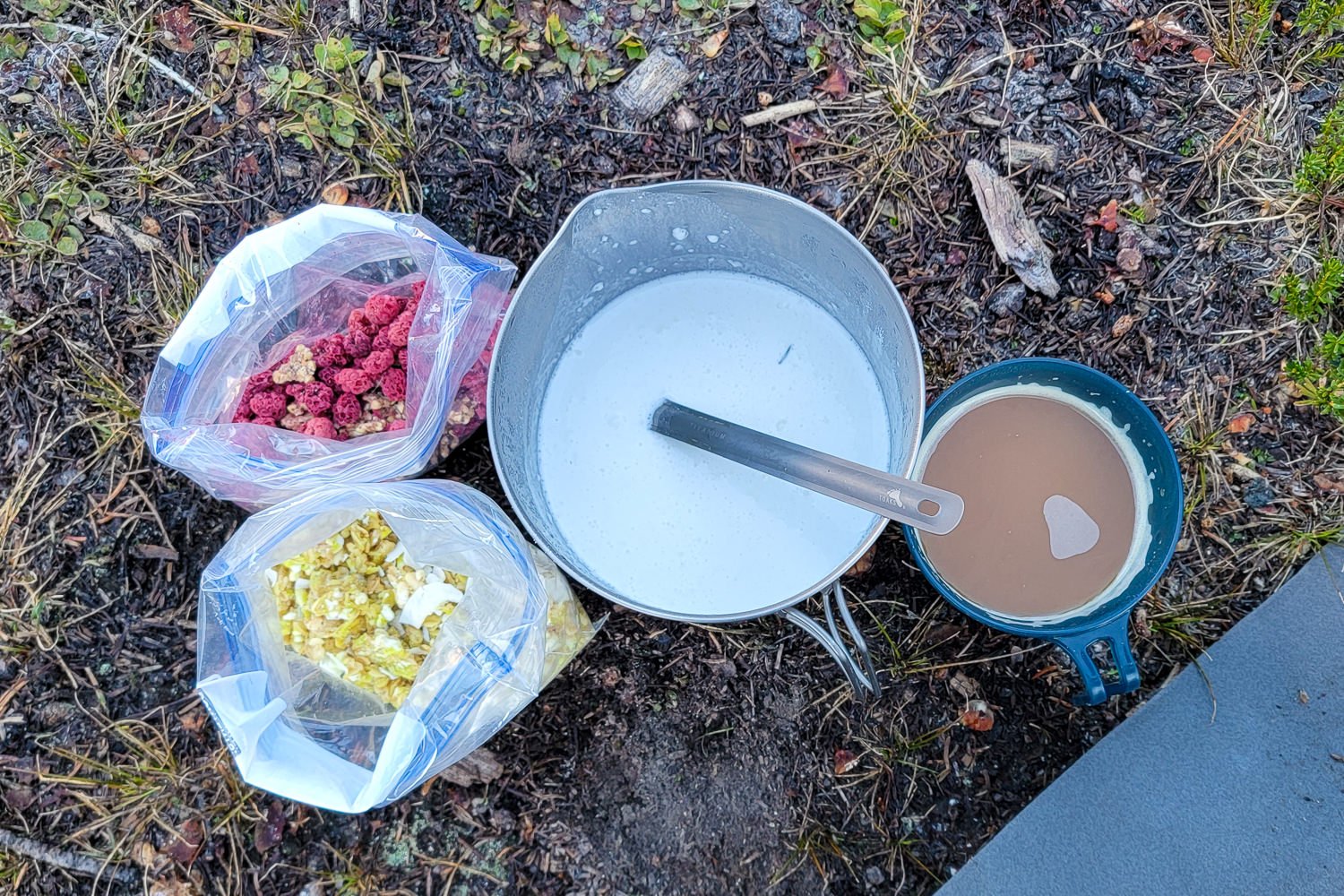
Granola with toppings is a fast and easy trail breakfast – we like to eat it with powerdered coconut milk
WATER ACCESS – If your dinners require water for cooking, you’ll want to camp near a water source or make sure to pack plenty of water for a dry camp. If you’re backpacking in an area with scarce water, make sure to plan accordingly.
FUEL – Most backcountry meals require a small stove for cooking – check out our Best Backpacking Stoves list to see our favorites. Plan out how many times you’ll need to cook (including coffee and tea ) to calculate how much fuel to bring. Fuel usage rates vary depending on the stove model, pot size, elevation, and temperature, so knowing exactly how much fuel to bring will take some experience. On an average 5-day, two-person backpacking trip, we usually boil water about 10 times (once for morning coffee and once for dinner), and one small 100 g isobutane fuel canister is usually more than enough.
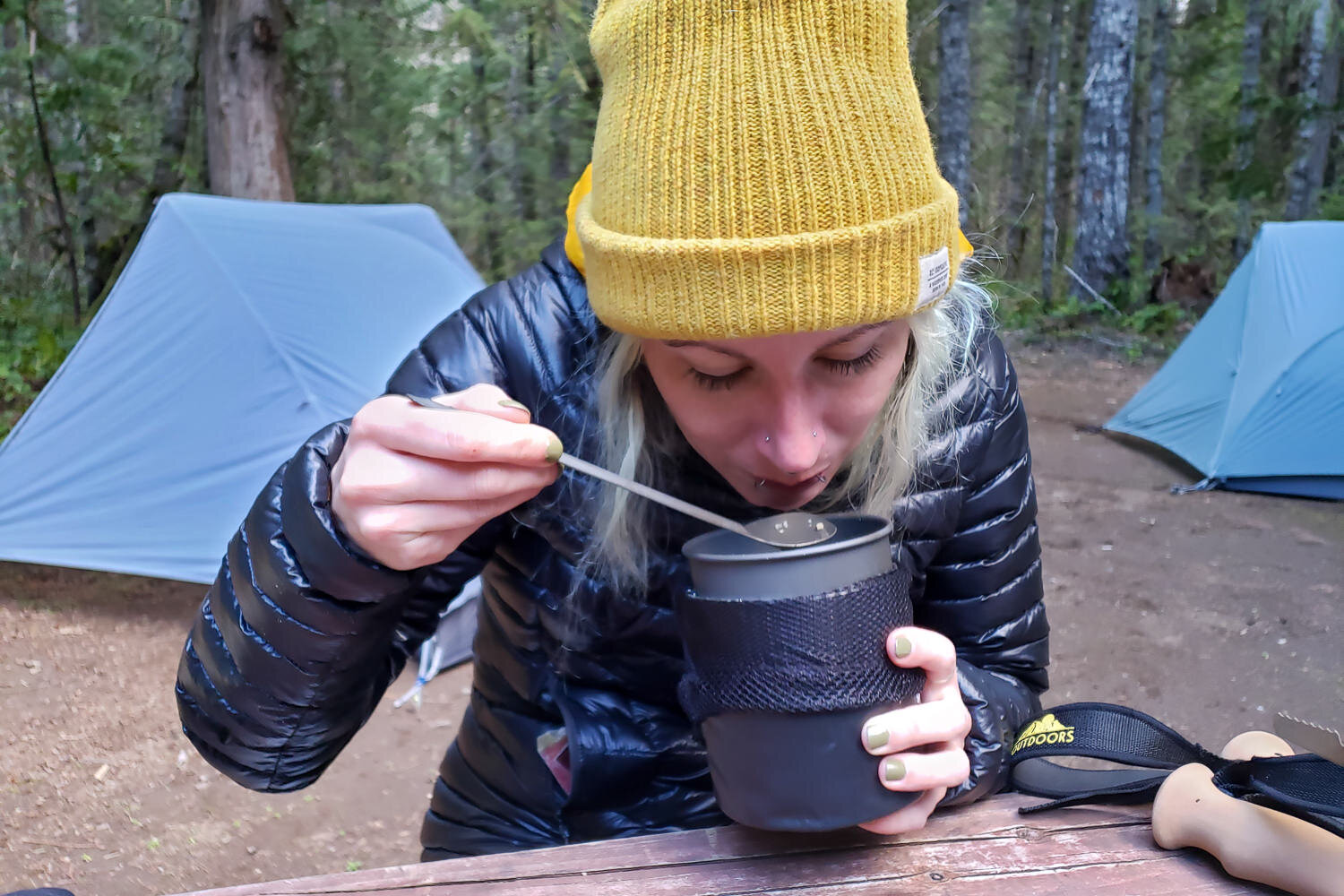
COST – You’ll usually pay for convenience with backpacking food. Freeze dried meals tend to cost around $7-12 each, but they’re also tasty, convenient, and don’t require any cleanup. We enjoy Mountain House , MaryJanesFarm , Packit Gourmet , Backpacker’s Pantry , PEAK Refuel , and Good To-Go when we’re not preparing our own meals.
VEGAN & VEGETARIAN MEALS – If you’re looking to spice up your animal-free backpacking food options, don’t miss our list of the Best Vegan and Vegetarian Backpacking Meals .
Need More Gear Advice?
If you liked this list, you’ll love the CleverHiker Gear Guide where we test and recommend tons of outdoor adventure gear from a variety of categories. here are some links to popular articles:
- 10 Best Hiking Shoes
- 10 Best Backpacking Tents
- 10 Best Sleeping Bags
- 10 Best Sleeping Pads
- 10 Best Backpacking Packs
- 10 Best Backpacking Stoves
- CleverHiker Top Gear Picks
More Information
We hope this guide helps you find the perfect gear for your needs. If you have more questions or a suggestion, we’d love to hear from you! Sign up for our newsletter to stay updated on our latest posts then visit our Facebook page and Instagram to join the community conversation.
If you found this guide helpful, please give it a share on social media! Also, be sure to check out our CleverHiker Gear Guide to see all of our top gear picks.
Thanks for reading and happy trails!
Some of the links on this page are affiliate links, which means we may receive a modest commission if purchases are made through those links. This adds no cost to our readers and helps us keep our site up and running. Our reputation is our most important asset, which is why we only provide completely honest and unbiased recommendations.
Need More Backpacking Advice?
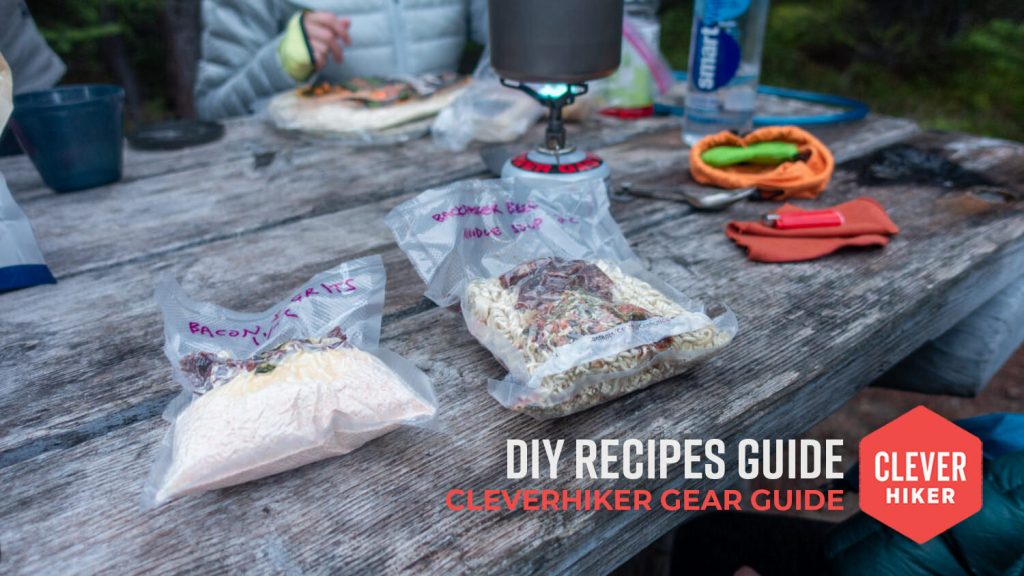
Backpacking Meal Recipes & How to Dehydrate Food for Camping
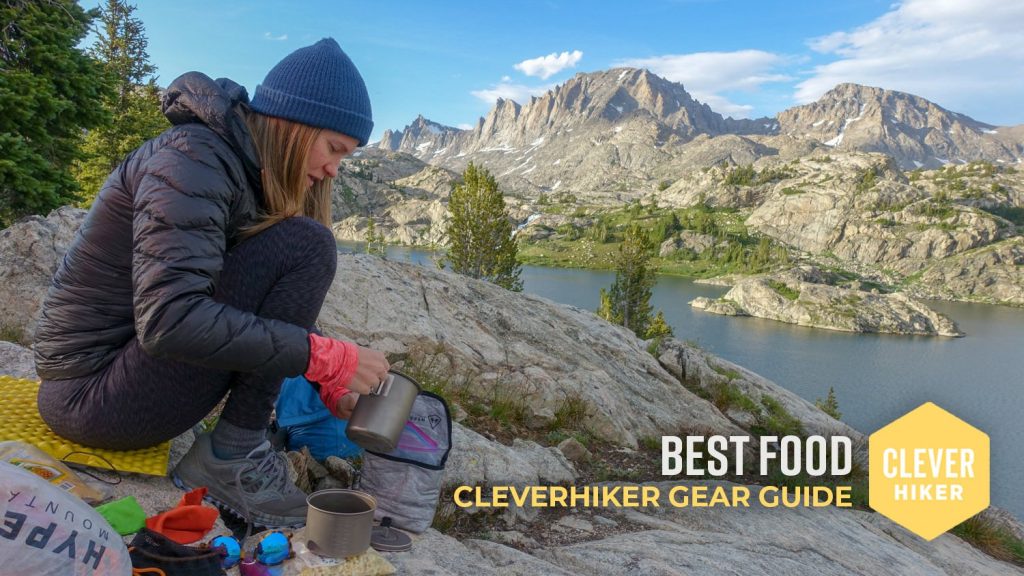
Best Backpacking Food
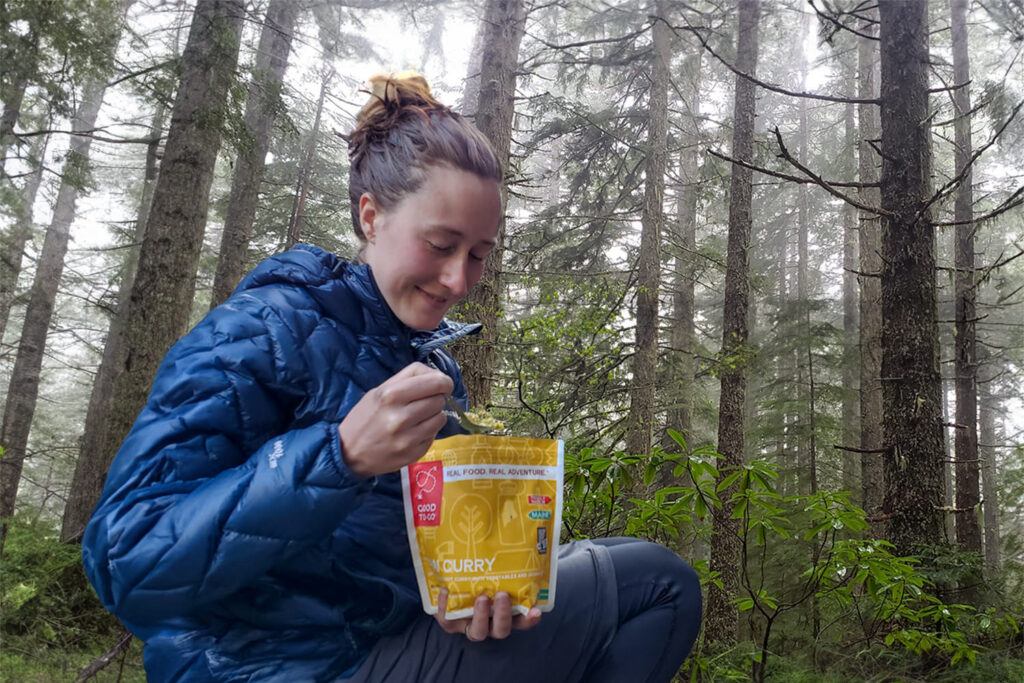
Best Backpacking Freeze Dried & Dehydrated Meals of 2024
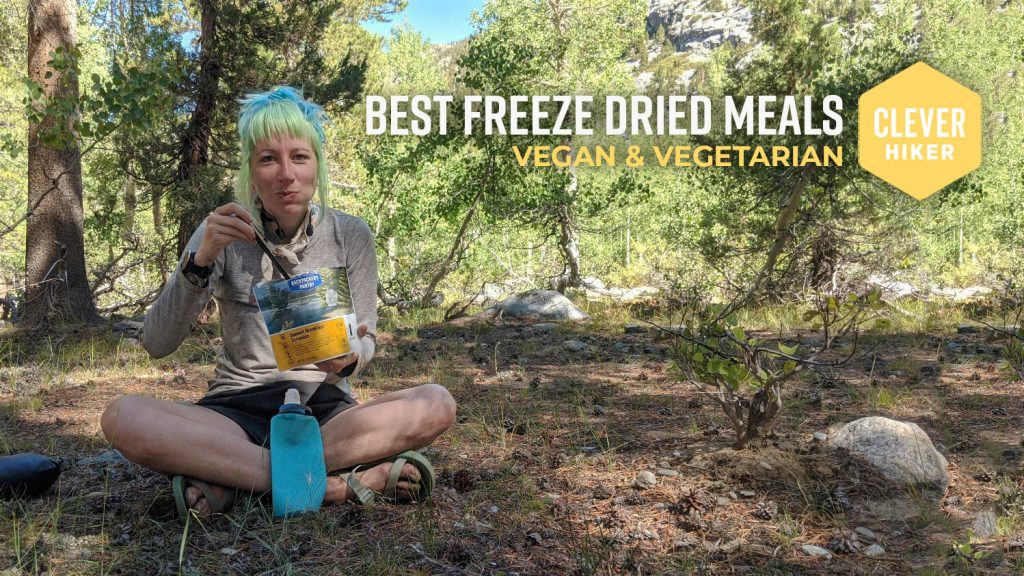
Best Vegan & Vegetarian Backpacking Meals of 2024
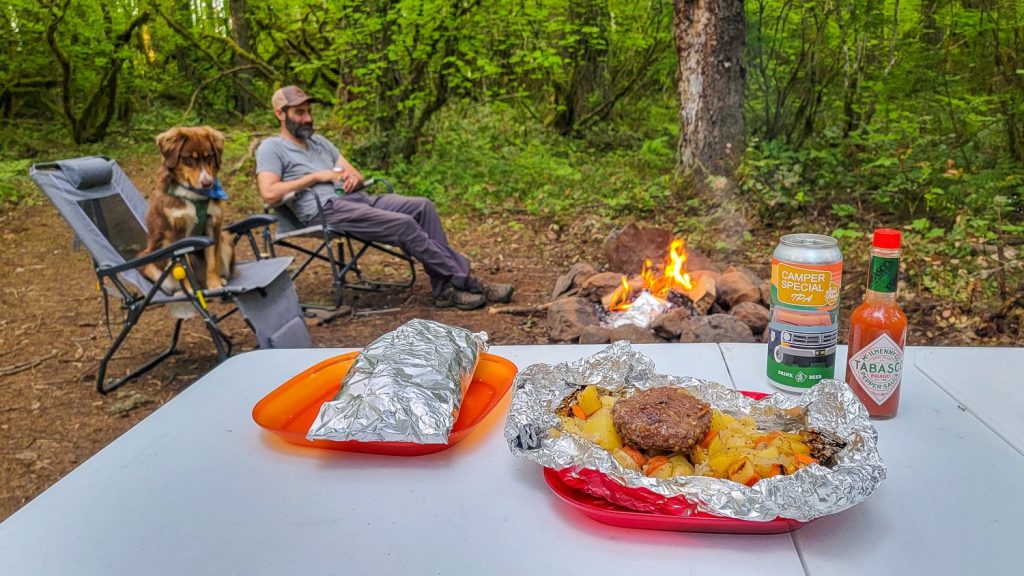
How to Make Tasty Foil Packet Camping Meals – Recipes & Tips
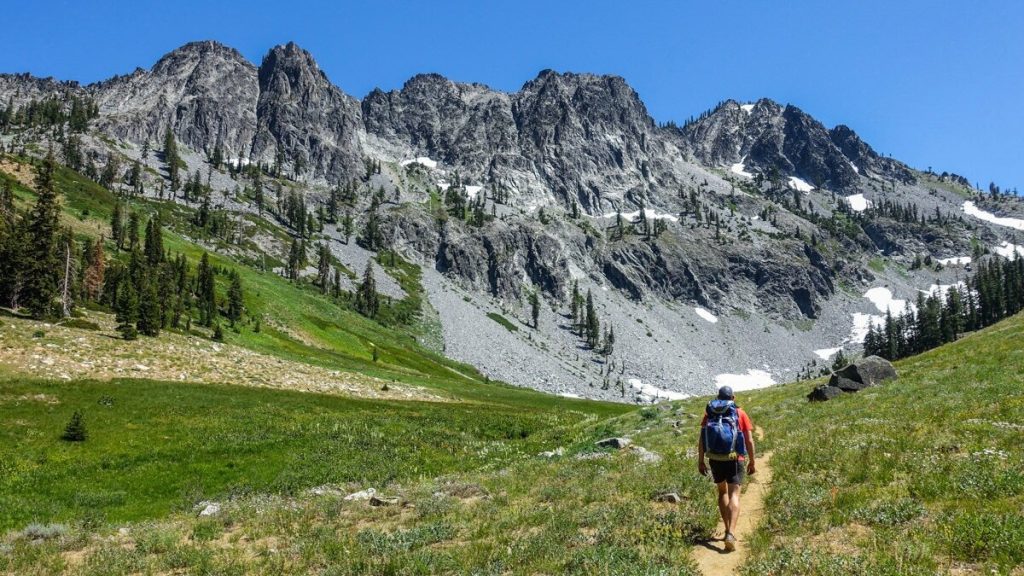
Backpacking Trip Guides
Get the best content from cleverhiker & around the backpacking world.
Social media is great, but our bi-weekly newsletter is a much better way to stay in the know.
Sign up to get our curated emails with the best content from CleverHiker and around the backpacking world. You’ll be turned on to new videos, trip reports, gear reviews, inspiring outdoor stories and much more. So get in the mix!
Get 10% Off When You Start A Subscription - Shop Now
FREE Shipping over $50. Wholesale exclusions apply

What Food Should I Bring on a Hunting Trip?
There’s sitting-in-a-blind-all-day hunting and then there’s trekking-your-way-through-fields-forests-and mountains-in-pursuit-of-game hunting. If you’re a get-off-your-butt type of hunter, we salute you. And we also know that you work up a powerful hunger out there. Why is refueling so important – and what is the best food to take hunting ?
Forget CrossFit, spinning, or HIIT. If you want to burn serious calories, go hunting. A deer or elk hunter carrying a pack over moderate to hilly terrain, for example, will burn between 6,000 to 11,000 calories over the course of a day.
If you don’t replace those calories, you risk fatigue, headache, and loss of concentration. And a rumbling stomach may take away your element of surprise! Further, lack of calories can be a serious problem when temperatures plummet. You need energy reserves, especially if you’re still out whitetail deer hunting in January.
The best foods for hunters are those that are high in nutrients and high in calories. You also need to be strategic: weight and size matters. For example, an apple has nutrients, but it’s relatively heavy and low in calories. It’ll take up precious room in your pack and won’t help you replace calories as efficiently as other choices. Select foods that are easy to carry and easy to open and eat.
6 Hunting Pack Food Ideas to Keep You Going
Our favorite foods to take hunting include:
- Jerky and Meat Snacks – Of course! Jerky is lightweight, easy to carry, and delicious. Our tender Beef Jerky and Steak Bites pouches have an average of 140 calories per package and our FATTY Hickory-Smoked Meat Sticks contain about 100 calories per ounce, making them great protein power-boosters when the midday doldrums kick in. Whether you’re craving the sweet and savory taste of our Original Beef Jerky , could use a kick in the pants from our Jalapeno FATTY smoked meat sticks, or feel like spicing things up with our Peppered Steak Bites, we’ve got you covered for your next hunting trip.
- Nuts – Peanuts, cashews, pistachios, walnuts, walnuts, and sunflower seeds are calorie dense (160 to 185 calories per ounce) and high in Omega 3 fatty acids and protein. They’re great for maintaining energy on the hunt. Mix it up. Create a simple trail mix to take advantage of the benefits of nuts while adding a bit of sweet from raisins, dried cherries, flaked coconut, and dark chocolate chips.
- Peanut Butter – Calorie dense peanut butter is a great picker-upper and hunger-fighter. You can find individual packages that are ideal for carrying in a pack, and you’ll get about 165 calories per ounce. Peanut butter also has a lot of protein and some healthy fats. Slap some on a flour tortilla for some carbohydrates and additional calories.
- Granola Bars – At 100 calories per ounce with plenty of complex carbs and good fats, a granola bar is a great lightweight addition to your pack that helps you maintain energy.
- Snickers – If you’re going to be burning 6000+ calories, you can afford to indulge in a Snickers bar! It does have sugar, but it also has 132 calories per ounce, carbohydrates, and protein. It can deliver a quick boost of energy, so try to time it for the home stretch of your hunt.
- Water – No, it’s not a “food,” but water is essential on a hunt. If your pack has an internal bladder system, fill it up and use it. If not, pack water with you. It does add weight, but you’ll need to stay hydrated.
Stock up before your next hunting trip, and you’ll have all the calories and nutrients you need to keep up with the game! Shop Sweetwood ’s extensive variety of mouth-watering products now.
What’s your favorite food to take hunting?

- Facebook Share on Facebook
- Twitter Share on Twitter
- Pinterest Pin it
Your cart is currently empty.
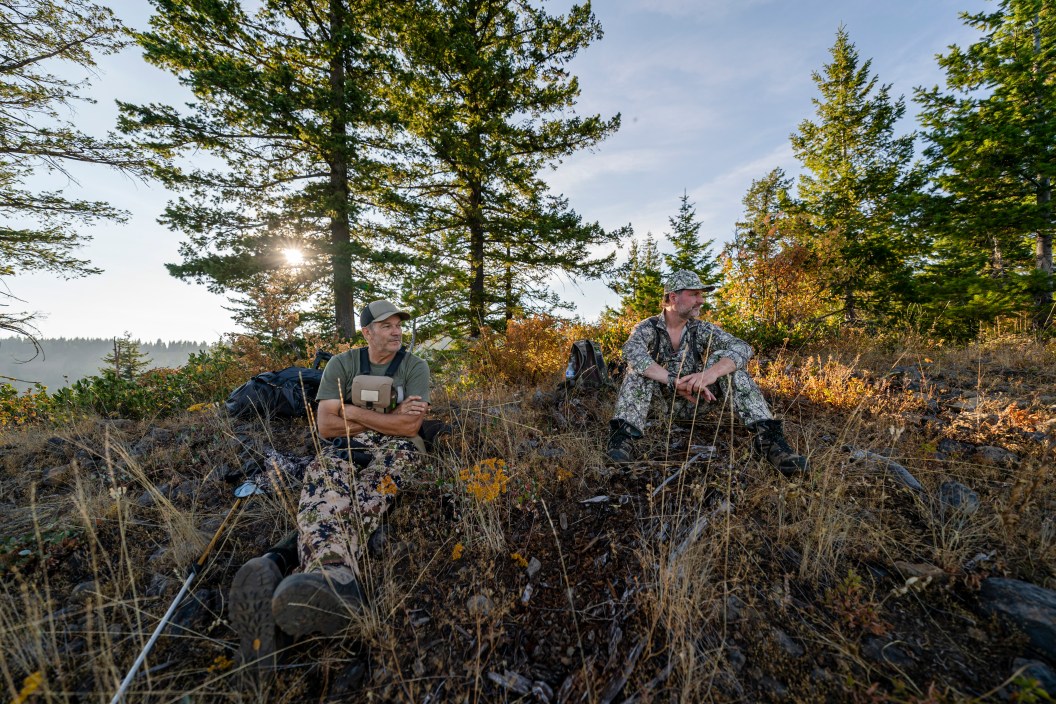
15 Best Snacks for a Long Hunting Trip
Avoid stomach growling scaring off the deer with these packable favorites.
Hunting deer can really rev an appetite, and there is no worse feeling in the treestand than being hangry. Long sits can become brutal on an empty stomach, so be prepared with plenty of snacks on your next hunting trip .
The criteria for a perfect treestand snack is something that is easily packable, minimally messy, and shelf- (or hunting pack-) stable. Snacks to avoid bringing out to the woods are anything overly smelly, loud, or crunchy. And be sure to remove any packaged snacks from noisy wrappers and stick them in a Ziploc baggie for minimal sound and ease of opening in the field.
The following dozen-plus hunting snacks fill the bill. Bon appetit!
1. Energy Balls
Energy balls, sometimes called protein balls, are delicious little protein powerhouses made with nuts, nut butters, seeds, dates, and other natural ingredients. They're portable, healthy, and can easily be made at home with a few simple ingredients. They are also high in protein and healthy fats. For some extra sweetness, add in some chocolate chips or honey.
2. Jerky & Meat Sticks
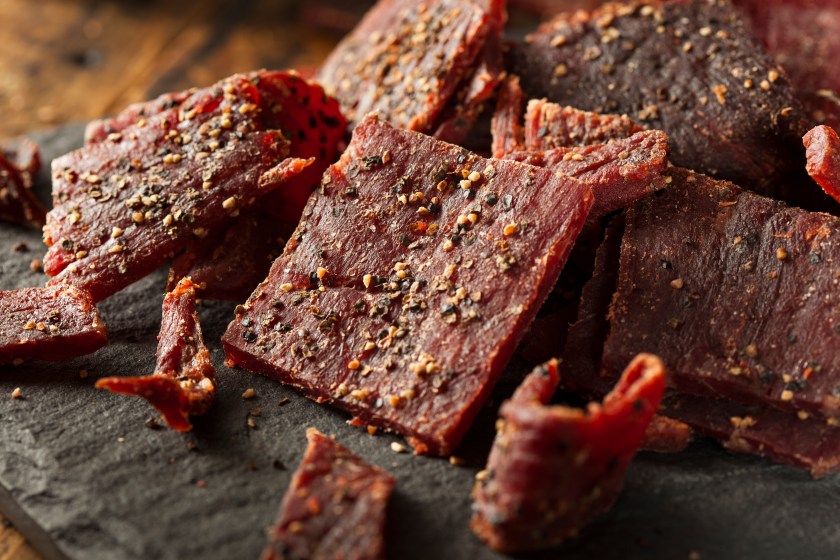
Getty Images, bhofack2
Is there anything better to eat when hunting for meat than chowing on more meat? Load up on beef jerky and beef sticks—or better yet, go with meat snacks of the venison variety—for plenty of protein when your body needs it most. Venison jerky will also keep you chewing longer to warm you up and kill some time as you wait on that monster buck to pass by.
3. Summer Sausage
Along the same lines, the protein found in summer sausage will help stave off hunger and keep hunters' minds sharp while waiting for deer. Summer sausage can be prepackaged or homemade. Or you can go for salami, pepperoni, and chorizo—the choice is yours.
A hard cheese that's not smelly and can go a long time without needing any refrigeration is a good choice to bring along on a hunt. It's creamy and fatty so it keeps hunters satiated for hours.
5. Hard-Boiled Eggs
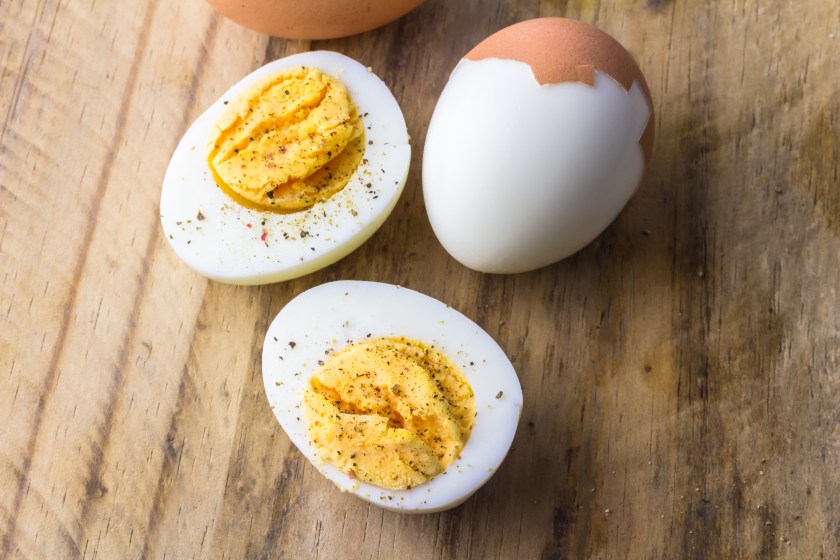
Getty Images, ToscaWhi
This one requires some pre-planning but hard-boiled eggs are perfect because they pack a high nutritional boost and solid protein. A couple of hard-boiled eggs around lunchtime is enough to keep the hunger at bay for quite a long time.
6. Trail Mix
Related content, what's the best venison recipe you can find on the internet, 25 healthy road trip snacks for travelers on a budget, the best way to make venison jerky.
After processed meat, there's no snack more synonymous with hunting than GORP, a.k.a., Good Ole Raisins and Peanuts ). But trail mix isn't just limited to this basic combo: Plenty of artisanal blends feature cashews, white chocolate chips, and a variety of dried fruits to satisfy a sweet tooth and gut-wrenching treestand hunger.
7. Pop-Tarts
One time on a gear-testing hunt, we dubbed a convenient rectangular pocket on a new jacket the "Pop-Tart pocket" because it was perfectly sized for this early morning, deer-hunter favorite. Jokes aside, these tasty rectangles are a good option for mid-hunt snacking when a sweet craving strikes.
8. Snack Bars
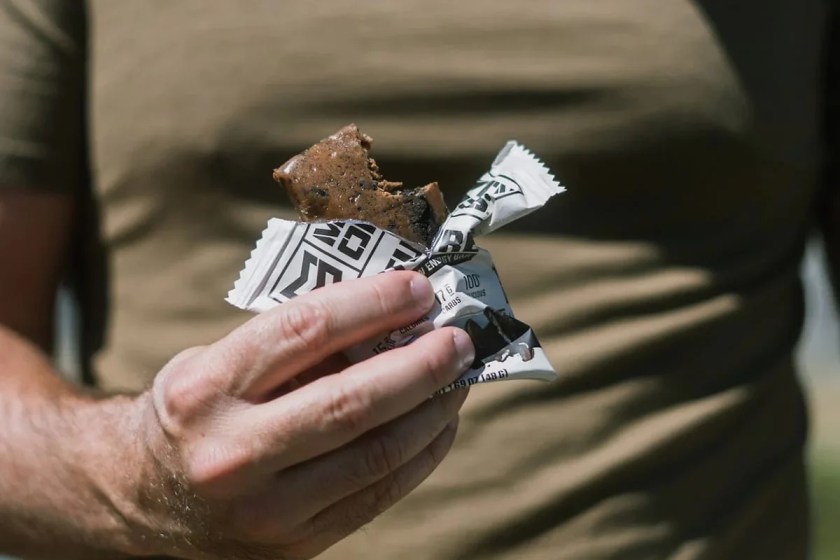
Granola bars, protein bars, energy bars: They're all compact and calorie-dense for any hunting trip and intended to be eaten on the go. If you haven't tried the Chocolate Sea Salt RX Bar , move it to the top of your list and thank me later. Another favorite is any flavor Mtn Ops bars .
Gummy worms, gummy bears, gummy sharks—and don't forget their sour counterparts. I'd like to consider myself a gummy connoisseur and buy just about every variety of gummies in bulk on a regular basis during hunting season.
10. Fruit or Protein Smoothies
Eating healthy foods while hunting will help you stay alert and feel better. Fruit or protein smoothies or shakes are a portable, quiet, and tasty option. Whether you mix up a powder shake or blend up some frozen fruit at home, pack it in a cold thermos and sip all day. Yum.
11. Sunflower Seeds
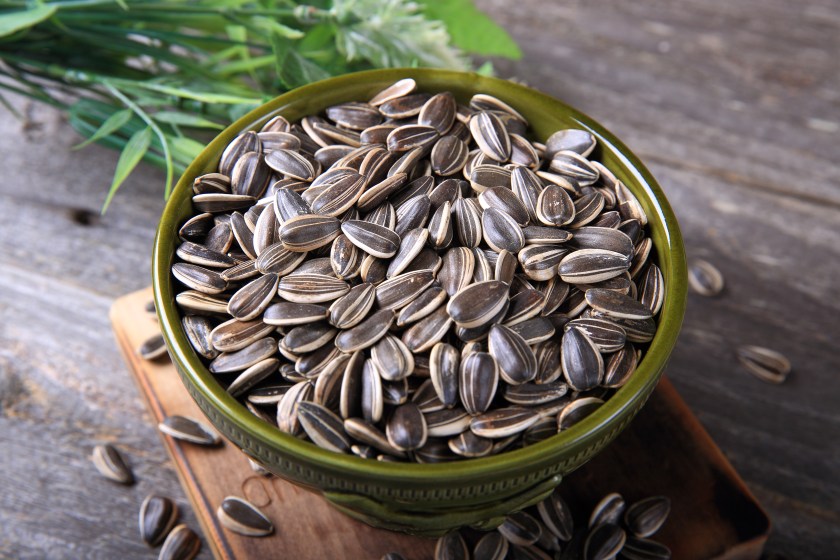
Getty Images, 4nadia
Sunflower seeds are a classic hunter snack. They are cheap, simple, and healthy. Try either the shelled version to enjoy by the handful or the unshelled version for occupying your time when the hunting is slow.
12. Dried Fruit
Mango, pineapple, cranberries, coconut, or whatever dried fruit you prefer, makes a quick burst of energy and fends off a hungry tummy. Another option is some chewy fruit leather.
13. Crackers
As long as its not loud and crunchy, crackers are great because they either be munched alone or can be paired with other snacks, such as summer sausage and cheese. There are so many flavor options available, the possibilities here are nearly endless.
14. Chicken Strips
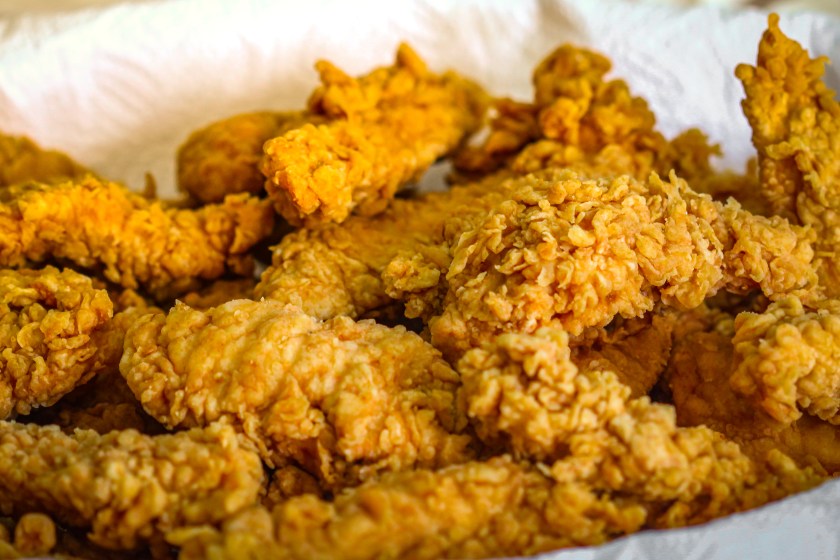
Getty Images, ettalayman
This is another option that requires a bit of pre-work but pays off in the end. Chicken offers a savory and filling option that won't make you crash after eating. Cook them up the night before (in the air fryer, if you'll looking to make 'em a little healthier), and enjoy whenever during the day for a true treestand fill-up.
15. Peanut Butter and Jelly Sandwiches
OK, technically peanut butter is not odor-free, but as an American classic, it stays on the list. Good ole PB&J sandwiches are one of those things most of us still love but rarely find occasion to eat unless we're 20 feet up. Want to kick it up a notch? Swap out the peanut butter for other nut butters like almond or cashew and upgrade your grape Welch's to a fresh berry jam.
READ MORE: Our Favorite Wild Turkey Meat Recipes to Try
You might also like.
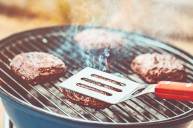
Best Wild Game Meats for Summertime Grilling and Cookouts
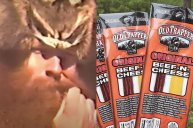
Remember This Old Trapper Commercial From the '80s? Here's What the Jerky Brand is Coming Out With These Days
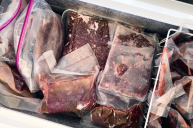
Field to Table Recipes
How long is deer meat good in the freezer.
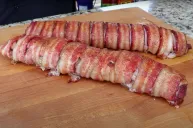
Venison Backstrap: An Ode to Our Favorite Cut
Last updated on September 1st, 2022 at 04:34 pm
What to Pack for Hunting Trip: The Ultimate
List of gear you need to get started.
Planning for a hunting trip can be a bit stressful. You want to make sure you have all the right gear with you, but in the end, it is still just as unpredictable as nature itself.
A good hunting trip is only fun if everything goes well. If your equipment fails, or if you forget something important on your list, there’s no way of getting more at the last minute. Not like going to any other type of store anyway…
This guide has been designed to answer all those questions that come up during preparation for your hunting expedition. We’ll tell you what to pack for hunting trip, what things are handy to have, what items are necessary to pack in different seasons, and a few useful tips for a successful hunt.
Table of Contents
What Type of Hunting Trip You Are Planning?
Every hunter should have a backpack with the right gear for their hunting trip. The number of gear varies according to the kind of hunting trip you are planning. If your trip is an overnight trip, then you will need to pack more than if it is just a day trip.
Similarly, it’s a little different from packing for a spring or summer hunting trip. You have to consider the weather, type of terrain, and the time of year.
Packing the right gear can make all the difference in a successful hunt or a miserable one. You might not be able to carry everything you want, but you can at least be prepared with the essentials.
What to Pack for Hunting Trip in Fall?
In the fall, the weather is perfect for hunting. The leaves have fallen off the trees and game is readily available. The only problem is that you are not sure what to pack for your trip. Here are a few items that you can’t forget when packing for your fall hunting trip.
The weather will be getting cooler by the day so you need to make sure that you have a good tent with you to stay warm at night.
Be sure to have a suitable sleeping bag for cold nights, bedroll, or any other sleeping equipment that you need.
The best clothing items for fall hunting are waterproof boots, a warm jacket, and waterproof pants. A good rain/cold gear will keep you dry and warm.
What to Pack for Hunting Trip in Winter?
Hunting in the winter is a completely different affair than hunting in the summer. There are many things that you have to remember to bring with you on your trip, and the following list will make the process easier.
The first thing that you’ll need is a good pair of boots. Cold weather and snow can be very hard on your feet, so it would be best to have something that provides comfort and support. A good pair of boots will also provide protection from the elements. It’s a great idea to get a pair of waterproof boots, but they aren’t absolutely necessary.
You will need warm clothing, like sweaters, jackets, thermal underwear, socks, and gloves. You will also need a hat and earmuffs. A scarf can also be used to cover your mouth and nose if you are in a windy area.
Rain gear is important because it will keep you dry when it rains. If you have an umbrella, bring that too.
What to Pack for Hunting Trip in Summer?
When the summer finally arrives, it is time to pack up your things and go on a hunting trip. Many people like to head out into their fields to look for boars and rabbits, but if you are going to be more ambitious this year, you’ll need to learn what items you should take with you.
The first thing that you will need is the proper attire. You won’t want to wear anything that restricts your movements, so choose something light and airy such as a cotton T-shirt or a tank top. You’ll also want to wear shorts or sweatpants, along with some sturdy shoes
The temperature can rise to 35 degrees Celsius, so you need to think about what clothes and equipment you need to take with you.
What to Pack for Hunting Trip: The Ultimate Gear List
With the right gear, you will be prepared for anything. You’ll also be able to spend more time enjoying the outdoors instead of worrying about what you forgot to bring or whether your gear is up to the challenge. That’s why we’ve created an ultimate hunting gear list with everything you need to know.
This section will take you through the most important things that you need to pack for hunting trip. We will also give a brief overview of these useful accessories so that you can make sure that your trip is as enjoyable as possible.
Main Items :
First on the list is a tent, which will provide protection from rain and other weather conditions. The tent should be easy to erect and dismantle, so you don’t waste too much time setting it up. A good idea would be to choose a lightweight tent.
Sleeping Bag and Sleeping Pad
You will need a sleeping bag that can keep you warm during cold nights and protect you from bites. You should have a sleeping pad as well because it will help you stay warm and comfortable.
A lack of sufficient water can turn an enjoyable trip into a mess. A good rule of thumb for how much water to bring on a hunting trip is 2 liters per person per day. For groups of three or more, multiply this number by the number of people in the group. For example, if you are going on a three-day trip with four people, you will need to bring 12 liters of water per day.
“It is better to have more than you need than not enough.” This is an old saying which tells us that it is better to have too much than to run out. While preparing for a hunting trip, you should take this saying into account.
Foods that can be taken on hunting trips should be easy to carry, lightweight, and high in protein and calories. The most popular diet for hunters is dry fruits and nuts. These are easy to carry along with and do not need any cooking.
General Items :
Cooking Equipment
You will also want to bring along cooking equipment if you plan on camping out or being in one spot for a while. While there are many different ways to cook in the outdoors, most will boil down to one of four methods: boiling, grilling/barbecuing, smoking, or frying.
Boiling is the easiest way to prepare game meat and it requires the least amount of equipment. A pot with a lid and a stove with a heat source is all that is needed. A small, one-burner stove will work for boiling water and a pot large enough to hold the meat being cooked.
Another option is a portable grill, which is good to have because it will let you cook food anywhere, even if there is no campfire.
First Aid Kit
A first aid kit is one of the most important items you can bring on any hunting trip. But what should be in a hunting first aid kit?
Things you should take while going on a hunting trip:
- Antiseptic wipes or alcohol wipes
- Bandages: Assorted sizes
- Adhesive tape
- Gauze pads and gauze rolls
- Thermometer
- Over-the-counter pain reliever
- Antibiotic ointment
- Ibuprofen or acetaminophen
- Sunscreen and lip balm with SPF 15 or higher
If you’re going to be hunting in a region that’s prone to rain, you should always carry rain gear with you. Even if the weather forecast looks good, it could change at any moment. Bad weather can ruin a trip and make it hard to get back home.
Fire Starter/Lighter
The fire starter or lighter is one of the most crucial tools for a hunting trip. Unlike matches, a fire starter is convenient and safe to use. It works faster, longer, and better than a match or lighter. Without a fire starter, you will have to hold your match in the wind and wait patiently until it catches fire.
If you want to take a lighter, you are going to need the one that can be used in all weather conditions.
When planning a hunting trip, you should never go without a flashlight. You can use a small LED flashlight that you can carry in your pocket. It should be bright enough to light up the area around you while also being compact enough to fit in a small bag.
Knives are an essential item for hunting trips. They help you to do the task of cutting wood and preparing food.
The first thing to keep in mind is that the knife must be sharp. You cannot use a blunt knife in hunting because it will take time and will be difficult to cut anything. So, if you have a dull knife, make sure to sharpen it before going hunting.
Gloves are an important part of hunting trips. They protect your hands from harsh weather conditions, as well as shield you from the sharp weapons you might be using to hunt.
If you are going hunting in a place where the temperature drops below freezing, it is advisable that you bring a pair of leather gloves for insulation purposes. It is also important to make sure that your gloves fit tightly enough so as to prevent any cold air from slipping through.
Camo masks are essential for hunters who want to remain undetected by animals. They are usually made from soft fabric with different patterns that blend into the natural environment.
It can be difficult to keep the environment clean when you are out hunting, but there are ways to minimize the effect on the environment. You should bring a trash bag with you and make sure you bring back any garbage that you see around during your trip. In addition, if you find someone else’s garbage, pick it up and put it in your own bag.
A good saw is essential to help with cutting down trees when you need to make a stand or start a fire. Consider taking the Gerber Saw that has been designed specifically for hunting trips and outdoor activitie s such as these.
Inflatable Seat Cushion
This item is a good option for hunters, fishers, or backpackers. It can be easily stored in your backpack and it is super light.
An inflatable seat cushion can help reduce back pain and aches after sitting for a long period of time. It also provides extra comfort while sitting on the ground or hard surfaces.
Technical Items :
Satellite Messaging Device
A satellite messaging device is a great tool to have on a hunting trip. It will allow you to send a message or SOS in case you get lost or injured. If you are an avid hunter, it’s a good idea to carry some sort of satellite messaging device with you when you go on your next trip.
Maps (Paper/Printed)
Maps are a great option for a hunting trip for so many reasons. For example, maps will allow you to take full control of your trip and plan it in advance, find the best places to hunt, scout them before and make the most of your time.
Wind Detector
A device to measure wind velocity is a must-have for the serious hunter. Wind direction and speed are essential factors that influence game movement, hunting range, and success.
A compass is a must-have when you are in the mountains, woods, or somewhere you can get lost. The best compass for hunters is one that is built solidly, has large numbers, and comes with important tools like a magnifying glass and an inclinometer.
Hunting Kit :
Range Finder
The most important piece of equipment for hunters is a range finder. It is a must-have and it helps to estimate the yardage for accurate shots.
Binoculars are something you need to carry if you go hunting. Binoculars allow you to see farther than you can with your naked eye, allowing you to spot prey even when it is a long-distance away.
Most hunters will tell you that the most important thing to bring along on a hunting trip is your weapon. After that, the next most important thing is bringing a game call.
Game bags are a very important part of hunting trips. The game bag helps you to keep the hunted animal secure and safe from any external harm. Besides, game bags can also be used to collect the trash that hunters leave behind in the wild, so as to protect and maintain the ecological environment.
Rubber Gloves
It’s vital to keep your hands clean and protected while butchering the game. Rubber gloves will not only keep you from getting blood on your skin, but they also can help protect your hands from cuts and splinters.
If you go on a lot of hunting trips, chances are you have some zip ties lying around the house or garage. You can use them to tie up your game tags when you are transporting your animals back home.
Hunting License
One of the most important things to bring on a hunting trip is your hunting license. That’s obvious, right? The problem is that many hunters never think to actually bring their licenses with them when they head off for a day of hunting.
Personal Items :
Many people go hunting. What they don’t realize is that you can actually get sunburned while you are out in the field. Because we usually think of sunscreen as something only for sweaty days on the beach, it’s easy to forget to take care of yourself when you are out in nature. The harsh rays of the sun are just as dangerous as they are on a hiking trail or at a football game, so remember to protect your skin with sunscreen.
Sometimes it’s the little things that make the biggest difference. It’s a good thing to bring chapstick when you go on a hunting trip because after all there will be those occasional chapped lips. If you don’t have any chapstick, then you can use some other sort of lip balm or cream.
Toilet Paper
Make sure you bring toilet paper with you on your next hunting trip. With a little planning and foresight, you can make sure that nature calls but doesn’t get the best of you.
Heat packs are the perfect thing to bring along with you when you go hunting. They’re easy to use and effective at keeping your hands warm.
Ultraviolet light can do a lot of damage to your eyes and your vision. If you spend any time hunting, fishing, or doing anything else outdoors, you need a pair of high-quality sunglasses.
For your next hunting trip, bring a pack of baby wipes. They come in handy for cleaning up your face and hands after a hunt. They are especially useful when you’re trying to clean your gun. Baby wipes will make a messy job much easier, and they’re small enough to store in the pocket of your hunting vest.
Power banks are a great gift to bring on your hunting trip. Hunting and power banks don’t seem to go together, but they really do. There’s nothing worse than being in the middle of a hunt and having your phone die. With a portable charger, you never have to worry about that happening again!
Also Read: What Size Pack for Appalachian Trail
Important Tips for Hunting Trip
Planning a hunting trip can be quite an exciting and fun experience and the right preparations can make all the difference in ensuring that the hunt is a success. Here are some important things that must be taken into account when planning what to pack for hunting trip:
- The proper equipment such as firearms, ammunition, and hunting tools should be purchased beforehand.
- Physical fitness is also important for a successful hunt, along with mental preparedness. The good physical condition will ensure that the hunter can handle strenuous physical activity, while mental preparedness will help him remain focused on the task at hand.
- Hunting in groups is highly recommended to new hunters because it will provide safety and security.
- A hunter should always be aware of the rules and regulations that apply to his area of hunting. It is also important to know the laws and regulations of the state where you are hunting.
- Know the terrain and weather conditions.
- Be aware of the obstacles you may encounter.
- Plan your route and consider the most likely emergencies.
- Know how to use a map and compass.
- After you pack up your stuff, be sure to clean up your campsite. Make sure you’ve left no trace of your stay behind.
- Dispose of trash properly, or take it with you when you leave.
Whether you are going on a hunting trip for the weekend or a week-long expedition, there is always some preparation involved. To make sure your trip goes smoothly, we’ve put together a list of things that you should pack for your next hunting adventure.
These items may seem like common sense, but they’re often forgotten when packing for a hunting trip. We hope that this post has been helpful and allowed you to determine what to pack for hunting trip . If you enjoyed this article, please share it with your friends on social media.
Frequently Asked Questions
Can you wear jeans hunting.
There are many opinions on this topic. Some hunters wear them, some don’t. But why not? Is it because they’re too bulky? Or too heavy? Most of the time it’s because they’re too hot and uncomfortable to wear.
Is Camo necessary for hunting?
For a long time, camo was mostly associated with hunters in the woods. It was used by sportsmen to blend in with their surroundings. But as technology has advanced and the rules of hunting have changed, so has the clothing worn by hunters. Today, camo is no longer a necessity for hunting. Modern hunting uses high-tech binoculars and scopes to locate prey from afar or an app on a phone to track animals’ locations.
How do you get rid of human scent for hunting?
The solution is simple: use a good scent masking product that can help block your scent from the wind. There are many different products on the market today and it makes sense to try them out to see which one is best for you.
What should I wear on a hunting trip?
Whether you’re new to hunting or you’re an experienced hunter, it’s important to dress appropriately for the trip. Hunting trips can last all day, and you’ll need to be prepared for both hot and cold weather. It’s also important to wear clothes that will help you blend in with your surroundings. What you wear on a hunting trip will also depend on the type of hunting you’re doing. For example, if you’re deer hunting, you’ll want to wear clothes that are dark in color. If you’re bird hunting, you’ll want to wear bright colors. No matter what type of hunting you’re doing, be sure to dress in layers. This will help you stay comfortable no matter what the weather is like.
What size pack do I need for hunting?
One of the most important things to consider when going on a hunting trip is the size of the pack you will need. The size of the pack will depend on the type of hunting you are doing, the length of the trip, and the amount of gear you need to bring. Some packs are designed for specific types of hunting, such as waterfowl hunting or deer hunting. Other packs are more versatile and can be used for multiple types of hunting trips. Additionally, the size of the pack will also be determined by how many days you will be gone on your trip. A one-day trip will require a much smaller pack than a week-long trip.
What do I need for a 3 day hunt?
When heading out on a 3 day hunting trip, there are certain supplies you will need to bring with you in order to survive and thrive in the wilderness. Here is a list of essential items to pack for your next hunting excursion: · A tent · A Sleeping bag · Hunting gear · Ammunition · A knife · A first aid kit · A map With these items, you will be prepared for anything the wilderness throws your way.
How heavy should a hunting pack be?
One of the most important considerations for any hunter is the weight of their hunting pack. A hunting pack should be lightweight enough to allow the hunter to move freely and quickly, but it should also be heavy enough to provide enough storage for all the gear and supplies the hunter needs. How heavy should a hunting pack be? That depends on a variety of factors, including the type of hunting being done, the length of the hunt, and the amount of gear and supplies the hunter needs to bring. In general, a hunting pack should be between 20 and 40 pounds, but the exact weight will vary depending on the individual hunter’s needs.
Leave a Reply Cancel Reply
Save my name, email, and website in this browser for the next time I comment.
Where To Buy
- View our facebook
- View our twitter
- View our youtube
- View our pinterest
- View our instagram
New Arrivals
Home & Living
- Timber 2 Table Articles
15 Best Hunting Camp Cooking Hacks
Posted 2020-12-06T13:00:00Z
Realtree Nation
- All Articles
Even if the hunting is great, your camp won't be successful if the food sucks. Keep everyone happy and well fed with these camp cooking hacks
It's hard to have a good time if you're hungry — even when the hunting is great. Ask your friends about their favorite times at hunting camp and they will often answer that it's when everyone is sitting around the table or campfire sharing meals and tall tales with other hunters in camp.
You don't need a full-time camp cook (though that never hurts) to have great meals. Use these camp cooking hacks to make meal prep in a camp setting quick, easy, and delicious.
1. Celebrate the Kill
One of our longstanding camp traditions is to cook and share some of the first kill. Grilled waterfowl poppers are always a favorite in duck camp. For deer camp, we slice the heart and inside loins , season simply with salt and pepper, and sear quickly in an iron skillet over either the camp stove or an open fire. Sharing freshly killed game meat with your fellow hunters just feels right at camp.

2. Prep Ahead
The prep time for most of the recipes on Timber2Table is way longer than the actual cook time. Plan your recipes ahead of time and do the measuring and chopping before you leave home. Label the containers by dish and meal so you can find them quickly in the cooler.
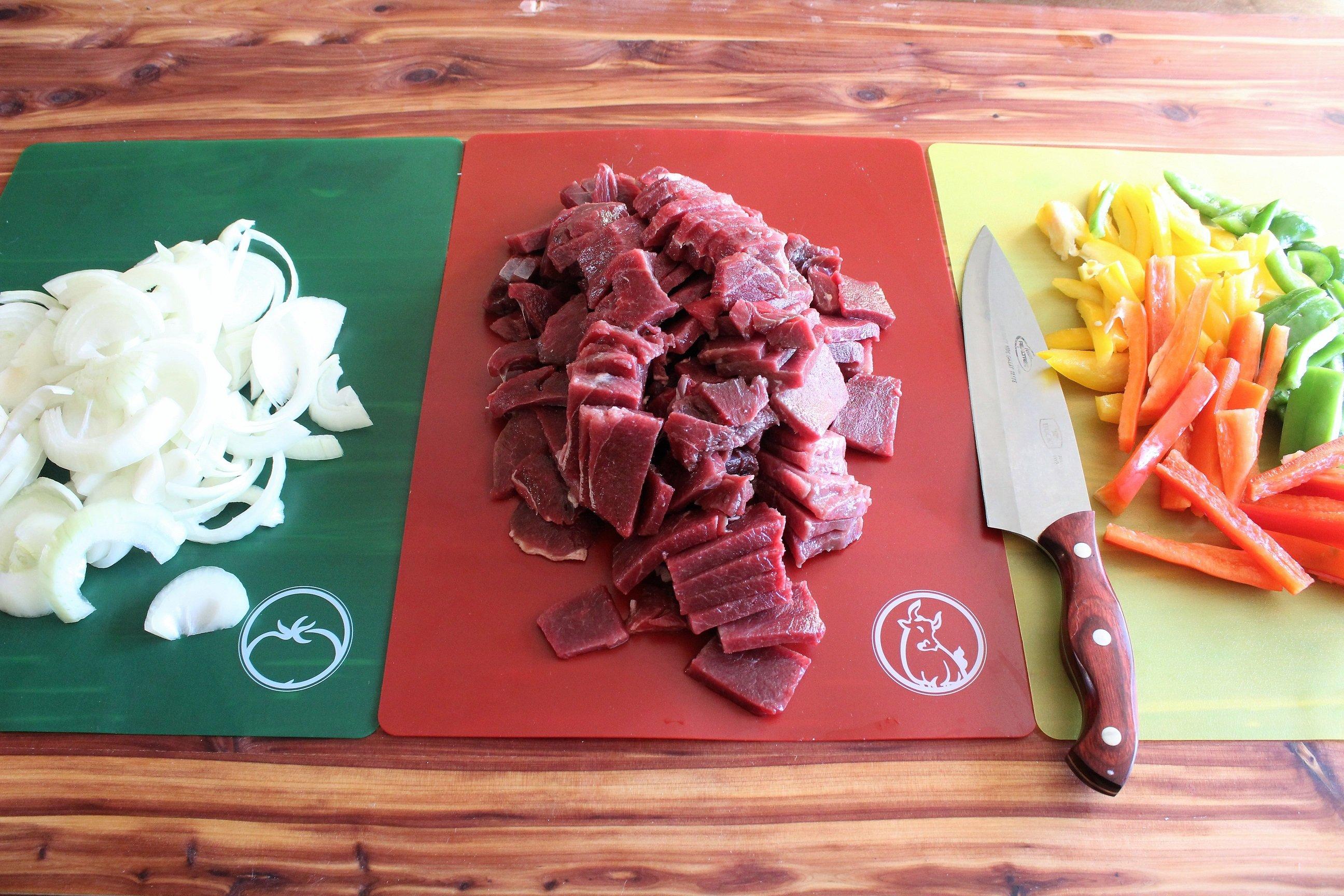
3. Use a Vacuum Sealer
Marinating a backstrap or some steaks to grill the first night in camp? Vacuum-seal them with the marinade to keep storage space in the cooler to a minimum and prevent the marinade from leaking out on everything else. Same goes for the prepped vegetables and ingredients from step two. You can use a permanent marker to write directly on the package for easy labeling, and the vacuum-sealed packages take up way less space than plastic containers. Chopped vegetables stay fresher when vacuum sealed as well, keeping them in prime condition for your recipes.
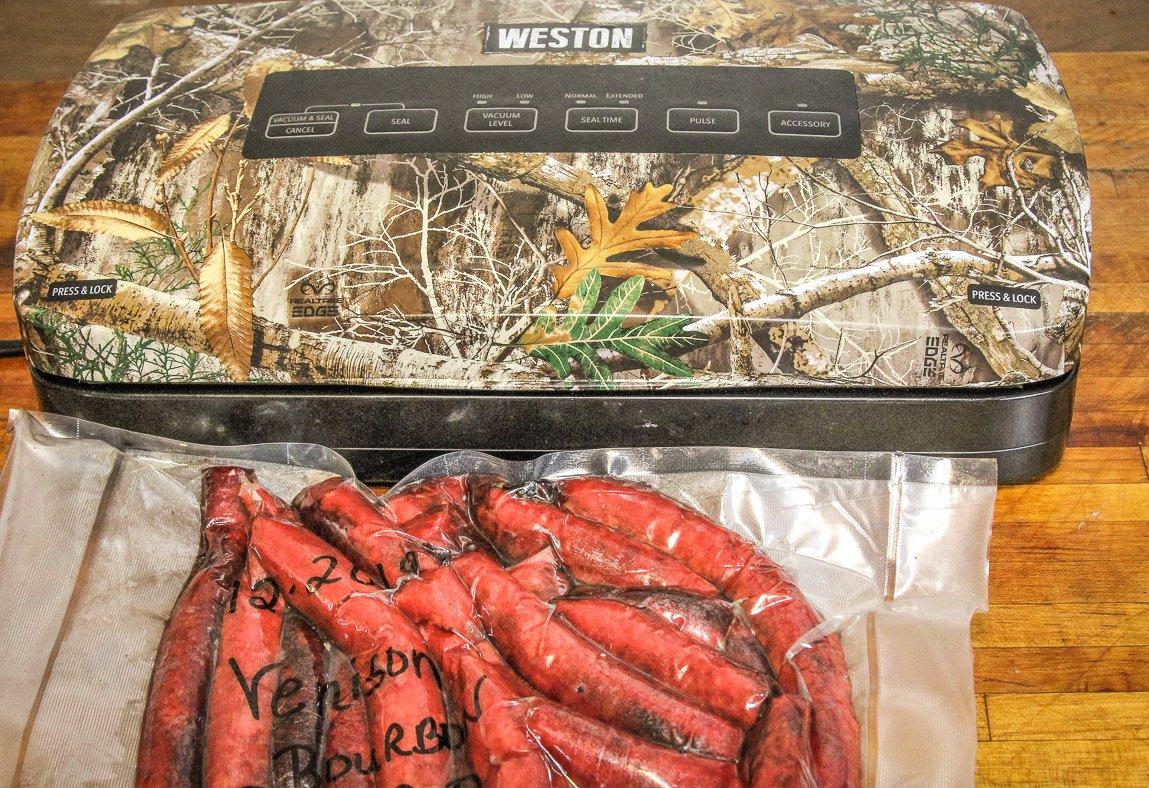
4. Use Adjustable-Height Grills for Open Fire Cooking
Temperature control can be an issue when cooking over an open fire. Using a grill that easily adjusts up and down and swings in and out over the fire lets you set the food height and placement just right. I use the Breeo Outpost because I can raise or lower it quickly, and it's rock solid once I get it adjusted.
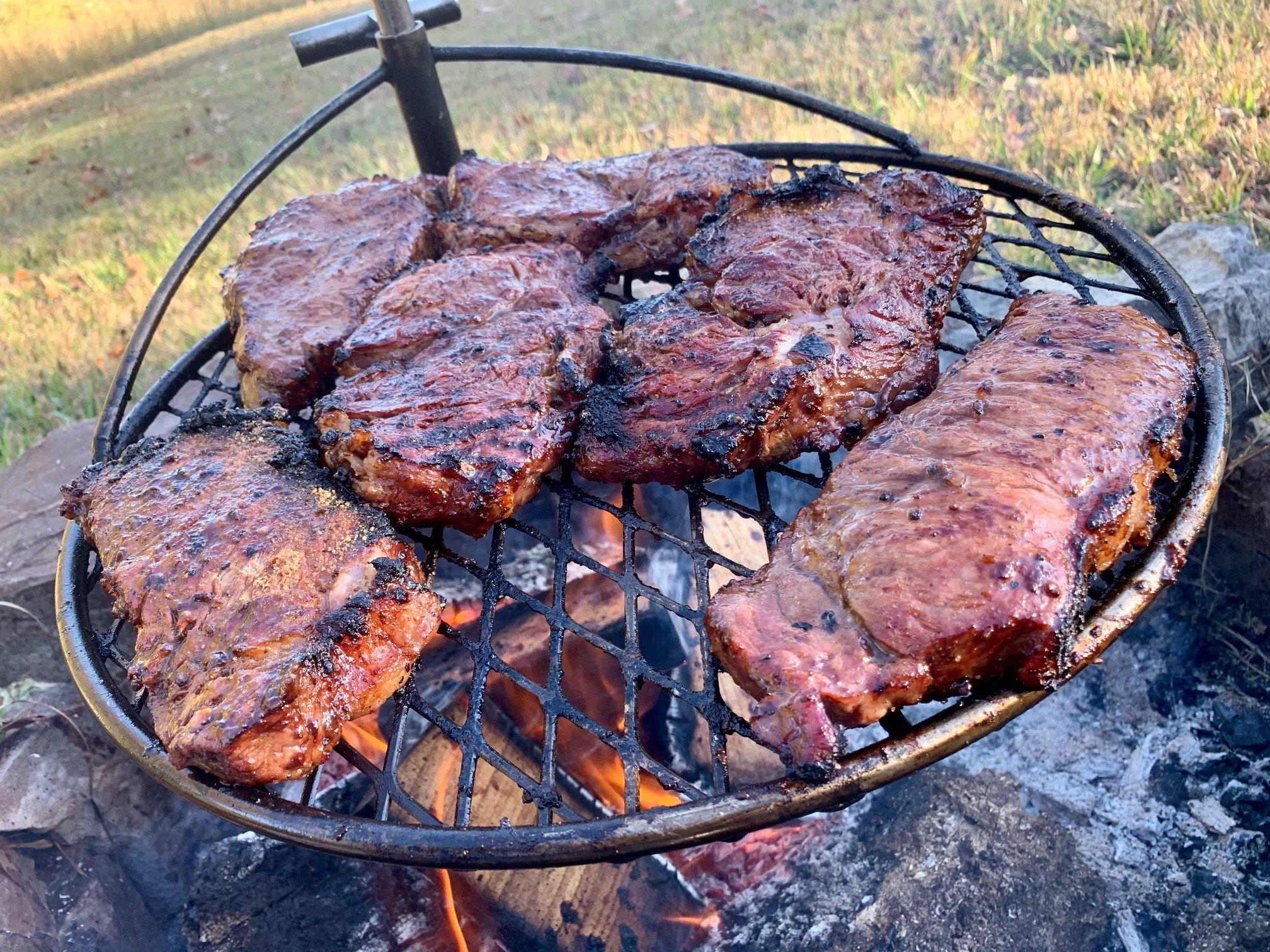
5. Bring the Foil
There's nothing handier for cooking on an open fire than a roll of heavy-duty aluminum foil. Use it to line grill grates or pans, cover pots and bowls to keep cooked food hot and bugs at bay, or even cook directly in the campfire coals in foil packets — like these recipes for Frog Leg Frogmore Stew and Venison Campfire Philly Cheesesteak.
6. Pack a Kit for the Camp Kitchen
If you spend a lot of weekends at hunting camp like we do, packing and unpacking a kitchen kit before and after each trip can get tedious. Use a heavy-duty storage tote to pack away a set of basic kitchen tools like spoons, spatulas, a can opener, basic seasonings, a roll of aluminum foil, plates, cups, bowls, zip-style storage bags, and anything else you use on a regular basis. Just replace the used items as they get low. When it comes time to pack for camp, load the kit and you are ready to cook.
7. Use Dutch Ovens
There's a reason most outfitters and professional camp cooks love their Dutch ovens. You can feed an entire camp with a one-dish meal from a large Dutch oven, and do it without a lot of fuss. Prep the evening meal while everyone is in for lunch, nestle it over the coals and add a few to the top, then go hunting and come back to a waiting meal. (Safety note: Obviously, never leave hot coals if conditions are windy or dry because of fire hazard.)

8. Use Slow Cookers
If conditions don't allow you to leave a Dutch oven slowly cooking your meal while everyone hunts, and your camp has electricity or a generator, use a slow cooker . Start a venison roast or a pot of squirrel and dumplings early in the morning and it will slowly simmer all day. Once everyone returns to camp, there will be a hot meal waiting.
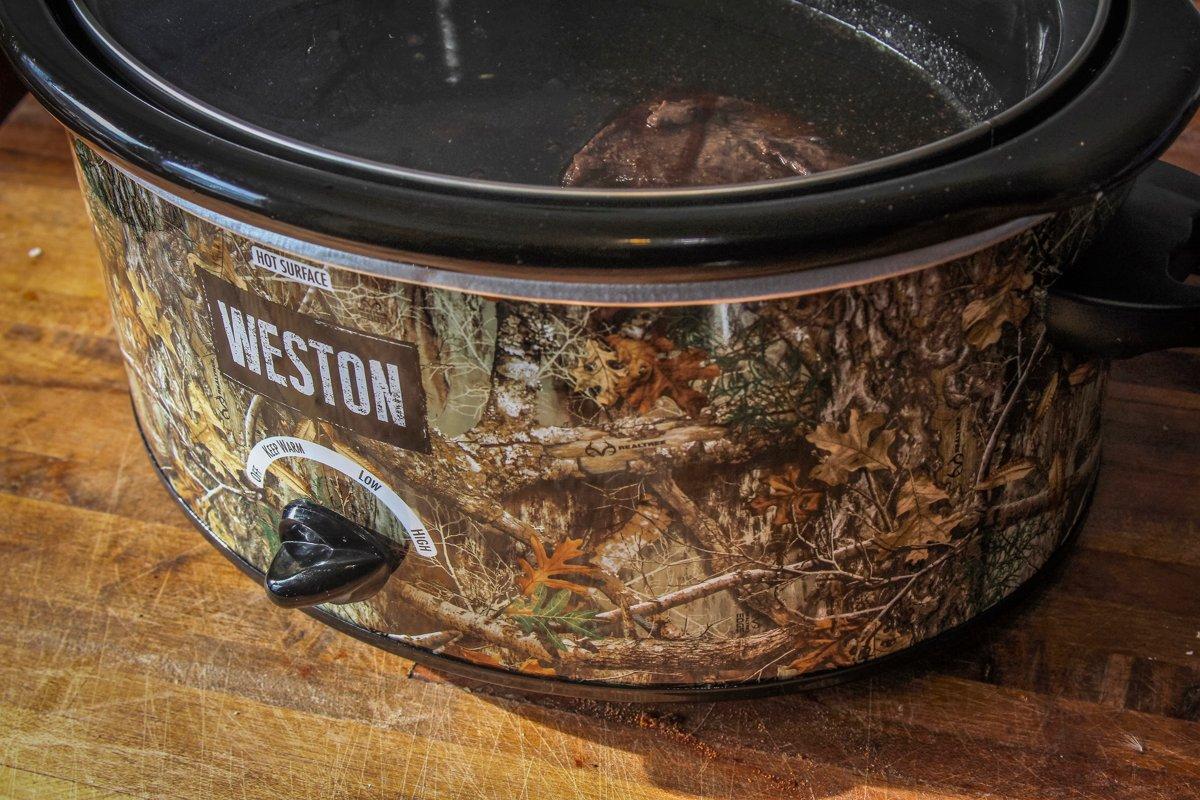
One issue with evening hunting camp meals is that not everyone returns from the woods at the same time. While some hunters might roll in right at dark, others may shoot a deer late in the evening and might not return until late. Slow cookers are the perfect answer. The food stays hot and ready and everyone can eat when they are ready.
9. Don't Skip Dessert
The best part of any family meal is dessert. Just ask any kid (or kid at heart) who happens to be nearby. Don't forget to include something sweet to cap off your camp meals. It can be something as simple as the favorite s'mores over the campfire, or sliced apples with brown sugar and butter wrapped in foil and tossed on the grill until everything melts into a caramel sauce. Or it can be something a bit more complex like this Dutch Oven Bourbon Bread Pudding . Either way, a sweet ending perks up any meal.
10. Pack a Grill
There isn't a handier way to fix a camp meal than on a grill. Charcoal and gas are both workable choices for camp cooking, but if you have access to electric power, a generator, or even an inverter, you can run a Traeger Pellet Grill at camp.
With a Traeger, you can do quick cooks like steaks or burgers, or put on a roast, pork shoulder, or even a brisket to slow cook all day while hunters are in the stand or blind. Come back to camp to slow-smoked meaty goodness.
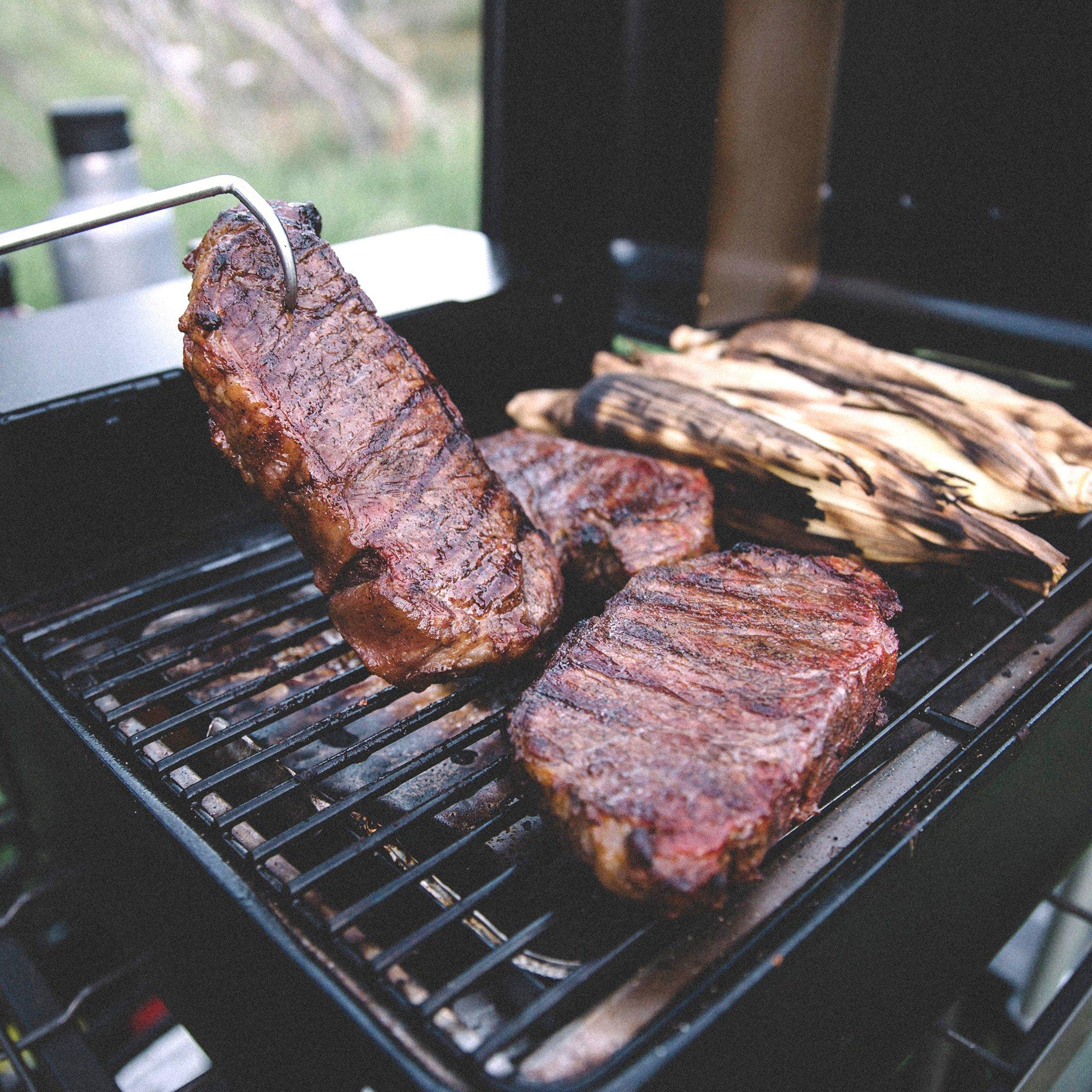
11. Cook Safely Over Fire
Cooking over an open fire can produce some of the best-tasting food you'll ever eat. It can also leave you with a nasty burn if you aren't careful. A pair of thick leather welder's gloves allow you to safely move around hot cast-iron pans and adjust grill heights without burning.
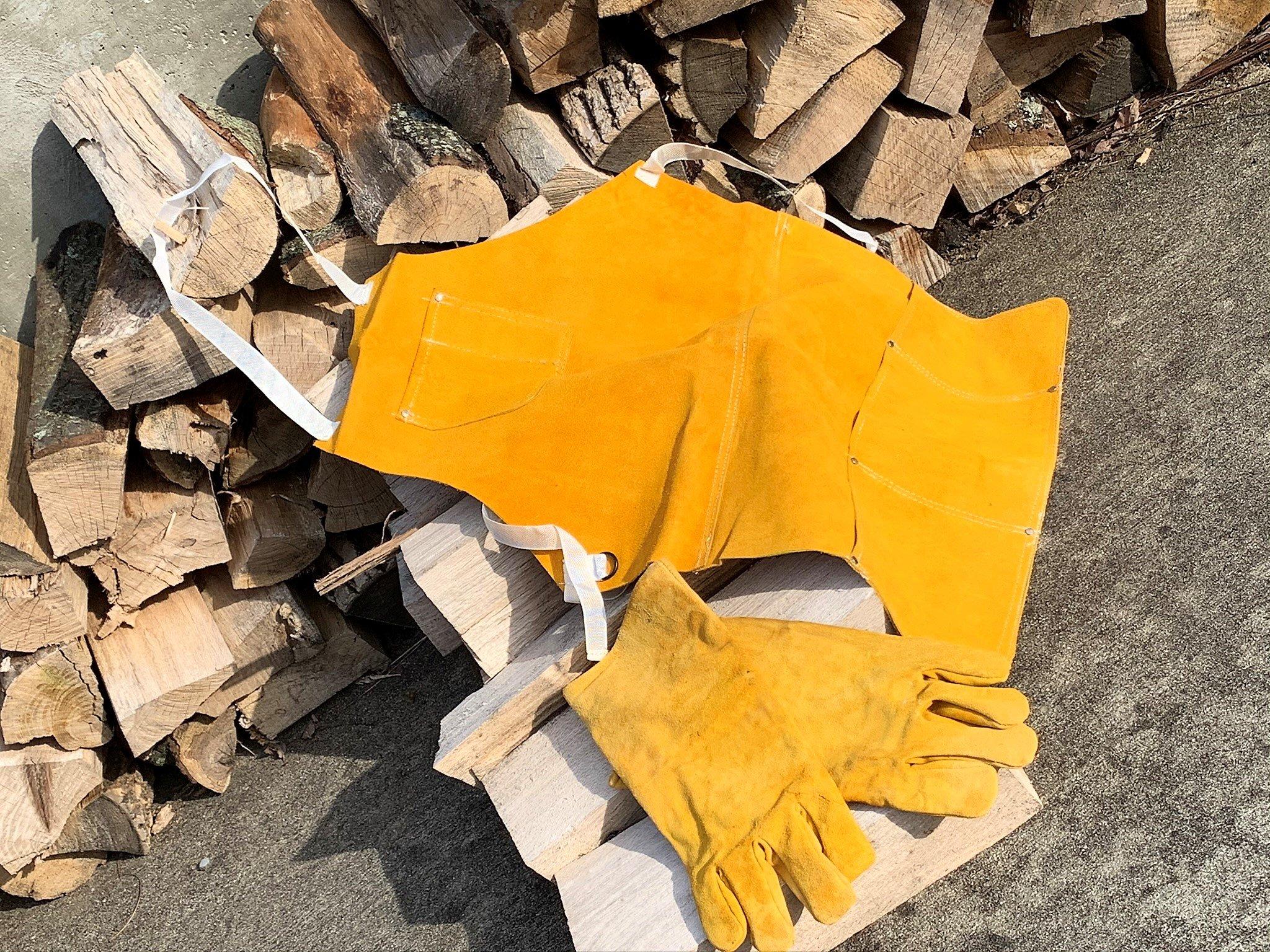
Besides the gloves, a Dutch oven lid lifter and a pair of vise-grip pliers help you lift and move around hot lids without burning your fingers or spilling hot coals into the food below while checking for doneness. It's always a good idea to wear closed-toed shoes when cooking on an open fire.
12. Do Breakfast Late
While you might not have time to make a big breakfast before everyone heads out in the morning, you can always serve a light breakfast before the hunt and then cook up a big late-morning feast once everyone returns to camp.

Make breakfast easy with a few simple tips. If you plan on serving scrambled eggs, crack them into a jar or sealable plastic container before ever leaving the house. Stored this way, eggs can go straight into the cooler without fear of something heavy landing on top of them and cracking the entire carton. Once you are ready to cook, simply give the jar a hard shake to scramble the contents and pour straight into a hot skillet.
If you want to serve pancakes, mix the batter at home and seal in a vacuum-sealer bag. Once you have your greased skillet hot and ready, snip the corner from the bag and squeeze the batter out one pancake at a time. Not only is it quick and easy, but you can toss the bag in the trash once you are finished with no dishes to wash.
13. Don't Skimp on Coffee
Good coffee is a must-have to get me going in the morning. Try these tips for a great cup , even at camp. Since a good deer camp often means early mornings and late nights tracking, dragging, and processing deer, I generally run on caffeine. That's where Death Wish Coffee comes in. With twice the caffeine of normal coffee and a super smooth flavor, it keeps me going.

14. Keep Food and Drink Coolers Separate
Today's rotomolded coolers like the Realtree Big Frig are great at holding ice for days, but that ice will last a lot longer if you don't open the cooler any more than necessary. That's why I like to keep drinks and other items that are needed on a regular basis in a separate cooler than perishable food.
Even as thirsty campers reach in and out of the drink cooler all day long, the ice in the food cooler will stay put for a much longer period.
15. Make Cleanup Easy
The only downside to cooking is cleaning up once you're done. While washing up a few plates and bowls for a small camp isn't a big deal, cleaning up after a big crew can be time consuming. Use disposable paper plates and bowls and plastic cutlery to keep cleanup time to a minimum.
If you are using Dutch ovens, pick up a pack of disposable aluminum liners to slide into them before adding ingredients. Once the meal is finished, simply toss them in the trash. The same goes for cooking side dishes on the grill that require a pan. Disposable aluminum pans make grilling easy and can be tossed once the meal is over.
There will always be a few dishes to wash. If your camp doesn't have hot running water, pack along a plastic tub to wash them in. Simply place the dishes in the tub, pour water heated in a pot over the fire over them, and give them a scrub. A stiff bristle brush or nylon scrubbing pad make it easy to clean away even tough, stuck-on bits.
To easily dry your dishes, pack along a nylon mesh bag. Place the clean dishes in the bag and hang to air-dry.
You may also like
Related articles, extra 10% off.
Subscribe to our newsletter and get an extra 10% on your first purchase. News, promotions and latest products delivered to you in your inbox. You can unsubscribe at any time.
Please read the terms and conditions
Press Releases
Pattern Archives
Licensed Products
Shop All Camo
Food Plots / Land Management
Shop All Hunting
Best Sellers
Wild Game Recipes
Ambassadors
Team Realtree
Realtree Girls
Fish & Game Forecaster
Shipping & Returns
Terms & Conditions
Privacy Policy
Accessibility
News, promotions, and latest products, delivered to you in your inbox. You can unsubscribe at any time.

SHOP ALL CAMO
Realtree is committed to providing an inclusive and accessible experience to everyone, including those with disabilities. ©2023 Jordan Outdoor Enterprises, Ltd. All rights reserved.

- Food And Drinks
8 Best Foods to Pack for Your Hunting Trip
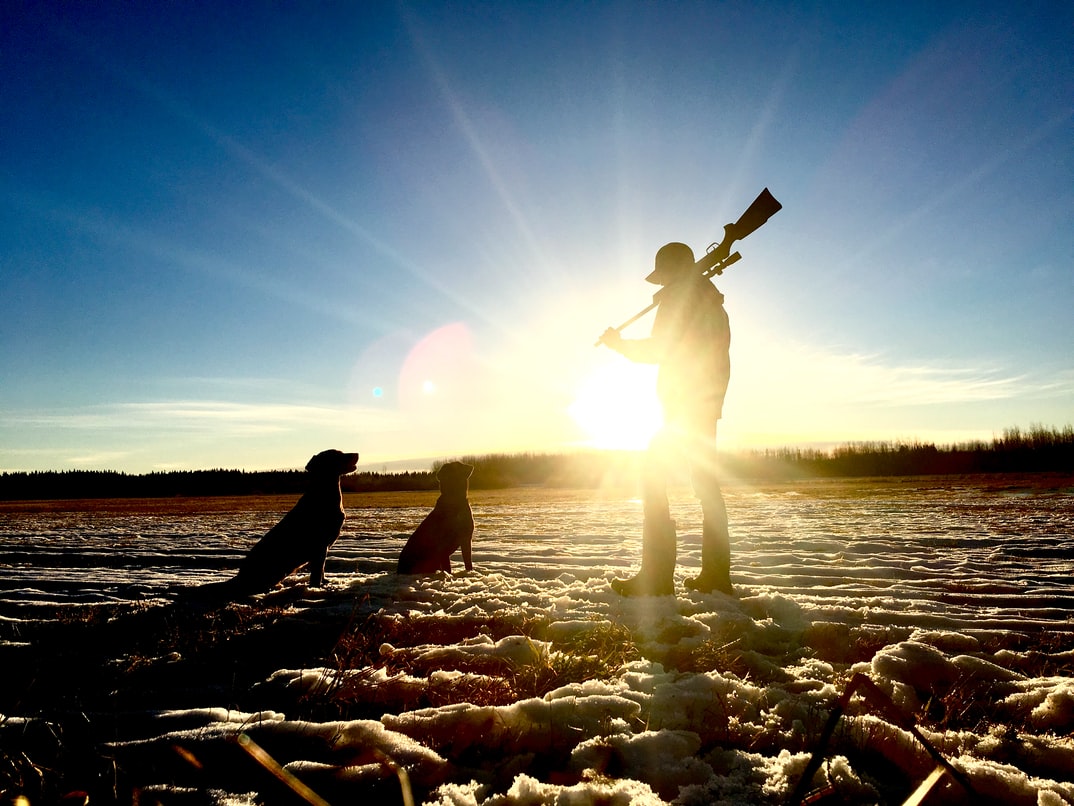
Hunting is a practice of seeking, capturing, and killing wild animals. In general, humans prefer to hunt animals for manufacturing a variety of products that we use in day-to-day life. The fur of various animals can be used to manufacture a lot of overcoats and bedsheets that help people withstand extremely cold climates. Some may hunt for meat, and they use it for preparing food items.
People may have land to grow some crops and vegetables, so animals may surround their land and destroy all the crops, resulting in huge losses. To avoid these losses, landowners prefer to hunt down the animals that destroy their land. So for various reasons, people might hunt the animals. But some may hunt animals to utilize them for various purposes.
Hunting is not an easy task as the hunters must be focused to protect themselves and hunting. To stay focused, hunters should follow some basic criteria and have a proper diet plan. Professional hunters might find it easy to take the required food, but novice hunters may struggle in choosing the appropriate diet plan.
Adding nutrients to your hunting meal is necessary to have sufficient calories which help in staying focused. Make sure to have the food items that are mentioned below. Harrigan Land can help hunters in finding some pro tips on hunting.
8 Best Foods To Pack For Your Hunting Trip
1. homemade jerky.
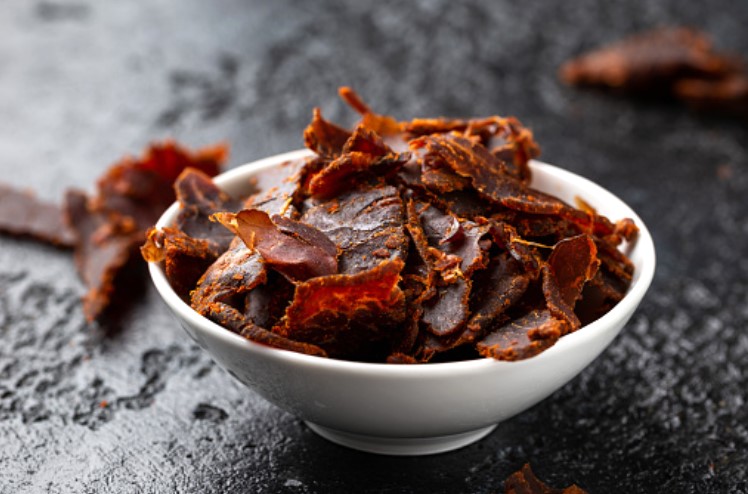
As hunters will be eating food once or twice a day, it is necessary to have food that provides the required calories. So calories can be obtained from any form of meat, especially the homemade jerks that are made by adding a few spoons of oil or butter.
Butter and jerky, when combined together, can provide sufficient calories that can boost your energy instantly. Moreover, jerks will tempt you to hunt more and remind you of the reason for hunting. So homemade jerky is a must to pack for your hunting trip.

Some hunters may prefer to pack some apples or oranges according to the need but chopping down those fruits might become hectic for hunters. So we advise hunters to take some bananas that are rich in potassium and vitamins. Peeling is an easy process compared to chopping, so anyone planning to hunt can prefer taking some bananas to have a healthy meal.
Bananas with some nuts and other items can make you feel better, and it provides the required energy during critical situations. Moreover, hunters might get stuck in a place for more than 5 to 10 hours, so they must have these food items to achieve proper energy.
3. Summer sausage
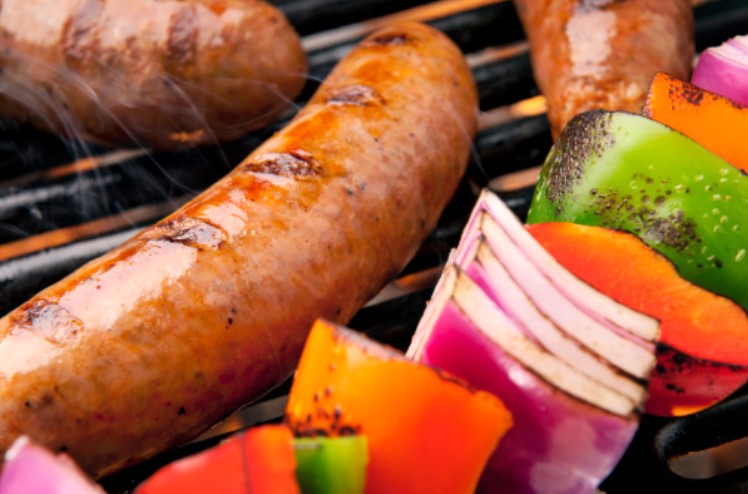
Summer sausage is one of the best alternative foods for jerky because it is the cured form of meat. This cured form of meat is the best evening snack item and is well suited for hunting trips. Even one piece of summer sausage can help hunters in fulfilling the meal. It helps people in getting sufficient energy for more than 7 hours.
So it is a must-carry food for hunting trips. Users can also choose the preferred summer sausage as it is available in various formats. It is rich in proteins and fats that help people stay a long time without having other food items.
4. Protein bars
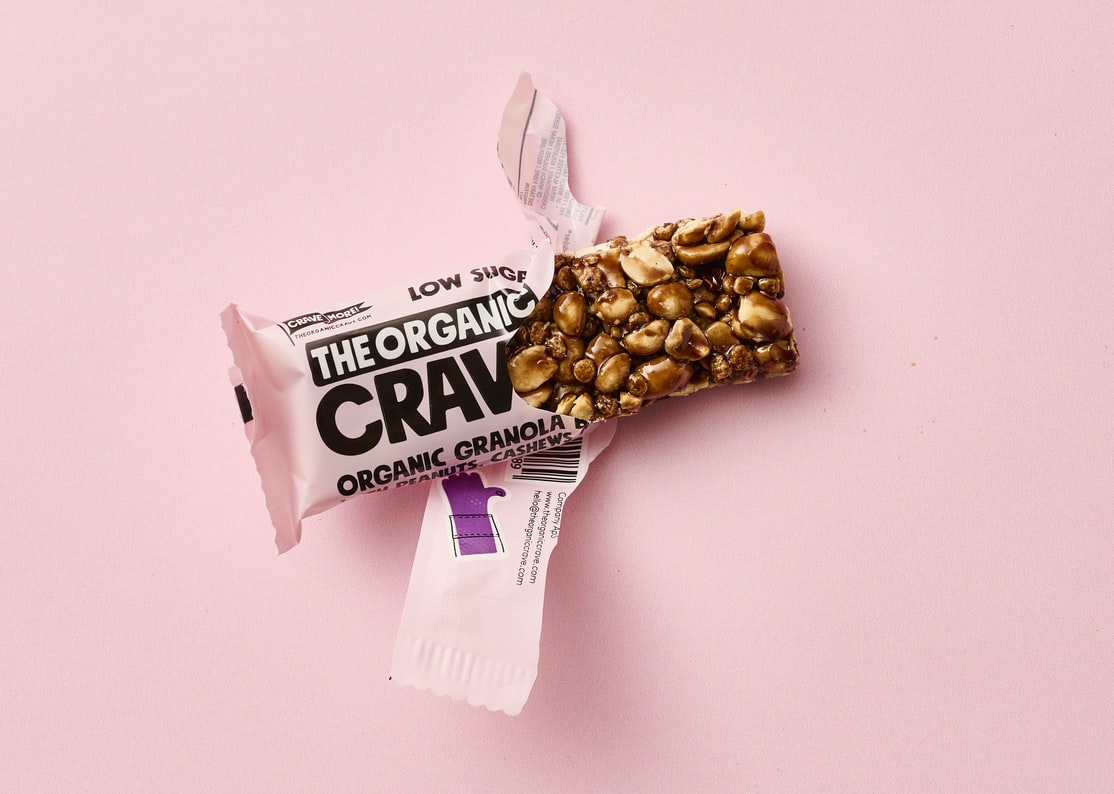
Protein bars like snickers can help hunters stay energetic for a long time. Having a sweet will make you focus better on your hunting trip. Sweets may enhance your mood, which eventually makes you relaxed and stay focused.
Hunters can just remove them from the normal bags and store them in reusable bags to avoid confusion in critical situations.

Most hunters prefer to carry nut mix as it can be carried easily. Nut mixes may look small, but they are rich in proteins, vitamins, minerals and provide instant energy.
The mix may help you in keeping your mind occupied while waiting for a big moment to hunt. But most hunters will store the wastes seeds in bags as it may alert the deers and other animals in the forest.
6. Peanut butter
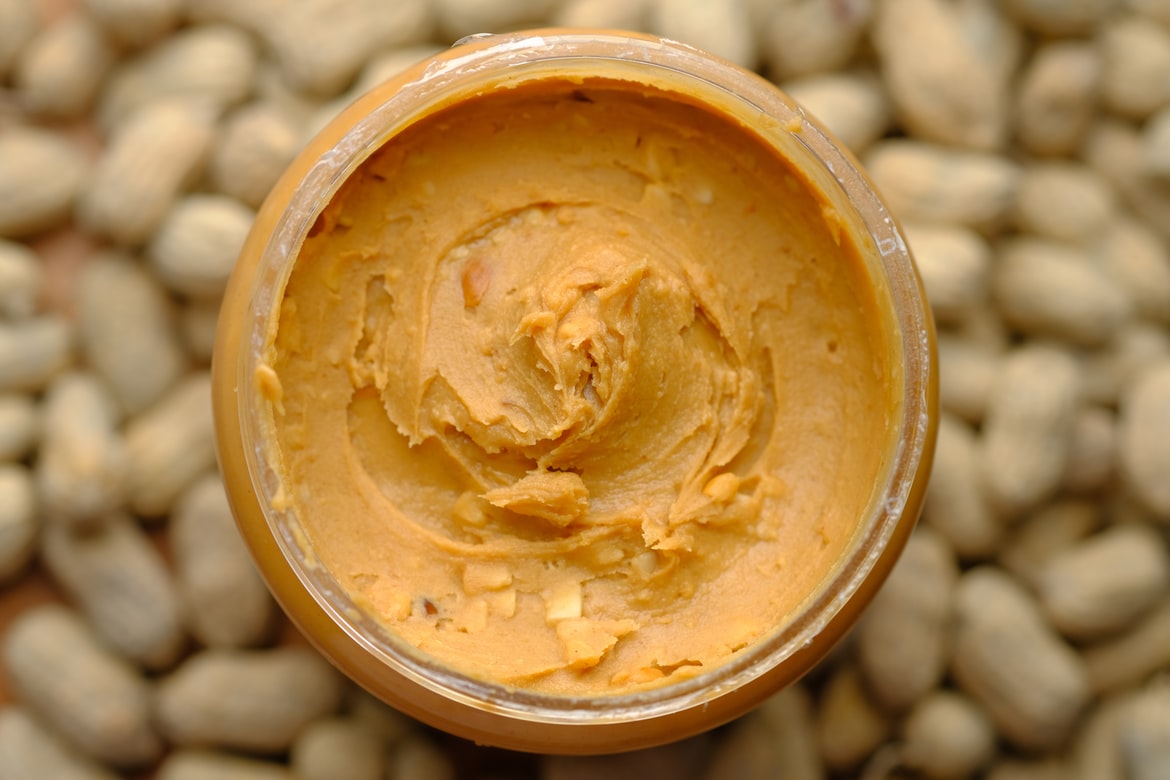
Peanut butter is rich in healthy fats and iron that can provide energy instantly. Peanut butter with bread can be a great combination for hunters. It is rich in proteins, so hunters can use this to stay focused for a long time.
Hunger is one of the critical factors that distract a hunter, so it is necessary to have a proper meal to stay focused for a long time. Peanut butter can provide the required energy, which eventually delays the hunger cycle.
7. Freeze Dried meal
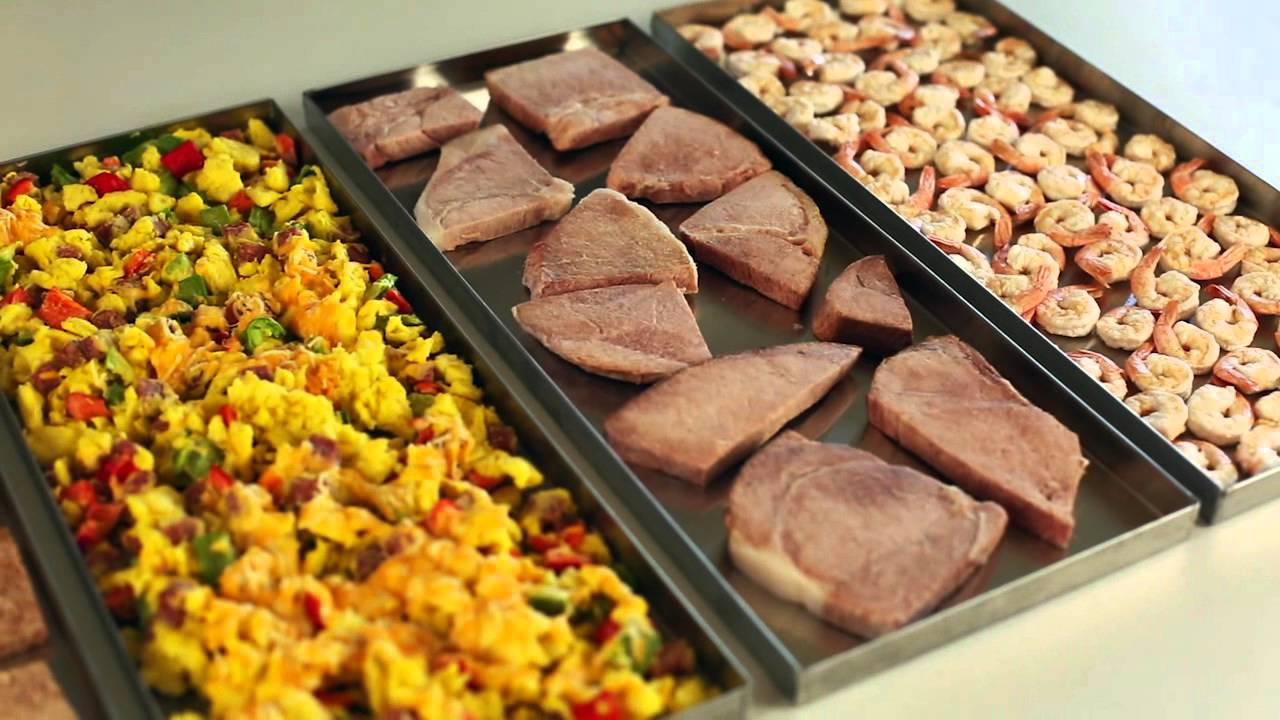
Persons who require high calories can use this freeze-dried meal to avoid vitamin deficiency during the hunting period. Moreover, it avoids the stress of making a meal. So it is one of the best carry foods for hunting trips. It’s just a package that can make you feel fulfilled. Anyone can carry two to three meal bags according to the need.
8. Oatmeal packets

Oatmeal is one of the best foods to pack for a hunting trip. As cooking time is very short, many people prefer to take some oatmeal pockets and cook them using a stove and little water. After cooking the oatmeal, hunters can add some nut toppings and other items that are rich in protein, vitamins, and minerals.
Toppings can help hunters in achieving the required energy, so adding these items to your hunting trip is mandatory.
Final words
As food provides the required energy, it is necessary to choose the right food, especially in hunting. Anyone can choose the preferred food for packing it for their hunting trip. Above mentioned food items are rich in vitamins, minerals and some foods are rich in carbohydrates .
Hunters may prefer choosing a food that is good for their health. Meat, sweet items, and peanut butter can help hunters in staying focused for a long time. So choose the preferred food items according to the need.
What Food to Eat and Drink Based On Your Numerology Reading?
6 reasons why people are moving to north carolina.
Marita Zonena
Related posts, your ultimate italy vacation bucket list (2024), a culinary guide to maui , 6 easy meals to make when you are on vacation, contact us:.
sinisavuk [at] opptrends.com
What to make for a hunting trip?
When preparing for a hunting trip, it’s important to pack nourishing and easy-to-transport meals such as sandwiches, jerky, nuts, dried fruits, and energy bars. Additionally, don’t forget to bring plenty of water and snacks to keep your energy up while out in the field.
What are some lightweight meal options for a hunting trip?
Peanut butter and jelly sandwiches, tuna packets, and dehydrated camping meals are all great lightweight options.

What are some non-perishable snack ideas for a hunting trip?
Trail mix, beef jerky, granola bars, and dried fruit are all great non-perishable snacks to bring on a hunting trip.
How can I stay hydrated while hunting?
Bring a reusable water bottle or hydration pack and consider packing electrolyte tablets to add to your water.
What types of food should I avoid bringing on a hunting trip?
Avoid foods that are messy, require refrigeration, or have a strong odor to avoid attracting unwanted wildlife.
What cooking equipment should I bring for a hunting trip?
A portable stove, cookware, and utensils are essential for cooking meals while on a hunting trip.
What are some quick and easy meal ideas for a hunting trip?
Campfire chili, foil-wrapped potatoes, and canned soup are quick and easy meal options for a hunting trip.
How can I ensure my food stays fresh during a hunting trip?
Pack food in airtight containers or resealable bags and store them in a cooler with ice packs.
What are some hot beverage options for a hunting trip?
Hot cocoa, instant coffee, and tea bags are great options for warming up on a hunting trip.
What should I consider when planning meals for a hunting trip?
Consider the duration of the trip, the number of people, and any dietary restrictions or allergies when planning meals for a hunting trip.
What are some ideas for breakfast on a hunting trip?
Instant oatmeal, breakfast bars, and freeze-dried breakfast skillets are all easy breakfast options for a hunting trip.
How can I avoid attracting animals to my food while hunting?
Store food in bear-resistant containers, hang food from a tree, or use odor-proof storage bags to avoid attracting animals to your food.
What are some options for cooking over a campfire on a hunting trip?
Foil-wrapped meals, skewers for grilling, and cast iron cookware are all great options for cooking over a campfire on a hunting trip.
What snacks can help keep my energy up while hunting?
Mixed nuts, energy bars, and trail mix are all great snacks for maintaining energy levels while hunting.
What should I pack for a multi-day hunting trip?
Pack a variety of meal options, plenty of snacks, and extra food in case of unexpected delays or emergencies. Also, don’t forget to bring a way to purify water.
How can I minimize waste while on a hunting trip?
Choose minimal or no-waste packaging for food, bring reusable utensils and plates, and pack out any trash or waste to leave the environment as you found it.
Related posts:
- Is it illegal to lie about being in the military?
- Is military income taxed?
- Is it illegal to make a copy of a military ID?
- Is military press bad for shoulders?
- Is it illegal to marry for military benefits?
- Is military retirement exempt from federal tax?
About Gary McCloud
Gary is a U.S. ARMY OIF veteran who served in Iraq from 2007 to 2008. He followed in the honored family tradition with his father serving in the U.S. Navy during Vietnam, his brother serving in Afghanistan, and his Grandfather was in the U.S. Army during World War II. Due to his service, Gary received a VA disability rating of 80%. But he still enjoys writing which allows him a creative outlet where he can express his passion for firearms. He is currently single, but is "on the lookout!' So watch out all you eligible females; he may have his eye on you...
Leave a Comment Cancel reply
Save my name, email, and website in this browser for the next time I comment.

COMMENTS
10 Foods to Bring on Your Next Hunting Trip 1. Oatmeal. Oatmeal is the perfect quick-and-easy breakfast for when you just want to get out of camp quickly. All you need is water, a stove, and perhaps some toppings. Dried fruit, nuts, and nut butters are all great additions that will add healthy calories to the first meal of your day. 2.
6. Grilled Backstrap & Potatoes. Sure, it might seem simple. But oftentimes, a simple meal signifies that you, or someone in your hunting camp, have had a successful hunt. Grill the backstraps to medium-rare with your favorite seasoning, bake or fry the potatoes, and enjoy the culinary spoils of the hunt.
Easy Hunting Dinners. Dinner is likely the time when you'll be the hungriest and want to eat the most. These easy hunting dinners will help you load up on calories and keep you feeling full for a long night's rest. Cup Noodles/Ramen. Peanut butter crackers. Summer sausage. Macaroni and cheese.
Throughout the day I eat nuts, cheese, and pepperoni sticks. I also take one 70% dark chocolate bar per day. This setup is very light and compact, since fat is nine calories per gram and protein and carbs are four calories per gram. So, a high-fat meal plan weighs less than half of a carb-based plan.
Beef brisket is another hearty meat that is perfect for a crockpot. Season the brisket with a dry rub or marinade, then let it cook in a crockpot with onions, garlic, and beef broth until it's tender and flavorful. Serve it with a side of roasted vegetables for a complete meal. 3. Chicken Fajitas.
3. Remember to bring enough hunting food but not too much. Regardless of how well you pack, any hunting trip will necessitate bringing many items. As a result, you'll need to be cautious about how much hunting food you get with you. You'll want to carry enough food to last the duration of your trip, but you also don't want to overpack.
Here are a few more scrumptious ideas to keep your hunting camp well-fed: Casserole: Combine ingredients like sausage, eggs, cheese, and bread in a slow cooker overnight for a tasty breakfast casserole. Sloppy Joes: Brown ground beef or venison and mix in a tangy tomato sauce for some classic American comfort food.
Get a good hearty bread and make a sandwich. Cold cuts and cheese keep for awhile and pack easily. Sardines, smoked oysters, cashews, and other high-protein/healthy fat foods will give you energy. Sandwiches are the best camp food there is. Don't forget to throw on some avocado (great source of healthy fat), bell peppers or cucumber slices.
The Best Food To Take Hunting For Your Backpack: 1. Jerky: Jerky is an excellent source of protein and fat-based energy. Each ounce of deer jerky contains roughly 90 calories. It is lightweight and easy to transport in a backpack. 2. Trail Mix: Trail mix is a good source of healthy calories.
Sharp cheddar is the only cheese you need, but if there's fridge or cooler space for more, go with a soft option, like a pimento-cheese spread. Smoked cheeses are disgusting and don't belong ...
Remove the venison from the pot and set aside. In the same pot, add the chopped onion and poblanos, cooking until softened, about 8 minutes. Add the minced garlic and cook for an additional 1 minute. Stir in the chile powder, ground cumin, paprika, and dried oregano. Cook for 1 minute to toast the spices.
Sandwiches (Turkey, Ham, Tuna, or Chicken Salad): Pack sandwich ingredients and bread separately and assemble them at the hunting camp for a quick and easy lunch. Wraps (Chicken Caesar, Veggie, or Turkey and Cheese): Use tortillas instead of bread for a portable and delicious lunch option. Chili and Crackers: Make chili ahead of time and reheat ...
Food. If you're on an extended trip, food will add a significant amount of weight to your pack. It's common to have a pound-and-a-half of food per day you'll be out. ... From backpack sheep hunting adventure stories to DIY tips to gear and gun reviews, he covers it all with a perspective that's based in experience. LATEST IN Big Game ...
Trader Joe's has some delicious and relatively affordable options for backpacking snacks. Here's a list of our go-to trail snacks with links to our favorites: Bars ( Larabar, Clif Bar, ProBar, Ivan Bar, Luna, Kind, Bobo's) Trail Mix. Nuts and Seeds ( Almonds, peanuts, etc.) Dried Fruit ( Mango, Apple, etc.)
For example, an apple has nutrients, but it's relatively heavy and low in calories. It'll take up precious room in your pack and won't help you replace calories as efficiently as other choices. Select foods that are easy to carry and easy to open and eat. 6 Hunting Pack Food Ideas to Keep You Going. Our favorite foods to take hunting include:
It is impractical to sum the calories of all your food items, especially on a longer trip. The more efficient approach is to simply weigh your food. If you assume that your food has an average caloric density of 125 calories/ounce, you would need to carry 18 to 22 ounces of food per day. ... On hunting trips we figure one 'two-person' meal ...
8. Snack Bars. Mtn Ops. Granola bars, protein bars, energy bars: They're all compact and calorie-dense for any hunting trip and intended to be eaten on the go. If you haven't tried the Chocolate Sea Salt RX Bar, move it to the top of your list and thank me later. Another favorite is any flavor Mtn Ops bars. 9.
Foods that can be taken on hunting trips should be easy to carry, lightweight, and high in protein and calories. The most popular diet for hunters is dry fruits and nuts. These are easy to carry along with and do not need any cooking. General Items: Cooking Equipment.
Even if the hunting is great, your camp won't be successful if the food sucks. ... packing and unpacking a kitchen kit before and after each trip can get tedious. Use a heavy-duty storage tote to pack away a set of basic kitchen tools like spoons, spatulas, a can opener, basic seasonings, a roll of aluminum foil, plates, cups, bowls, zip ...
It is essential to select a rifle that matches the size and characteristics of your target species. Some popular rifles for hunting include: .30-06 Springfield: Versatile for big game in North America, such as deer and elk. .308 Winchester: An excellent all-around choice for big game and medium-sized game.
3. Summer sausage. Source: unsplash.com. Summer sausage is one of the best alternative foods for jerky because it is the cured form of meat. This cured form of meat is the best evening snack item and is well suited for hunting trips. Even one piece of summer sausage can help hunters in fulfilling the meal.
What types of food should I avoid bringing on a hunting trip? Avoid foods that are messy, require refrigeration, or have a strong odor to avoid attracting unwanted wildlife. What cooking equipment should I bring for a hunting trip? A portable stove, cookware, and utensils are essential for cooking meals while on a hunting trip.